

How to Write a Character Bio (With Examples!)

If you’re starting a new roleplay (RP) or Tabletop Roleplaying Game (TTRPG), then one of the things you will be expected to provide is a character biography. If you aren’t familiar with writing character bios, then you might be a little stumped on what exactly needs to be included, and what is better left out.
Although there is no perfect, established way of writing a biography for a character, there are a couple of things you could do to make it more effective and useful to your fellow roleplayers and TTRPG players. But first, you should make sure you understand exactly what a character bio entails before writing your own.
This article is specifically about creating character bios for roleplays, tabletop games, and other collaborative writing settings. If you’re looking for how to create a character for a story, try checking out How to Make Characters Interesting, Complex, and Unique instead.
What is a Character Bio?
A character bio, also known as a character profile or character biography, is a brief overview of your character that you can provide to others prior to the start of a game or roleplay. It gives them an introduction to your character before the narrative actually begins, which makes it easier to create plots and interact between characters.
Generally, a character bio includes basic information about the character, such as their name, appearance, and behavior, but it can also include topics such as backstory and motivations. Bios can look different depending on what they are being used for, the genre of the story, and the other players’ preferences.
Why is a Character Bio Important?
Character bios make it much easier for other players or RP partners to get to know your character. By providing information on your character up front, you can allow others to get to know them, build relationships between characters, and come up with ideas for the story based around your character’s information.
In addition to that, having a good character bio can be helpful to reference later, especially if they are part of a long campaign. Bios help keep your characters consistent and true to their original design. Even the best writers forget things about their characters over time, so it’s a good idea to write everything down anyway. When I take notes on my characters, I usually keep the character’s bio at the top of the page and simply add to it as events unfold in the story.
How Long Should a Character Bio Be?
One of the most important things to keep in mind when writing a character bio is that it should be short . You need to keep it clear, concise, and brief. You aren’t trying to give away your character’s life story, after all. You just want to break the ice and introduce them to the other players and characters. After all, if you gave away all their secrets at the beginning, there wouldn’t be any mysteries to uncover over the course of the story.
As a general rule, you should try to keep your character bios shorter than a page (which is typically about 300-500 words). If you make it much shorter than that, you likely wouldn’t be doing your character justice. If you wrote much more than that, however, most people probably wouldn’t get around to reading the whole thing. Character bios aren’t exactly known for being riveting literature.
What to Include in a Character Bio
When you’re writing your character’s bio, you don’t need to create an entire novel about their life and exploits. You only need to include the details that are important for others to know from the beginning. Some things aren’t even important enough to share at all.
Although some people have preferences about the ways they want character bios to be formatted, this is the generally accepted formula for writing a good character bio.
The Most Basic Character Elements
The first thing you should establish in your character’s bio is the most basic elements of who they are. That includes things like their:
- Species (if applicable)
You don’t need to get fancy here. This is the easy part—just give the basic information and move on to the next section.
The Character’s Physical Description

Next, you’ll want to give a basic description of what the character looks like. For this section, you’ll want to consider their:
- Physical details
- Clothing style
You can cover this information in bullet points, but I find that it is much more effective to write this part in paragraph format. That makes the bio feel more like an introduction to the character, and less like some kind of legal document.
If you need some pointers for designing your character, check out Tricks for Describing a Character’s Appearance (With Examples) .
Remember to keep this part brief. Physical appearance is only one small part of a character, and you don’t want to waste too much time and energy describing what they look like—especially since you don’t want their bio to be too long.
The Character’s Personality
Obviously, most of the character’s personality should come out as you are playing them, but it’s still a good idea to give your RP partners or TTRPG players an indication of their personality before the game or RP begins.
As with the other sections, this part should be kept brief. You just want to cover the most important aspects of their personality. You know, the traits and behaviors that define who they are. That could be anything from “grumpy” or “hot-headed” to “innocent” or “creepy.” Just give a few adjectives to describe them, and describe some of their dominant behaviors. This section shouldn’t be any longer than a few sentences.
The Character’s Backstory
This section is the tricky part. You want to explain enough of your character’s backstory to explain how they got where they are in the present day, but you don’t want to give away too much and make your character a completely open book. Not only that, you want to make sure the information you are providing is meaningful to the story, and not just useless facts.
When summarizing the character’s backstory for their bio, you should cut out everything except for the bare bones. The details aren’t important now (and you can reveal more over the course of the story anyway). Instead, draw attention to a few milestones in the character’s life, whether that relates to family, education, tragedy, or something else.
What happened in their past to turn them into the person they are at the beginning of the story? Focus on those points, and leave out all the rest.
If your character doesn’t have much of a backstory yet, you might want to check out this article before moving on: How to Create Compelling Character Backstories .
What Motivates the Character
When you’re creating a bio for a character, you’ll want to consider their motivations and goals. A character without a direction is boring, so make sure you have some idea of what your character wants before the story begins. Do they want to start their own business? Hunt ghosts for a living? Avenge their dead brother? What is going to motivate your character to actually do something ?
This part of the bio is often labeled as “present day,” or it’s lumped in with the backstory section. Regardless of how you choose to format it, the point is worth drawing attention to by itself. This part is particularly important for RPs and TTRPGs because it gives partners and fellow players the context they need to understand how this character operates.
The Character’s Quirks and Flaws
I cannot stress this enough: every character needs to have flaws.
All characters need flaws. No one is perfect, so none of your characters should be either. Even if your character is perfect in one regard, they need to be flawed in some other way. The best sharpshooter in the world might be afraid of snakes. The world’s most mesmerizing dancer might have self-confidence issues.
Quirks are also important! They operate a lot like flaws, though they don’t interfere with the character’s ability to live their life normally. Having a weird sense of humor or a tendency to fidget isn’t necessarily flawed behavior, but it is worth mentioning in this section as well.
Flaws and quirks are indispensable when it comes to creating interesting characters. They create conflict, and make characters more realistic and sympathetic. Without those details, your characters just won’t resonate with other players. Or worse—you’ll get accused of creating a Mary Sue .
If you want more information on creating flaws for characters (and why they’re so important for stories), check out How to Create Complex Flaws for Characters .
Miscellaneous Traits and Abilities
Finally, you’ll probably want to include a miscellaneous category at the end of the bio. Depending on your personal preference and the genre of story you’re creating, this part could also go closer to the top. You could also use a different term, or include this category as part of the character’s basic info.
This is the section in which you include anything important that wasn’t covered in the other sections. This could include things such as the character’s:
- Magical Abilities
- Special Skills
- Languages known
Basically, this section is meant to cover anything else that your RP partners or TTRPG players need to know about your character.
What NOT to include in a Character Bio

That “miscellaneous” category probably has you scratching your head. If that’s supposed to cover the other important parts of your character, how do you know where to stop?
There are many things that you should never include in a character bio, but there are two distinct reasons why things should be left out: either the point is boring and doesn’t matter, or it is much more fun to reveal that particular piece of information over the course of the story instead.
Here are some things that should be left out of character bios because they are uninteresting :
- Their Zodiac sign
- Every single detail of their appearance or personality
- Their entire life story
- Their birthday
- Their entire family tree
- Their favorite food/color/etc
Here are the things that should be left out because they would make good plot points later :
- Their secrets
- Their relationships with other characters
- Their strengths and weaknesses
- Their past trauma or struggles
Character Bio Examples
Character bios don’t have to show off your best writing skills. The point isn’t to impress the pants off the other players, and it’s definitely not to prove you’re a better writer than anyone else. You aren’t showing off, you’re just providing a resource on your character that is necessary for the game or RP.
With that said, here are some examples of character bios to give you a better idea of how to apply all this information.
Sample Character Bio 1
Name: Rory Bannon
Sex/Gender: Male
Species: Human (Superhero)
Superpower: He can float.
Power Drawbacks: He’s not very good at controlling his ability, and it is dependent on his mood. Sometimes, he will begin to float when he gets excited.
Appearance: Rory is tall and lanky, and his limbs almost look too long for his body. He has brown hair with a stripe of orange in the front. He has a goofy smile, and he holds a lot of childish optimism in his sunny green eyes. He always wears a suit no matter where he goes, believing that dressing for success is the first step to achieving it.
Personality: He’s chipper and optimistic, and all his friends agree that he’s a bit of a hopeless romantic. He’s a dreamer, and his head is often stuck in the clouds.
Backstory: Rory is an only child from a loving home. He decided to attend a school for young heroes to learn how to control his powers, with the full support of his doting parents.
Goals: He wants to learn how to control his powers and use them to help others.
Quirks: He’s gotten pretty good at floating up—just not at coming back down again.
Sample Character Bio 2
Name: Alice Howard
Nicknames: Red, Little Red, Pumpkin (by her father)
Sex/Gender: Female
Appearance: Alice is the preppy, pretty girl at school, with a figure that makes boys drool. Her long hair is a gorgeous shade of reddish-brown, and delicate freckles dot her petite, pale features. She is careful to keep her makeup perfect, and she is always pushing the limits of what her school’s dress code allows.
Personality: Despite her looks, Alice is remarkably insecure. She thrives off compliments and bases her entire self-worth on what others think of her. One bad pimple is enough to get her to skip school, and she takes even the smallest insults to heart. Despite how she feels about beauty and her own self-image, she always tries to be uplifting and encouraging to other girls, and would never say anything nasty about the way someone looks.
Backstory: Alice lives with her grandparents since both of her parents are deployed Marines. Her grandparents are getting quite old, and they often require her help more often than she needs them. She does her best to be responsible, but she often regrets that she can’t get out as much as other girls her age.
Goals: Alice has a history of bad relationships. All she wants is a good boyfriend and real friends.
Quirks: She has a tendency to be clingy and physically affectionate with her friends.
Misc: Alice’s one true love is food, specifically greasy, tex-mex food.
Sample Character Bio 3

Name: Samson Anders
Nickname: Sams
Species: Half-human, half-demon
Height: 6’2”
Hair: Long, Brown
Eye Color: Hazel
Skin Color: Medium-light
Physical Details: He has a large scar over the left side of his neck and collarbone, and multiple smaller scars all over.
Personality: Harsh, cold, and unapproachable. He has a softer side for those he cares about.
Past: He isn’t one to talk about his past. Most of his friends know that he had a rough childhood, but no one knows the details.
Present: He is living with a friend in a one-bedroom apartment, and the duo are professional ghost hunters.
Goals: Secretly, he hopes to learn more about his demonic side.
Quirks/Flaws: He tends to grow out his facial hair when he is feeling down, simply because he can’t be bothered to shave.


Character Bio Templates: How To Write & Examples
Whether crafting fiction stories or developing character studies for performance work like theater, detailed character bios bring your protagonists to life by capturing rich backstories, motivations, personalities and defining moments launching their on-page journeys. Compelling character biographies set the stage for fully formed figures audiences relate to.
This guide explores tips for developing multidimensional character bios along with template examples to model helpful starting approaches capturing both critical plot details and resonating personality essences in your own casts. Let’s start by reviewing key elements to include when profiling characters.
Elements to Include in Character Bios
Impactful character biographies encompass:
Backstory Facts
Overview context like date and location of birth, family members and pivotal settings establishing identity and explaining inherent perspectives tied to upbringing. These building blocks lend realism grounding decisions. Share only most relevant lifestage moments contributing to current outlooks.
For example: Grew up as shy middle child on remote 1960s Midwest farm inspiring solitary hobbies like birdwatching and reading.
Vital Statistics
Capture defining physical traits and biographical data helping envision characters through memorable filters establishing cohesive first impressions around age bracket, appearance and more subtleties like speech patterns.
For example: 32 years old, wiry red hair with slight limp from early injury making self-conscious in crowds.
Personality Profile
Showcase 1-3 standout character attributes through demonstrative examples that make your protagonist compelling, quirky or praiseworthy. These memorable personality hooks attract reader investment through relatability, likability or intrigue.
For example: Brutal honesty regardless of social cues frequently gets her trouble yet she can’t resist exposing hypocrisy. Vlad has signature booming laugh immediately distinguishing his presence.
Motivations & Goals
Explore innermost values and ambitions driving your character’s journey. Are they seeking redemption for past wrongdoings or trying attaining career success to support family? Detail complex psychology through emotional wounds, pressing needs and hopes adding depth.
For example: Seeks trailblazing scientific discovery before disease progresses rendering him bedridden like ancestor inventors. Vies being first female taekwondo champion proving petite athletes mighty.
Let’s examine some example character bio templates putting these key dimensions into action across common creative settings.
Character Bio Examples & Templates
Here are five sample character bio templates spanning fiction stories, theater script development and role preparation best practices covering different core focal points:
Fiction Story Character Bio Template
Full name: Cassandra “Cassie” Brianne Jacobs
Birthdate & Zodiac: March 19th, Aries
Physical: 5’2” petite frame, shoulder-length brown curls, hazel eyes
The younger of two daughters, Cassie grew up outside Portland enveloped in Pacific Northwest evergreen wilderness inspiring a vibrant imagination and wonder of natural worlds. Childhood haemophilia curtailed wilderness adventures leading to solitary hobbies of writing fantasy stories set hiking misty forests. Witnessing inequality towards her disabled father despite diligent provision for their family instilled an innate impulse challenging injustice through thoughtful rebellion from youth through college women’s rights protests.
Personality profile
* Champion of human rights & environmental protection
* Habitual journaler processing observations into reflective action
* Temperamental debater quick to challenge faulty logic or oppression
* Enthusiastic laughter breaks tension Showcases both strengths and growth areas
Motivations closing paragraph
Today, Cassie feels restless in unfulfilling admin role yet fears pursuing activist writing career won’t make ends meet. She decides embarking solo camping trip along Oregon coast for clarity on how to interweave world betterment with personal purpose beyond conventional checklist chasing cultural validation she inconsistently desires. But fate has unexpected encounters in store...
Theater Character Biographies Template
Character Name & Vitals
Natalia “Nat” Cresswood 36 years old5’5” lean dancer physique, shoulder-length curly black hair often worn pulled back in messy bun, green eyes peering intensely taking everything in
The middle daughter of three to an affluent Boston investment banker and philanthropic mother, Natalia grew up participating in gymnastics and ballet dancing from age 4. While she demonstrated natural physical gifts starring incompetitive dance troupe performances through adolescence, Natalia felt increasingly creatively confined by strict choreography regiments and passive gender social norms encouraged among her elite social circles. At 19 Natalia moved to NYC to pursue commercial dancing career and avant garde performances allowing embracing her feminist, queer identity.
Personality & Quirks
* Signature move involves spinning from floor into powerful stance signifying empowerment
* Communicates through spare, precise language and sustained eye contact
* Habitually observes her surroundings before entering new spaces
* Fidgets hands when frustrated suggestive of restricted inner voice
Goals for This Story
Having sacrificed artistic fulfillment the past 10 years for commercial stability paying bills, Natalia realizes sculpting empowerment stage work fusing dance, music and monologues must take priority now before time passes by. But reconciling lingering internalized social expectations around women’s “proper place” remains Natalia’s hidden conflict throughout her visionary choreographic journey.
Method Acting Character Background Exercise
Character basics
Full name: Jonathan “Johnny” Mikeal Vincent
Age & DOB: 43 - January 18th 1980
Physical: 5’10” muscular builder’s frame, close cropped salt & pepper hair with soul patch, hazel eyes
Origins & Upbringing
Born in working class Boston neighborhood, Johnny grew up youngest of 5 children stretched thin by his father’s meager construction wages. Witnessing his overwhelmed parents’ arguments over tight budgets and bringing up 5 kids persevering through scarce means imprinted practical resourcefulness and protective loyalty towards family from young age. Streetfights defending younger siblings also molded reflexive physicality meeting perceived threats with force versus diplomacy - qualities that both served and hindered future dealings rising ranks of local crews.
Personality Qualities
* Brash boldness asserting needs without hesitation
* Observant assessing surroundings before acting
* Generous providing for inner circle no questions spared
* Temper simmers erupting if boundaries crossed
Present Day Motives
Now a rising lieutenant managing illegal arms trade bypassing moral discomfort by rationalizing providing for family above all. Yet Johnny’s protective loyalty gets tested through unforeseen medical crisis forcing reflection on how far he’ll go for kin, crew and his own legacy.
Mix and match components from these templates to build rich multidimensional character biographies fueling vibrant personalities advancing your creative storylines or performances.
Tips for Crafting Standout Character Bios
Beyond covering the core factual and personality elements in your character profiles, apply these additional writing best practices:
1. Uncover defining Epiphany Moments - Explore when your character’s worldview or approach shifted through pivotal interactions altering their place (e.g. first heartbreak, missed promotion, act of betrayal) then map effects on current perspective.
2. Ask probing Questions - What does your character dread most? Dream of late at night? These emotional drivers shape reactions.
3. Contrast Public vs Private Selves - We all portray polished public personas hiding trickier private truths. Expose both along with what formed each.
4. Leave Mysteries - Avoid overdetailing every past moment that defined them. Allow pockets of ambiguity leaving gaps to fill in later keeping intrigue high.
With robust profiles assembled for your leads, supporting roles and antagonists, let’s go over some FAQs on applying character bios improving creative development across different mediums:
Character Bio FAQs
Here are answers to common questions around leveraging rich character biographies to enhance storytelling potency:
Do novels require character bios?
While not mandatory, crafting detailed character profiles outlining backstories, motivations, personalities and pivotal moments often allows authors tighter continuity referencing these key origin details subtly dropping them through dialogue, narration foreshadowing and dramatic irony. Keep bios handy avoiding uneven character shifts.
How do actors use character biographies?
Performers heavily reference developed character bios and backstories to assume roles more immersively through informed emotional connection versus surface reciting of lines. Bios prompt harnessing personas psychologically manifesting authentic expressions, reactions, mannerisms aligned to complex figures crafted through writing phases.
Can you reuse character bios across multiple stories?
While core human psyche chronicling transferable personality types and motivational scenarios applies across fictional mediums, reinvent character bios customized aligning backstories, growth arcs and role details to each storyline’s unique setting and journey to retain authentic freshness avoiding recycled caricatures. Each story deserves wholly original casts.
Do graphic novels require detailed character bios early on?
Visual novelists can reference abbreviated character profiles covering formative memories, key attributes and story goals guiding illustration development translating writing notes into consistent graphic panels showcasing tangible personalities emerging through imagery, action and dialogue. Expanded textual bios help inform ongoing narrative strides.
Robust, thoughtful character profiles translate into richer, more relatable leads engaging audience investment through complex facets, agonies and triumphs mirroring human condition. Immerse in their world to share impactful stories.
Now that you grasp the core components of resonant character biographies and how to leverage them improving your creative process, let's briefly spotlight a few historical examples demonstrating powerful essence-capturing personas:
Examples of Compelling Character Bios
Anna Karenina - Anna suffers ongoing identity crisis straddling refined aristocratic expectations, maternal ambivalence and impassioned yearning for uninhibited romantic transcendence ultimately ending her life by suicide. Complex dimensionality intrigues.
Tom Sawyer - Clever schemer skilled at winning friends through imagination and charm yet haunted by lingering orphan heartache seeking worldstage validation outshadowing humble beginnings. Celebritized psyche timelessly relatable.
As these classic protagonists epitomize, detailed rendered biographies manifesting signature psyche facets, wounds and worldviews lie at the heart of artistic legacies spanning generations. Dive deep conjuring your cast’s complete essence through biography.
How to Use Just Think AI for Character Bio Templates
Just Think AI makes creating compelling character bios easy. Here are tips:
- Share key details about the character - name, age, personality traits, background, abilities etc.
- Provide the story genre and setting details as context
- Indicate if the character is a protagonist, antagonist, supporting role etc.
- Specify any unique attributes, quirks, or details to highlight
With this information, Just Think AI can generate a customized character bio template covering their history, physical description, personality overview and role details in an engaging narrative style.
Just Think AI Prompts for Character Bio Templates
When requesting a character bio template from Just Think AI, provide:
- Character details - name, age, descriptors, abilities etc.
- Genre and setting the character exists within
- Character role in the story
- Any special attributes or details about the character
Supplying this context allows Just Think AI to draft an effective character bio template bringing your creation to life!
Let Just Think AI handle the busywork of composing compelling character bios so you can focus on developing captivating stories!

The Best Original Character Bio Template (250+ Traits Info Sheet)
August 17, 2023
The best character template to help you include traits you would never consider. Even expert OC designers can't figure out all the details without some prompting!

Do you have an OC you’re making and want to build your character up? We got you covered!
There are many different approaches to character creation! Using a character sheet can help your character feel more well-rounded.
Even experienced character designers can't keep all the character details without some prompting! This original character template can help include key motivations, background info, and traits that you would never consider.

How To Use This Free Character Template
Whether you're a pro or just starting out, this character info sheet will help you develop your character!
The best way to use this template is to start with the basics. Don't feel like you have to fill everything out. That's too much! The goal is to use these traits and prompts to brainstorm.
You can also post your OC to CharacterHub ! On CharacterHub, these prompts are built in. The tool helps you brainstorm and keep track of all your characters and worlds. Once you post your character, you can get feedback from the community, meet other OC creators, and share art and stories!
Original Character Sheet:
Basic info:.
- Date of Birth
- Time of Birh
- Place of Birth
- Gender/Pronouns
- Relationship
- General Appearance (physical features, style, etc.)
- General Personality (positive and negative traits)
- Weaknesses
Physical Traits + Appearance:
- Facial Hair
- Specific Features
- Facial Features
- Dominant Hand
- Flexibility
- Body temperature
- Teeth (straight, crooked, missing)
- Voice (pitch, pacing, etc.)
- Sense of fashion and style
- Health (disabilities, illnesses, conditions)
Other Characteristics
- Languages Spoken
- Personality Type
- Cultural Background
- Speech Patterns
- Most Used Phrases/Words
- Habits (good and bad)
- Intelligence
- Sense of humor
- Problem-solving skills
- Emotional Intelligence
- Introverted or extroverted?
- Lucky Number
- Most Treasured Possession
- Dietary Preferences
- Signature Scent
- First Emergency Contact
- Bucket list
- Morning Routine
- Unique Skill
- Sleeping habits
- Political views
- Core Values
- Beliefs about morality and ethics
- Beliefs about happiness and success
- Beliefs about the world and society
- Stance on social issues
- Personal Philosophy
- Self-perception
- Optimism vs. Pessimism
Motivations:
- Darkest Secret
- Biggest Dream
- Deepest fear
- Inner Conflict
- External Conflict
- External Pressures
- Insecurities
- Worst nightmares

Relationships:
- Significant Other
- Family (and family dynamics)
- Birth order:
- Co-workers/Professional Relationships
- Mentors/Mentees
- Past Romances
- Best Friends
- Close Friends
- Acquaintances
- Strained Relationships
- Supportive Relationships
- Toxic Relationships
- Role Models
- Most important relationship
- What do they like about their relationships?
- What do they wish could be improved about their relationships?
- Special Powers
- Supernatural Abilities
- Fighting Style
- Physical Strength/Endurance
- Persuasion Ability
- Survival Skills
- Spiritual Abilities
- Technology Skills
Entertainment:
- Online usernames
- Social Media Usage
- Technology Usage
- Followers/Following
- Favorite Apps
- Communities Apart Of
- Favorite forms of entertainment
- Favorite movies
- Favorite TV shows
- Favorite games
- Favorite book
- Favorite outdoor activities
- Celebrity Crush
- Comfort Food or Activity
- Dream Vacation Destination
- Places they've been to
- Indoor activities
- Outdoor activities
Other Favorites
- Favorite food
- Favorite drink
- Favorite place
- Favorite animal
- Favorite color
- Favorite song
- Favorite Quote
- Favorite band
- Favorite sports team
- Favorite brand
- Favorite store
- Favorite thing to do
- Favorite weather
- Favorite season
- Favorite holiday
- Favorite mythical creature
- Favorite joke
- Favortie smell
- Favorite sound
- Favortie Time of Day
- Favorite Historical Period
- Favorite Superhero
- Favorite Villain
Professional Traits:
- Income Level
- Volunteering
- Professional Goals
- Professional Reputation
- Career Challenges
- Professional Skills
- Feelings about job
- Feelings about co-workers
- Personal history (childhood, past events, etc.)
- Social class
- Criminal Record
- Notable life events
- Accomplishments
- Key Memories
- Childhood influences
- Childhood Ambition
- Major life decisions
- First Heartbreak
- Life Lessons
- Cherishable Moments
- Major Failures
- Most embarrassing moment
- Most meaningful possession
- Most difficult decision
- Favorite memory
- Least Favorite Memory
Fandom (if the character lives in a fan universe):
- Is this character part of an existing fandom or universe?
- How does this character relate to the canon world?
- Are there any notable relationships to that universe?
- What special powers (if any) do they have from that universe?
- Have they influenced history in any way?
- Do they have any notable accomplishments within the universe?
- What are their roles and responsibilities?
Character Development Questions:
- How does your character handle conflict and difficult situations?
- How does your character relate to others and form relationships?
- How do your character's personality and actions change in different environments and social circles?
- How did your character's childhood shape their personality and worldview?
- How does your character cope with their emotions and vulnerabilities?
- Why does your character make the choices they do and what motivates them?
- How has your character's personality changed over the years?
- How does your character handle success or achievement?
- If your character could have any superpower, what would it be and why?
- If your character could travel through time, where and when would they go?
- If your character could have any famous person as their mentor or role model, who would they choose and why?
- If your character could have any one wish granted, what would it be and why?
Roleplay Details (for a character roleplay bio):
- Types of characters this character interacts best with
- How the character’s personality ideally evolves in a roleplay
- Roleplay role (is this character typically a protagonist? Antagonist? Supporting character?)
- Common starters: prompts or starter stories that fit this character well
Other Character Profile Template Tips:
- Write journal entries as your characters. This helps you think as your character, making them feel more realistic. The Posts function on CharacterHub is good for this.
- Map out your character arc. Characters need to develop over the course of your story! After filling out these details, outline what the character learns and the emotional development the character goes through.
- Practice writing about your character . Pick another character in your universe. Write about them as another character to get a more comprehensive view of the character. Answering writing prompts can help you brainstorm.
- Use the character template even if you won’t utilize all the traits . Knowing everything about a character helps them feel more real, regardless of if you ever use specific details. The information from the character info sheet can slightly alter how they react, respond, or behave in ways that aren’t tangible.
Creating Characters on CharacterHub
No need to store your OC Character Sheets in Google Doc anymore! CharacterHub provides simple tools to help you brainstorm and keep track of all your characters and worlds! Post characters, build an audience, get fan art, and store everything. You can find it all on CharacterHub ! It like combining all reference sheets, notes, templates and character info sheets into one!

Table of Contents
Share on social, unlock your character's full potential, join characterhub for exclusive access to revolutionary character-building tools and a like-minded community.

What is a Kinsona?

What Is A Round Character? Explanation, Examples, and How To Make One!

What Is A Flat Character? Explanation, Examples, and How To Avoid It!

Wait! Do you love creating characters?
On CharacterHub, you can create detailed character profiles, share their art and story, and organize all of your OCs! Join CharacterHub and bring your characters to life today!
The Ultimate Character Bio Template: 200 Character Development Questions

A character bio template is a shortcut for developing realistic characters. It’s the key to creating believable protagonists and antagonists that come alive through your writing. Character bio templates include guiding questions to help you shape your main characters as you write.
Remember: writing great fiction starts with writing great characters!
By answering significant questions about your character’s development, not only will you be able to understand a character inside and out, but you’ll also be able to show your readers the depth of your character.
Creating life-like characters goes beyond just plopping your character into the storyline, giving them a name, and describing a few traits.
And it’s not just for fiction – but for non-fiction , too. Are you writing a memoir? A biography? A self-help book using “case studies” or examples of people in particular situations? Experimenting with creative writing prompts ?
You’ll want to fill out a character bio template for your main character if you’re writing one of these non-fiction books as well!
Even if your character is modeled after a real person, that’s not enough to make him or her come alive for the reader. As an aspiring author , the first rule of thumb is to fully develop your character. You need to create an individual with a story of their own that readers want to engage and connect with as they read your book.
Your character’s development should not be an afterthought – after all, you’re telling a story, and the story likely centers around the characters.
Invest the time to answer these questions in our character bio template, and you’ll see just how real your character will become.
Get The Free Character Sheet!
Unlock Your Character's Full Potential with Our Free Character Sheet.
What is a character bio?
A character bio is a document or template that outlines the biography of a character in a story. Commonly used in the form of a character sheet template, which includes in-depth questions that highlight the character’s traits , descriptions, and journey, the character bio is used as a resource for the writer’s reference.
A character bio template helps the writer keep track of the character’s arc, background, and preferences which then helps the reader understand the character’s dynamics through the story. By creating a character with a past, present, and future, storytellers are able to paint a vivid picture of the character’s behavior and actions as displayed in the story.
The main goal of using a character profile template is to increase the realistic attributes of the character, to ultimately make them more believable and relatable for the reader.
Character bio templates are used mainly by fiction writers and authors, screenwriters, and other storytellers. Character profile templates should be filled out for all main characters in the story, including antagonists, to improve the overall character development.
Why is character development important?
Character development is important because the more developed a character is, the more realistic the character is – and readers want to invest in characters that are believable.
Have you ever been so connected to a book or story that you were devastated when you finished reading it? You were sad to say goodbye to the characters. You wished you could open up the portal to that world forever.
If you’ve experienced that, then you were emotionally invested in the characters and their lives. You connected with them – you felt like you truly knew them. And that’s because the writer did such a phenomenal job developing the character, that they seemed real to you as the reader.
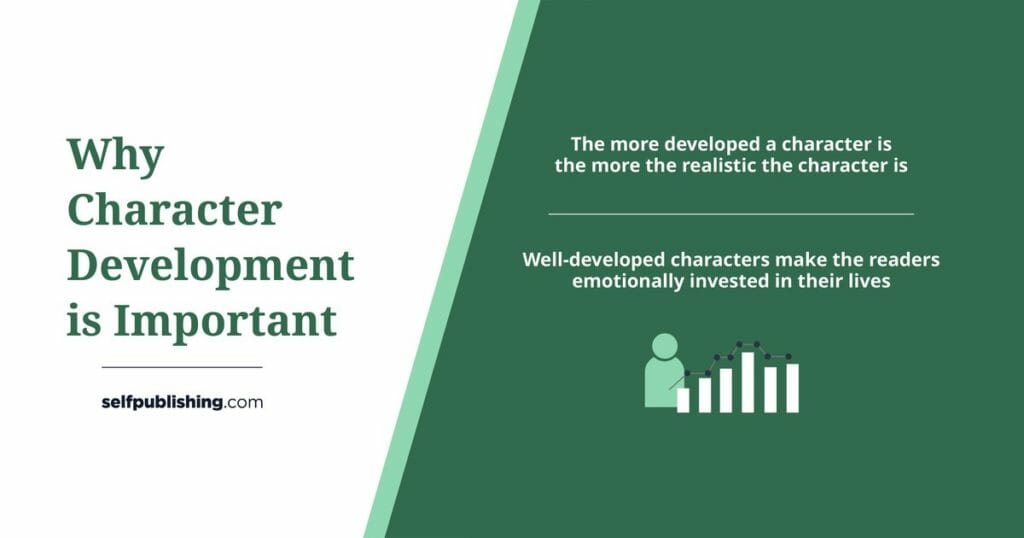
That’s exactly what you want to do with your own writing. You want to write characters that are so fully developed, the reader will become invested in their lives.
And the secret to fully developing characters lies in being able to answer detailed questions about your character, which is how this character bio template will help you.
Top character development tips to use when writing:
- Start with a mind map or outline of your character’s journey in the story.
- Brainstorm the character’s main characteristics as needed for the story’s plot.
- Practice writing about your character to get a solid idea of who the character is.
- Give your character a main goal, purpose, motivation, and flaw.
- Fill out the character bio template to fill in any gaps and get clear on their history and small details.
- Interview your character to build their perspective.
- Complete writing exercises from your character’s perspective to fully develop the character’s mindset.
- Begin writing your story with your fully developed character in mind.
Why should you use a character bio template?
Using a character bio template will help you create realistic characters that your readers will believe in, and connect with.
You should develop a character bio to create believable characters for two reasons.
First, by answering character development questions in a character profile template, you’ll know the character like the back of your hand, which helps you tell your story better.
Second, the character sheet template will help you create an actual individual by painting a comprehensive, detailed picture of who they are – from what they look like to their personality quirks to their biggest mistakes in life.
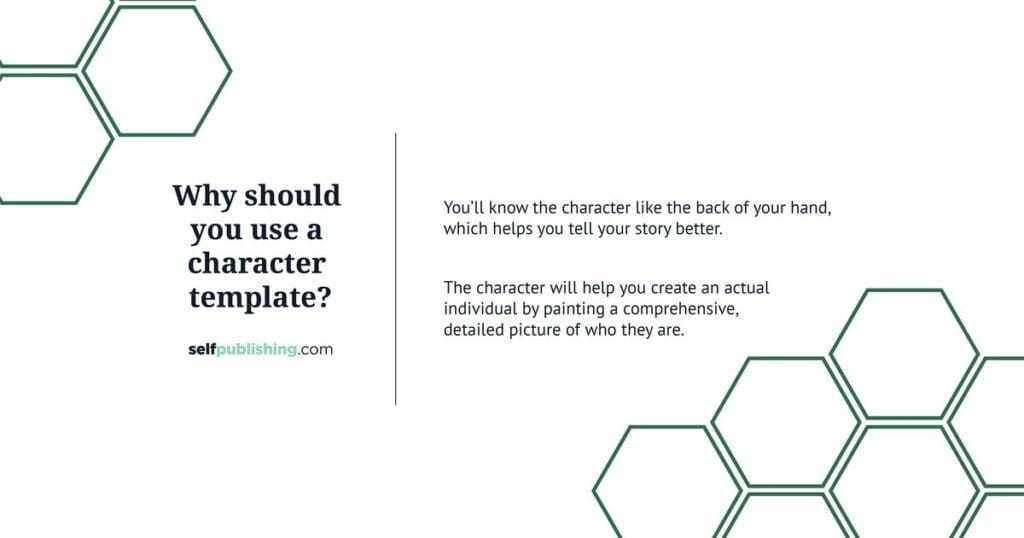
Reasons to use a character bio template:
- To help you tell your story better
- To prevent inconsistencies in details
- To create a life-like character, full of personality with a comprehensive living history
- To use as a reference when incorporating details about your character
- To improve your character’s development
- To help readers connect and relate to your character
- To immerse your reader in your story
What should a character profile include?
A character profile template should include all of the relevant details that the writer needs to incorporate into the story, to fully develop the character.
Some writers use a basic character bio, with only relevant details that show the character’s arc within the story, while other writers use an advanced, comprehensive character bio with specific details about the character’s life, personality, aspirations, and internal and external features.
The type of character profile you include will depend on several factors, such as the type of work you are creating (ex: novel, short story, film), and the type of writer you are (ex: do you need a comprehensive profile, or just a one-page summary?). At a minimum, you should include the specific details about your character that highlight his or her role in the story, and how they develop within your story.
What to include in your character profile template:
- Character basics such as name and age
- Physical description of the character’s appearance
- The personality traits of the character
- Overview of the character’s health
- Career and education details
- Preferences and motivations of the character
- Description of the character’s family life
- Overview of the character’s main relationships
- Important life stages and milestones
- Character perspectives, outlook, and opinions
- Character’s role in the story’s development
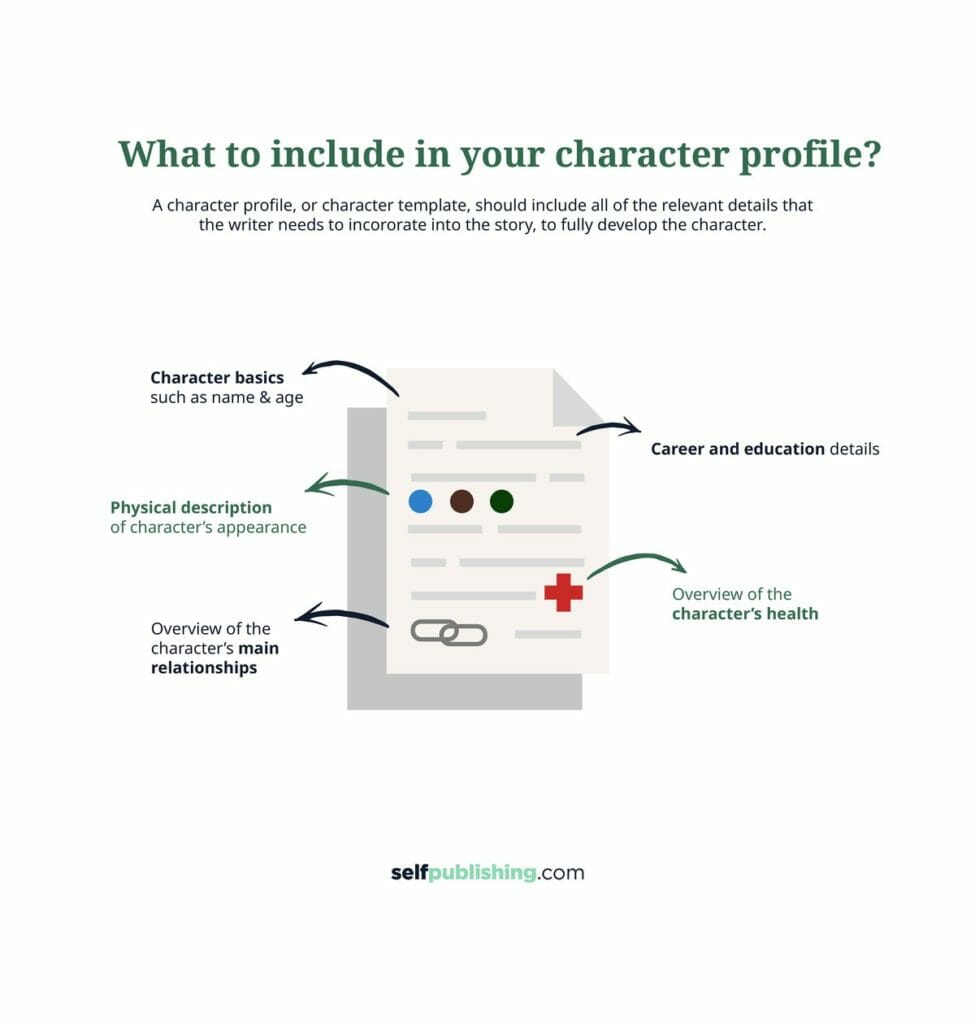
How to use this character bio template
This particular character bio template is comprehensive, and designed to be used as an in-depth resource with more advanced character development questions. Novel and short story writers will benefit from this character sheet template to create a full character bio.
Fill this template out fully for each of your main characters (protagonist and antagonist), and use the sheet as a reference for your writing.
Click here to jump to the Character Template!
It’s best to complete the character bio template once you have your story’s outline, but before you actually start writing your rough draft. If you’ve already started writing your rough draft, that’s okay – you can still use this character bio template and it will be helpful as you edit and complete your draft.
Read this article if you want to learn more about how to write a book outline .
How to use a character bio template to improve your character’s development:
- Start with a good idea of your character’s creation , like who they are and what their purpose is in your story.
- Know your character’s flaws , motivation, main goal, and purpose.
- Begin filling out the basic section in your character bio template.
- Get clear on the physical descriptors of your character.
- Fill out health section of the character bio template.
- Next, build out your character’s career details .
- Think about what your character prefers .
- Dig into the family history in the character’s bio.
- Then, move on to the relationships section of the template.
- Narrow down your character’s main life stages .
- Develop the character’s perspectives and views of the world.
- Next, build the character’s story development .
- Review the full character bio template to make sure every detail connects, and that there are not any inconsistencies.
- Practice writing from your character’s perspective to get a natural feel for the way your character thinks and acts.
- Practice writing about your character from different perspectives (as a narrator, as a friend/lover/enemy of the character).
- Repeat all the above steps for any major characters in your story.
- Reference your completed character bio template as you begin writing.
Following the tips above will help you to develop a realistic character that readers will be invested in.
Don’t just share this character bio template directly with your reader – it is meant to be a complete guide for you as you write about who your character is, and how he or she affects the story.
This character bio template serves as a skeleton for developing a realistic character, so you should be able to answer each question. You need to be able to answer everything about your character, but your reader only needs to know the details that help tell the story.
These character development questions are comprehensive, so this doesn’t mean you need to tell your reader everything about your character. Only give your reader what they need to know about your character as it pertains to your story.
If you’re writing a genre or story that requires more questions, feel free to add more as you see fit! For example, if you’re writing a sci-fi novel, maybe you need to answer more questions about your character’s species, or the special powers that they possess.
As you write, you’ll want to have a copy of your completed character bio template nearby so it can be retrieved easily and referenced. This will help you tell your story more accurately, by avoiding little mistakes or inconsistencies in your plot and story setting .
For example, let’s say you start the story by describing your character as a vegetarian, but later on have your character order a hamburger at a restaurant. This is a detail that many engaged readers will notice!
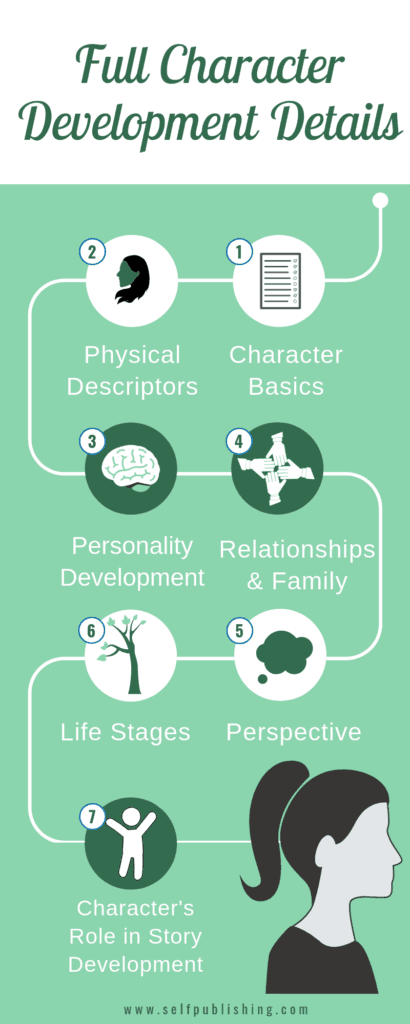
Tips for using this character bio template in your writing:
- Complete the character bio after your outline is completed. Start filling out the character bio sheet after you complete your story outline , but before you start fully writing your chapters. This will ensure you have a solid idea of what details make sense based on your story’s main events, but still gives you the opportunity to incorporate the small details into your actual story.
- Use the character template as a reference guide when writing. Don’t just fill out the template and share it with your readers. This exercise is meant for you, as the author, so that you can fully develop all the intricacies of your character, and incorporate relevant details to shape who your character is, and their purpose in the story.
- Don’t skip any questions that can be answered. Answer as many questions about your character as possible. Obviously, if a question does not apply to your character (like if they are a child and do not have any past relationships), skip it. But don’t avoid questions simply because you don’t want to think. Cutting corners in this way will reflect in your character’s development.
- Only give your reader what they need to know when you’re writing. Just because you answer every question in the character development sheet, doesn’t mean that your reader needs to know all of those details. Only give what’s necessary, and what will help your reader understand your character better.
- Add more questions as needed. This character bio template is meant to be a starting point for you. If you need to add more questions, do so, especially if you’re writing a genre like hard science fiction where your characters are non-human.
- Think about the small details. Once you start writing, the character bio template will bring value to your dialogue , scene setting, and plot. Don’t be afraid to focus on the small details.
200 questions for your character bio template
Here are the questions you should answer about your character in order to bring them to life:
Character bio template basics
Begin by answering these basic questions about your character. These character development questions are the surface-level facts that you can use to start building your character.
These are the essential facts to fill out for your character, such as name, birthday, race, gender, etc. This section should be particularly quick for you to fill out since you most likely know all of these details for your character already. These questions help show your character’s development on a surface level.

These are the basic questions for your character bio template:
- What is your character’s name?:
- Do they have any nicknames?:
- What is the meaning/significance of their name?:
- What is the character’s gender?:
- How old are they?:
- When is their birthday?:
- Do they have a death day?:
- What is their zodiac sign?:
- Where do they live?:
- Where were they born?:
- What is their ethnicity?:
- What is their nationality?:
- What is their race/species?:
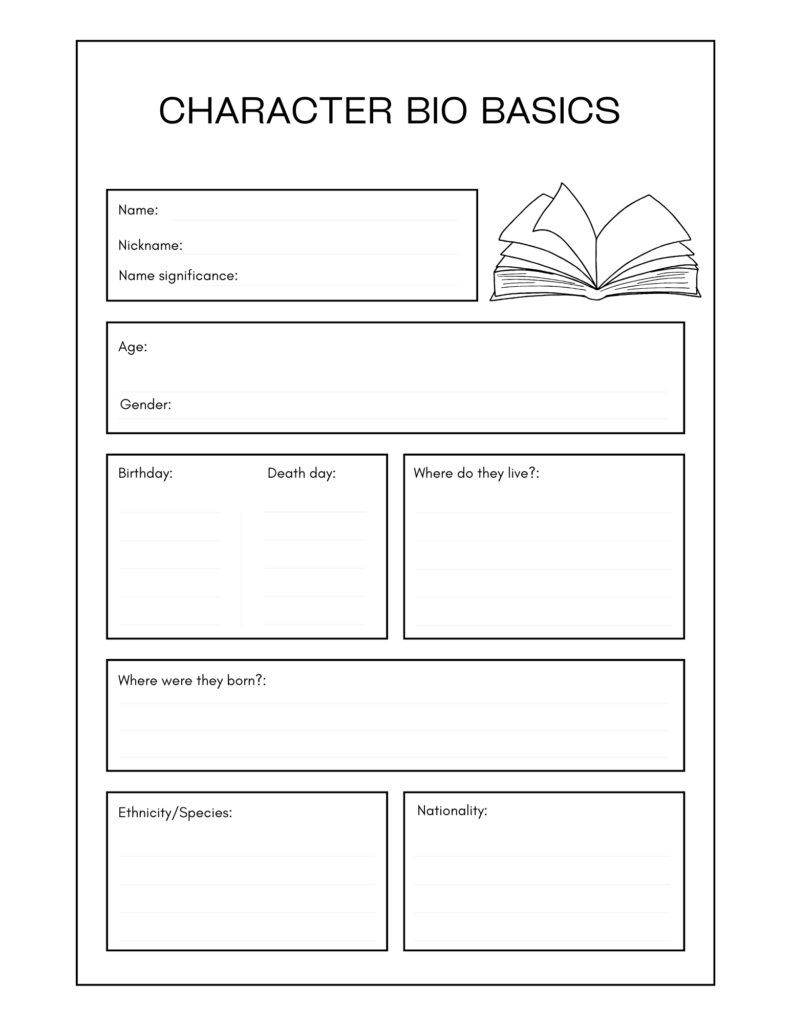
Physical descriptors
Now you can start building out your character’s physical appearance. These are external questions that will paint a physical description, so your reader can envision what your character looks like.
The physical attributes for your character bio template are important because they will also help you write vivid descriptions and actions in your book.
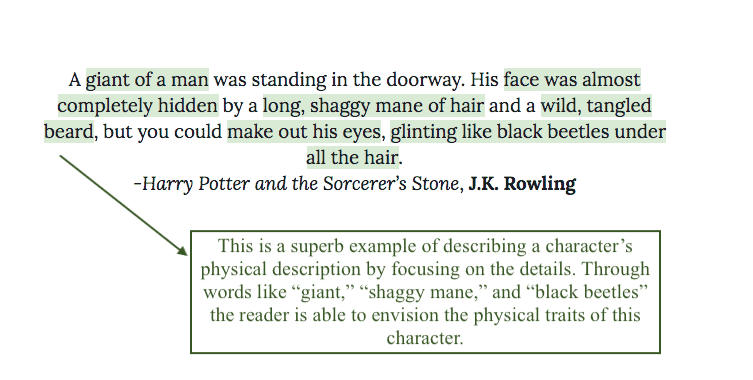
These are the physical appearance questions for the character bio template:
14. What is their physical appearance?:
15. What is their skin tone?:
16. What is their complexion?:
17. What is their natural hair color?:
18. What is their height?:
19. What is their weight?:
20. What is their body type?:
21. What is their build?:
22. How is your character’s posture?:
23. Do they have any birthmarks?: 24. Do they have any scars?:
25. Which is their dominant hand?:
26. What age does the character appear to others?:
27. Do they have a dyed hair color?:
28. What is their usual hairstyle?:
29. Do they have any tattoos? What is the meaning behind them?:
30. Do they have any piercings?
31. What is their makeup style (if any)?:
32. What is their clothing style?:
33. What is their clothing size?:
34. What is their shoe style?:
35. What is their shoe size?:
36. How is the appearance of their nails?:
37. How are their eyebrows shaped?:
38. What do their facial features look like?:
39. What is the character’s face shape?:
40. Do they have facial hair?:
41. What does their voice sound like?:
42. What distinguishing feature about them do people notice right away?:
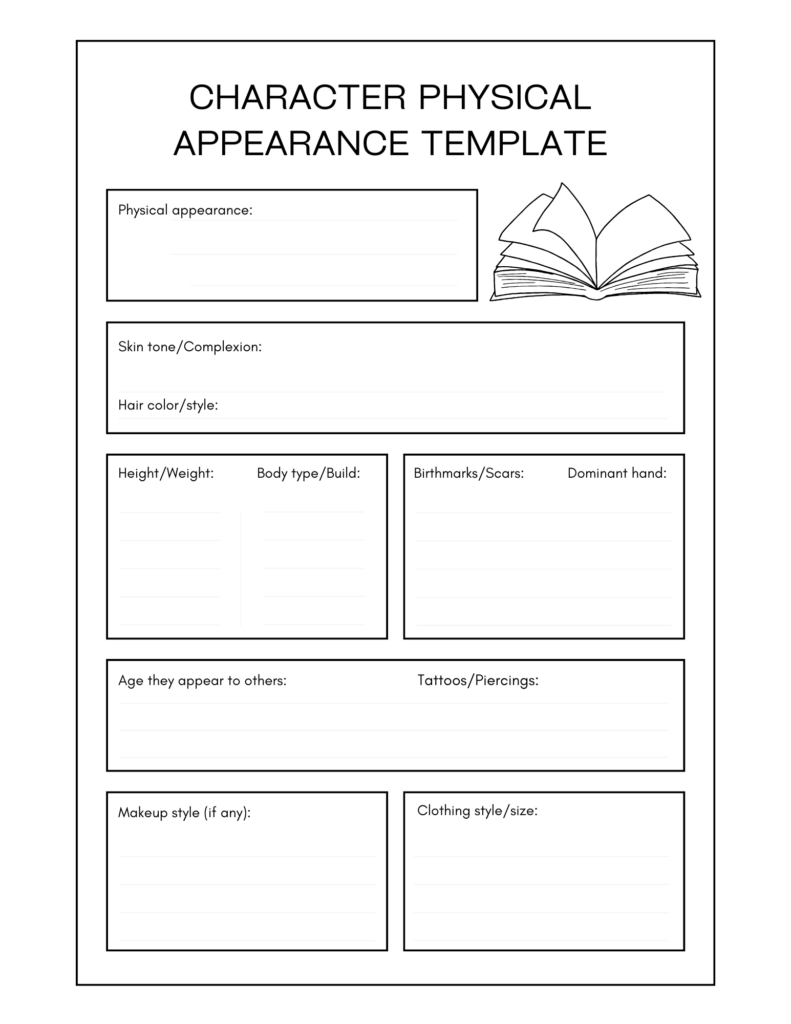
The character’s personality
Now it’s time to start scratching beneath the surface to better understand the type of personality the character has. These character development questions focus on describing the personality traits within the character’s demeanor as they are in the present time of the story.
For example, most people who are naturally introverts will always be introverts. But, maybe your introverted character has only recently developed a habit of talking to people on the subway as they commute to work every day.
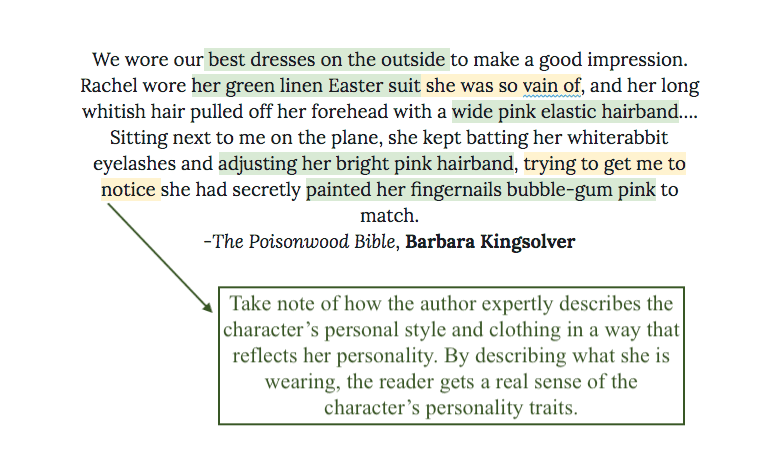
These are the personality questions for the character’s development:
43. Are they an introvert or extrovert?:
44. What are their personality traits?:
45. What is their MBTI personality type ?:
46. Are they an optimist or pessimist?:
47. How is their temperament? Are they generally hot-headed, or cool as a cucumber?:
48. What mood are they often in?:
49. What everyday attitude does your character have?:
50. What are their strengths?:
51. What are their flaws?:
52: What are their mannerisms?:
53. What are their habits?:
54. Are they an early bird or a night owl?:
55. Do they have any pet peeves?:
56. Which of the 7 deadly sins does the character most represent?
57. Which virtue does the character possess most?:
58. What are the character’s weaknesses?:
59. What are their strengths?:
60. Are they expressive? How do they express themselves?:
61. Are they ruled by heart or mind?:
62. What is their mindset?:
63. What is their philosophy?:
64. What are they motivated by?:
65. What words or phrases does the character often say?:
66. What is their life motto?:
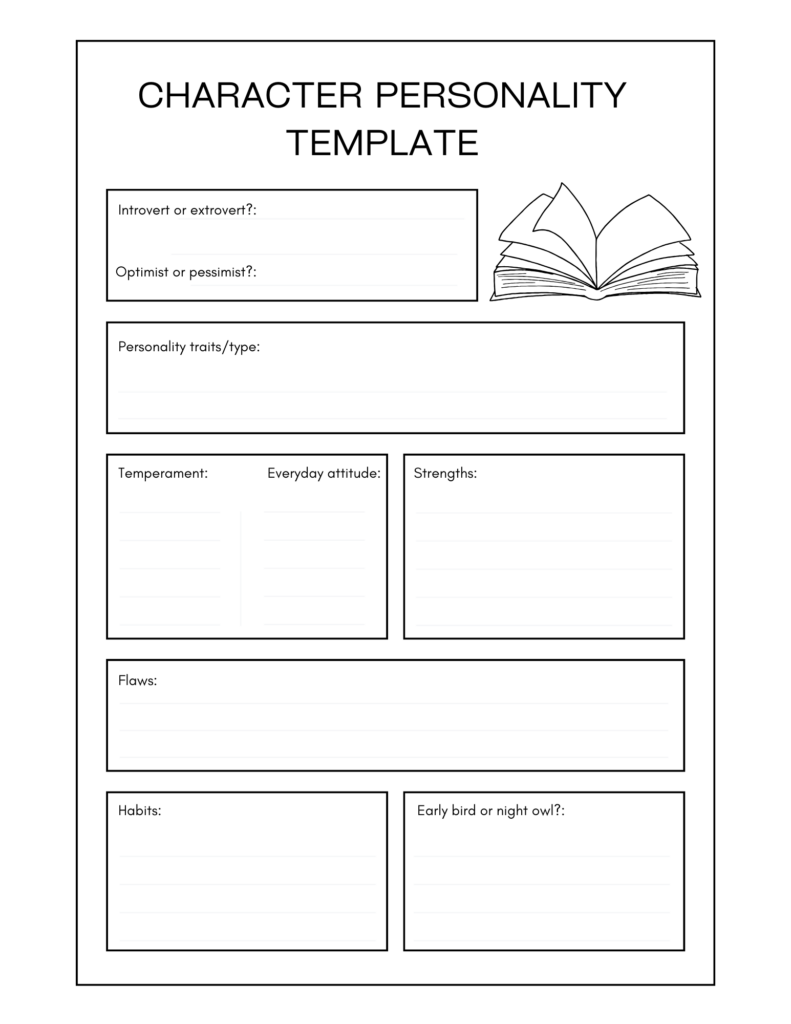
Character health bio
This section is all about your character’s health. It covers everything from mental and physical health, to major surgeries, to allergies.
If certain questions don’t pertain to your character, feel free to skip them. Or, if anything needs to be added, do so. Make this section as relevant to your character as it needs to be.
These are the health questions for the character bio template:
67. Is your character more active, or sluggish generally?:
68. Does your character often forget people’s names, or do they have a photographic memory?:
69. Is your character impaired in any way?:
70. What is your character scared of?:
71. Does your character have any addictions?:
72. Are they fast learners? Do they have poor problem-solving skills?
73. Is your character mentally tough ? What are their mental strengths?:
74. In what aspects is your character mentally weak ?:
75. What are their physical strengths?:
76. What are their physical weaknesses?:
77. Do they have any major past illnesses?:
78. Have they had any surgeries?:
79. Have they been in any accidents?:
80. Is your character emotionally stable?:
81. Do they have any allergies?:
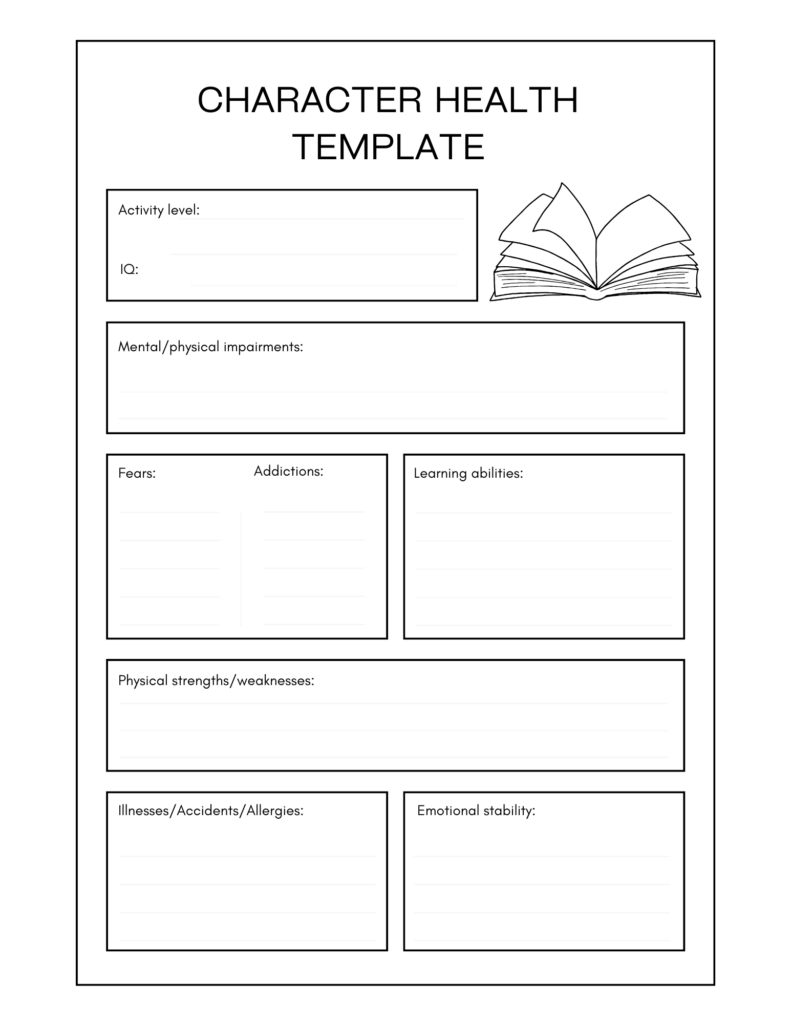
Career details
Now it’s time to cover what your character does for a living – or how they spend the majority of their time. Is your character making a living doing a job they hate, but attending night school to get their dream job?
A person’s choice of career, or their type of dream job, says a lot about that person’s qualities and interests, or lack thereof. That’s why it’s important to add career questions to your character bio template.
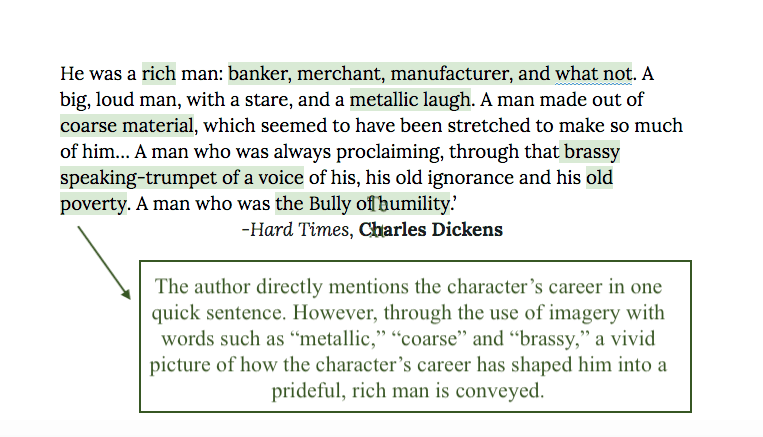
These are the career questions for the character bio template:
82. What is their job title?:
83. What company do they work at?:
84. What type of career do they have?:
85. What is their education level?:
86. Did they go to college? Where? For what?:
87. How is their work ethic?:
88. What is their job history?:
89. What is their income?:
90. What political party/organizations do they belong to?:
91. Do they do any volunteer work?:
92. What is their dream job?:
93. What job would they do poorly?:
94. How is their job satisfaction?:
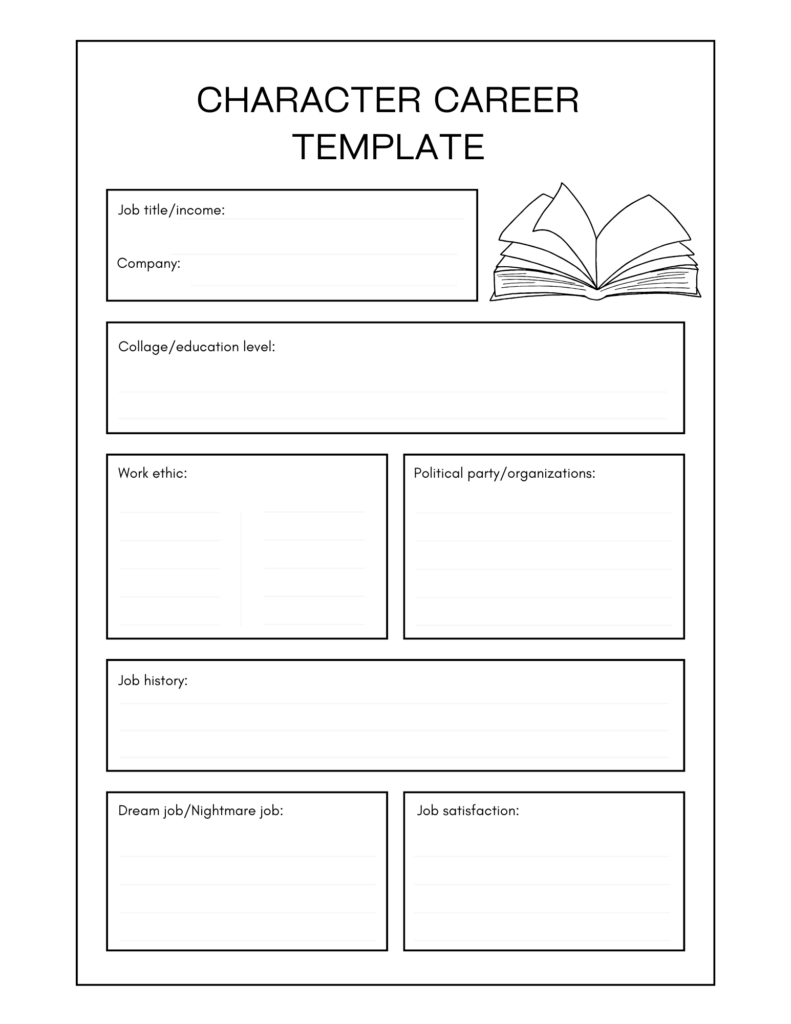
Character preferences
Everyone has their likes and dislikes, from books to activities to the time of day. By answering all of these questions about your character in your character bio template, you’ll be able to build up a person that’s realistic and believable.
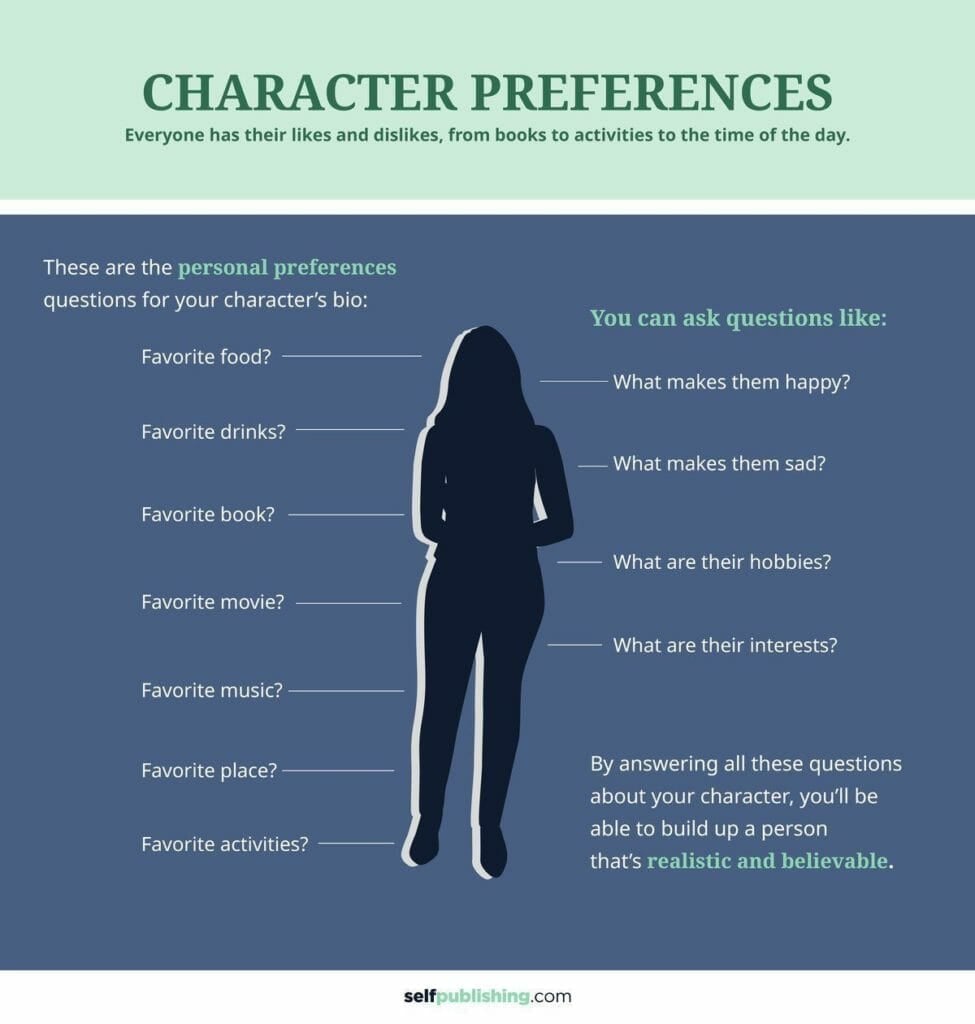
These are the personal preference questions for your character bio template:
95. What is your character’s diet like?:
96. What are their favorite foods?:
97. Favorite drinks?:
98. Favorite movies?:
99. Favorite music?:
100. Favorite books?:
101. Favorite animal?:
102. Favorite place?:
103. Favorite activities?:
104. Favorite time of day?:
105. What makes them happy?:
106. What makes them sad?:
107. What are their hobbies?:
108. What are their interests?:
109. What do they love to do?:
110. What do they hate to do?:
111. What are they inspired by?:
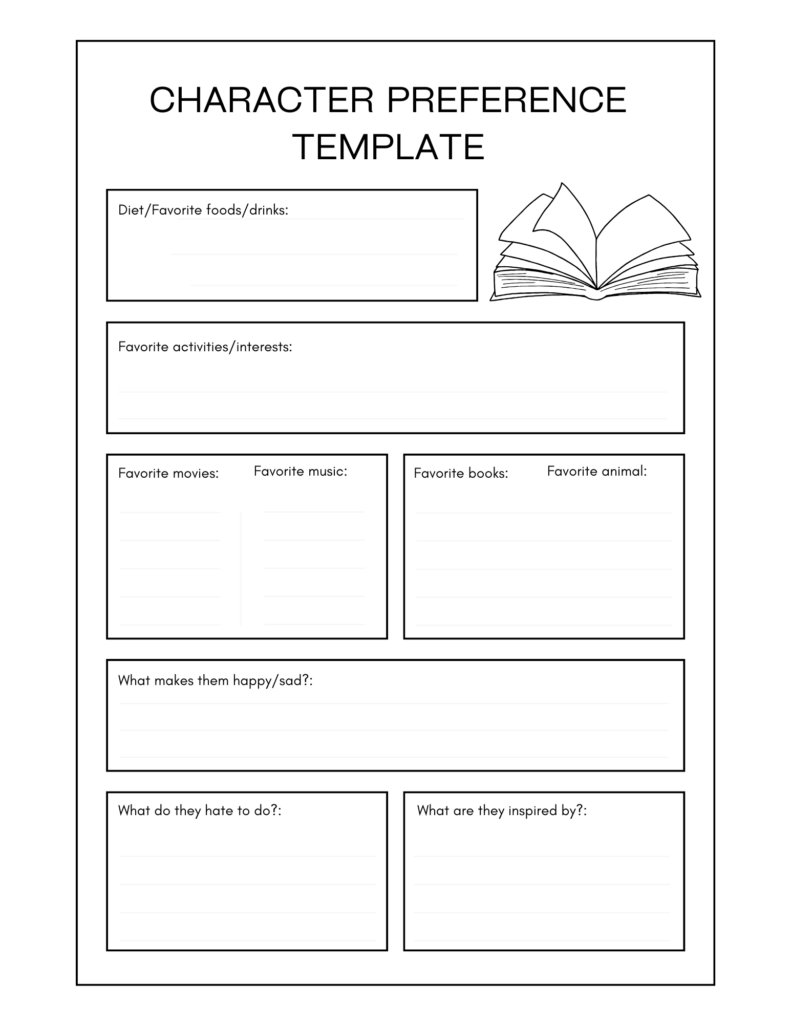
Family life of the character
Let’s face it – family, or a lack thereof, shapes a person. The same is true about your character.
This section is all about your character’s family life, from their parents to extended family, and even pets.
By knowing the family your character came from, you’ll also learn a lot about your character and why they are the way they are.
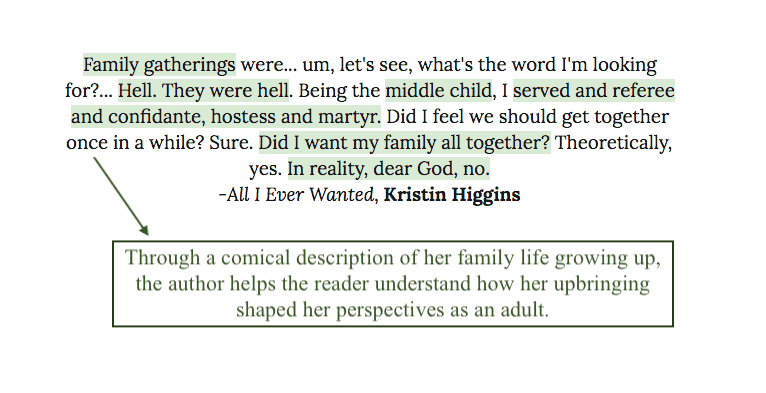
These are the family life questions for the character bio template:
112. Who were they raised by?:
113. What is the status of their parents?:
114. What is their mother’s name?:
115. Mother’s age?:
116. Mother’s background?:
117. What is their father’s name?:
118. Father’s age?:
119. Father’s background?:
120. How is their relationship with their mother?:
121. How is their relationship with their father?:
122. What is their parenting type?:
123. Are they an only child? First, middle, or youngest?:
124. How many siblings do they have?:
125. What is their relationship with their siblings?:
126. Do they have kids of their own, or do they want them in the future?
127. What are some interesting details about their other relatives?:
128. Is their family close-knit or distant? How has family life shaped the character? Do they have any sibling rivalries, or are they best friends with a particular sibling?:
129. What do they like most about their family?:
130. What do they like least about their family?:
131. What are their children like (if applicable)?:
132. Do they have any pets?:
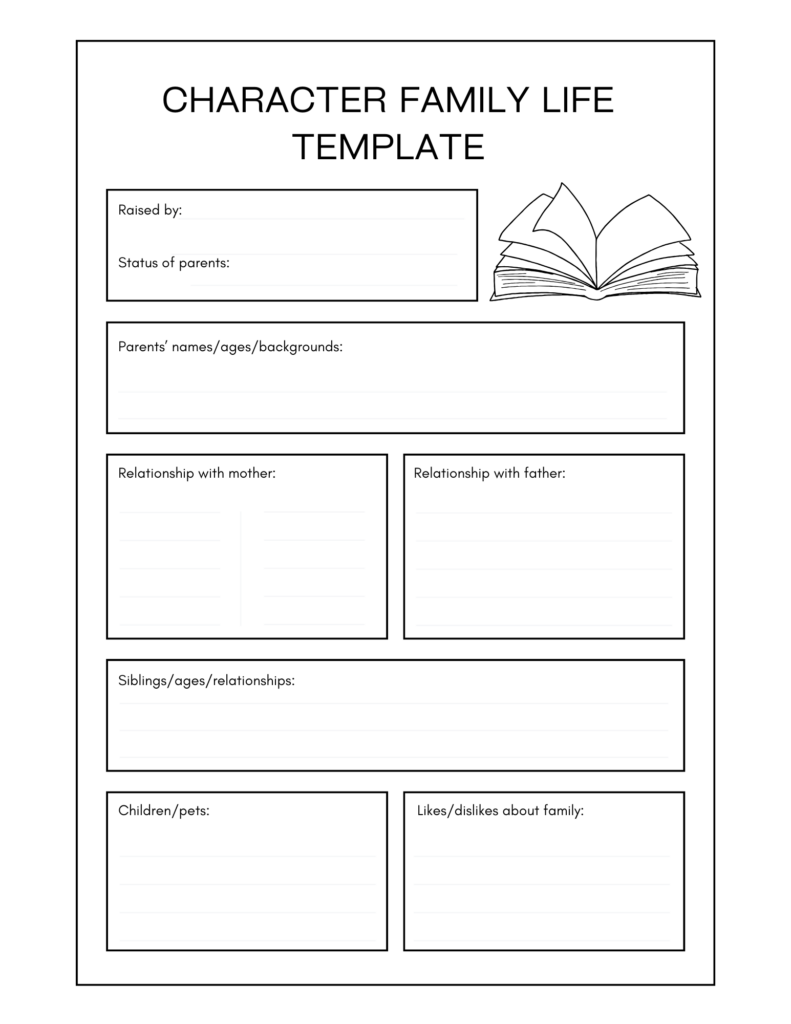
Character bio relationships
In this section, you’ll be answering all the questions that have to do with your character’s relationships – from friends to lovers to enemies.
Think about all of the influential relationships your character has been involved with. Each person, and each relationship, is different, so keep that in mind as you fill out this section of the character bio template.
Each of us becomes involved with people who teach us lessons, whether these individuals stay in our lives long or not. The same is true for a well-developed character!
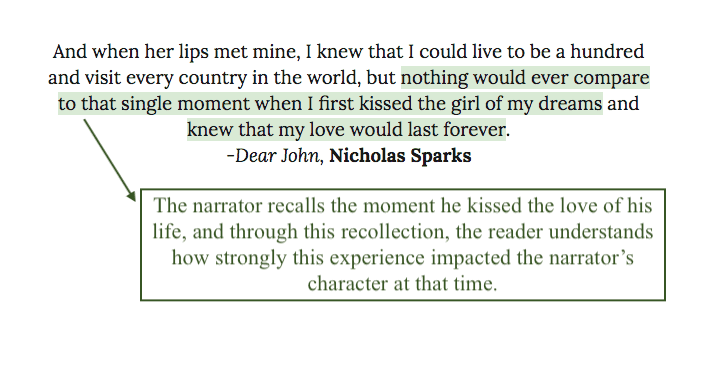
These are the relationship questions for the character bio template:
133. Who are their best friends?:
134. Who is their worst enemy?:
135. Do they have many acquaintances or a few close friends?
136. What is their sexual preference?:
137. Their sexual orientation?:
138. What is their relationship status? Are they happy with it?:
139. Are they married? Divorced? Widowed?:
140. Who was their first love?:
141. Who is their current or aspiring love?:
142. Are there any exes that influenced the character, either positively or negatively?
143. Who does your character love best in terms of their friends and relations?:
144. Who does your character dislike in terms of enemies and acquaintances?
145. Who knows the character best?
146. Who is closest to your character?
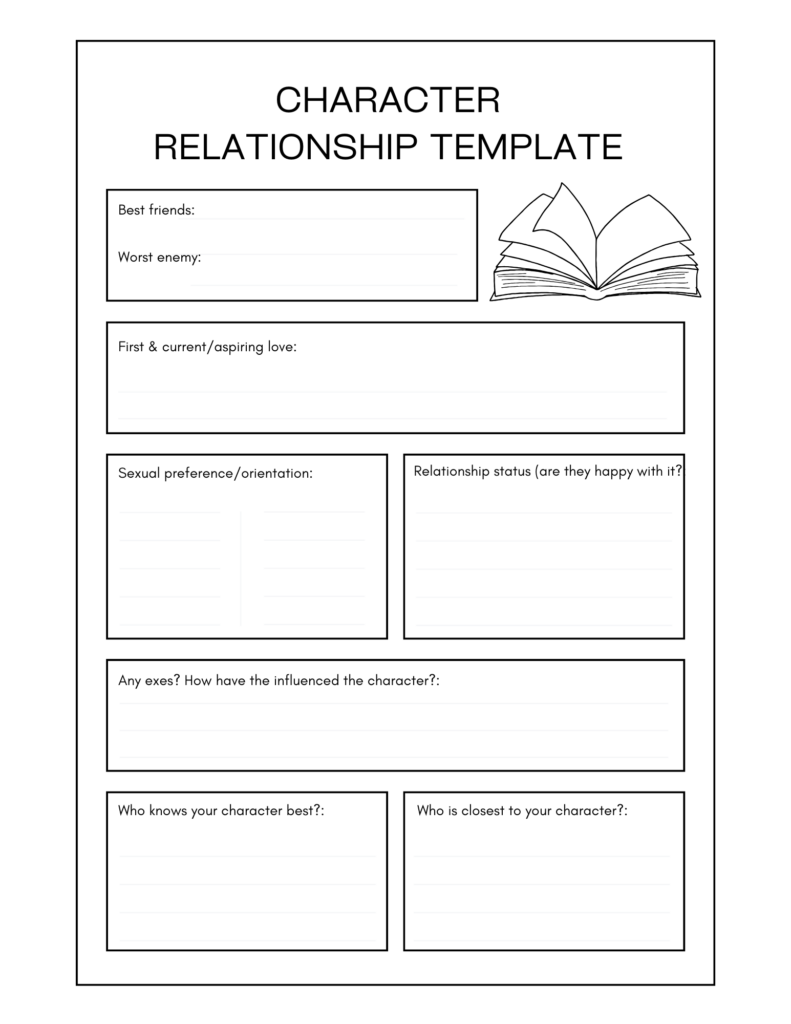
Character template life stages
It’s time to cover your character’s life stages. If your character is an adult in your story, then you’ll want to fill out quick details on each question in this section. If your character hasn’t reached a certain stage yet, just skip that part.
For each life stage, you can write a few sentences to describe the overall time period for the character. Don’t feel the need to list out every single thing that happened to your character in a certain life stage – unless you want to.
These are the life stage questions for your character bio template:
147. What was their childhood generally like?:
148. Did anything significant happen in their childhood?:
149. What were their teenage years like? Did anything significant happen?:
150. What were they like as a young adult? Did anything significant happen?:
151. Have there been any significant events in their adulthood?:
152. When did they really grow up and come into themselves? (Their “coming-of-age moment”):
153. Are there any important moments or experiences that shaped them?:
154. How have they changed as a person throughout their life?: Were they raised as a spoiled only child, but later became a Buddhist monk?:
155. Are there any major regrets the character has from their life?:
156. What are the biggest life lessons your character has learned?:
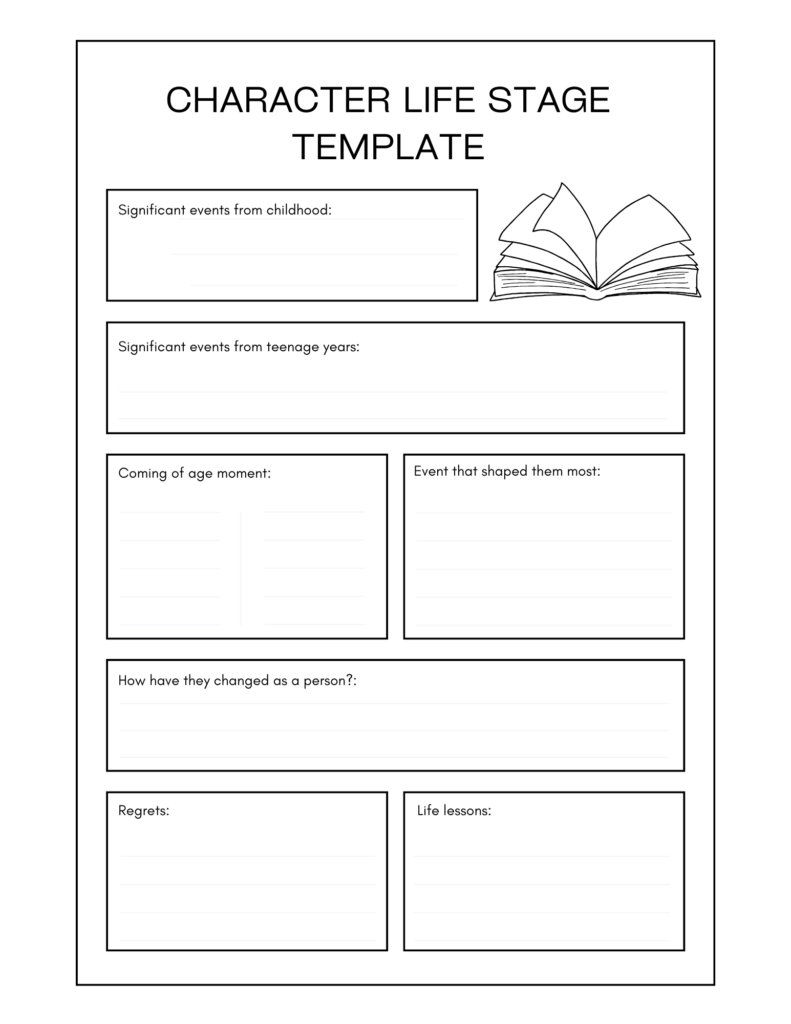
Character perspectives
Next, we’ll go through the questions that will help show us how your character thinks about the world and perceives things.
This is important because it helps shape your character’s mindset, especially if you are narrating the character’s inner thoughts and dialogue.
Filling out this section of the character bio template will also help you as you practice writing in your character’s point-of-view, and will give you a sense of your character’s thought process, and how their mindset affects their actions.

These are the perspective questions for the character bio template:
157. What are your character’s religious beliefs?:
158. How was their upbringing?:
159. What are their core values?:
160. How are their morals? What does s/he believe is evil? What does s/he believe is good?:
161. What would your character risk their life for?:
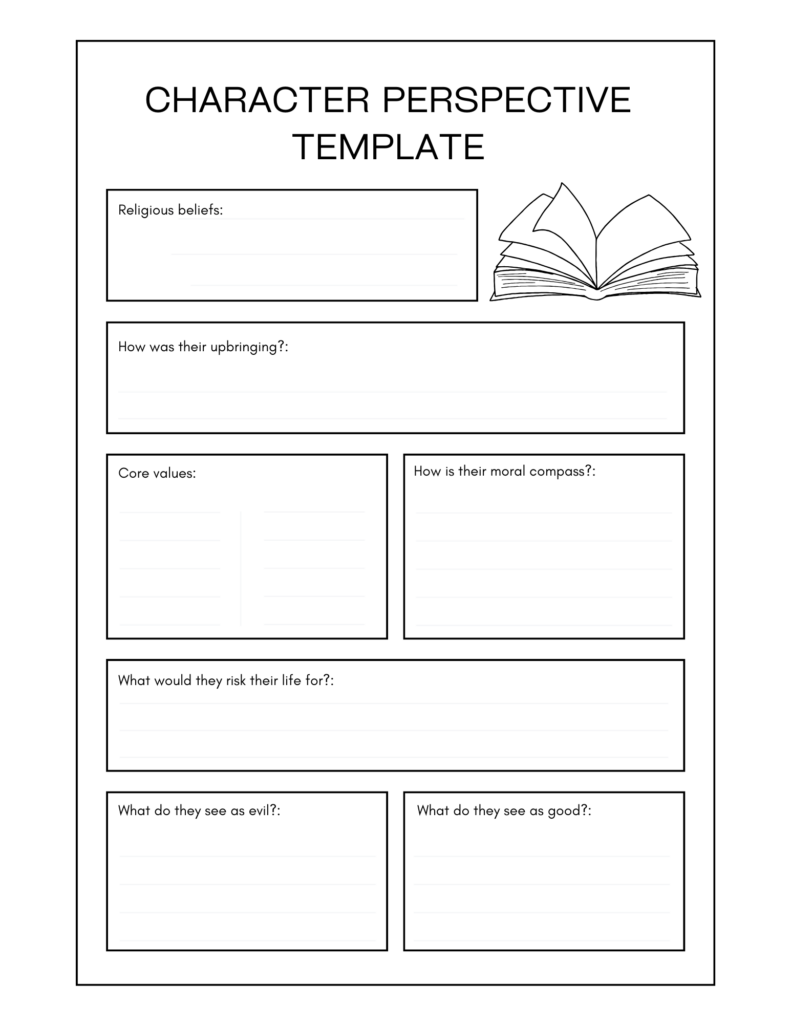
Character’s story development
Now it’s time to answer all of the questions that have more to do with your character’s thoughts, actions, and role within your storyline.
You need to know what’s driving your character in the story, and what’s getting in their way. Answer each one of these questions as it relates to your story.
For example, when describing the character’s main goal, don’t answer it in terms of their entire life’s main goal – think of the main goal in terms of your story. Maybe your character’s main goal is to live without regrets. But how does that relate to your story? You need to make it more specific to your plot. Maybe your character’s main goal within the context of your story is to help hide persecuted children, even if it means death and dishonor.
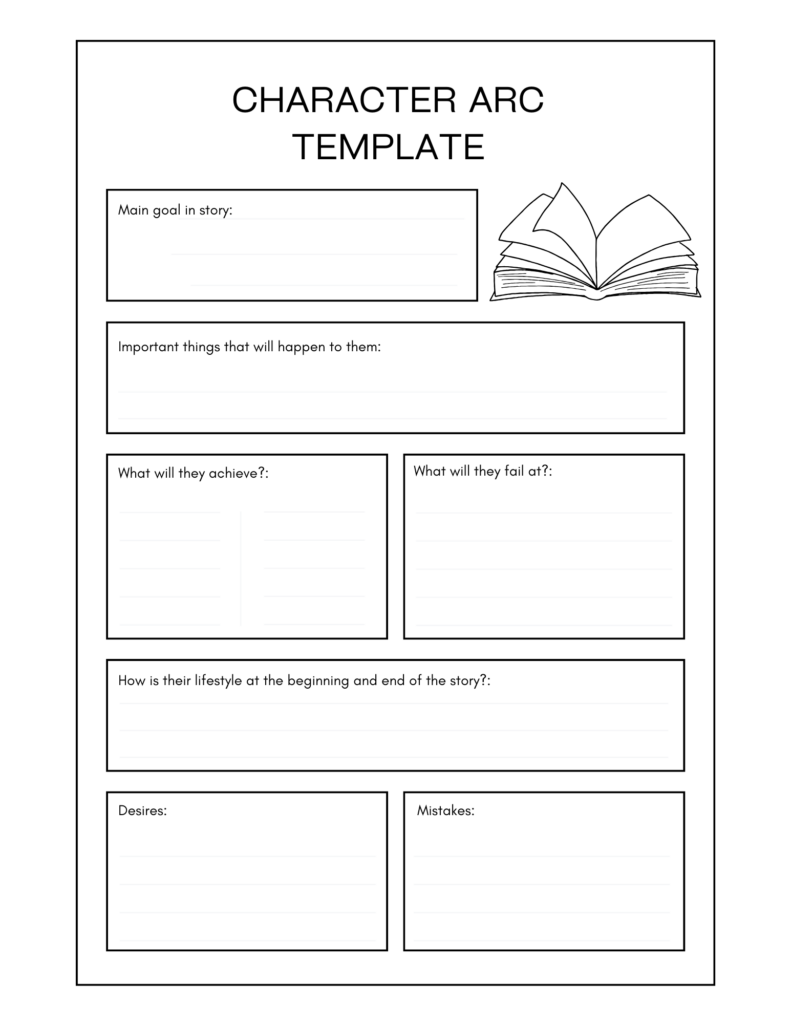
These are the story development questions for your character’s development:
162. What important things will happen to the character in your story?:
163. What will they achieve?:
164. What will they fail at?:
165. What is your character’s lifestyle like as it pertains to your story’s time period or setting?:
166. What are some traits your character will possess during your story?:
167. What culture do they identify with?:
168. What is their main goal in the story?:
169. What are some minor goals they have in the story?:
170. What does your character desire?:
171. What are/were their biggest mistakes?:
172. What would “rock bottom look like for your character?:
173. What is their dream life like?:
174. What is their worst nightmare?:
175. What are their favorite memories?:
176. What are their least favorite memories?:
177. What are some things they want in life?:
178. What are some things they don’t want in life?:
179. What obstacles are currently in their way?:
180. Do they have any secrets?:
181. What is their worldview?:
182. Who is their personal hero?:
183. What internal conflicts do they have?:
184. What external conflicts do they have?:
185. What do others think of them?:
186. What do they think of themselves?:
187. What do they wish they could change?:
188. What do they wish they could have?:
189. What gets them fired up?:
190. What do they cherish most?:
191. Things they take for granted?:
192. What inspires them?:
193. What do they have doubts about?:
194. What makes them feel alive?:
195. What makes them want to do better?:
196. What do they want to be remembered for?:
197. How will other people’s perceptions of them change?:
198. How will the character change?:
199. What will your character be doing by the end of the book?:
200. How will your character feel at the end of the book?:
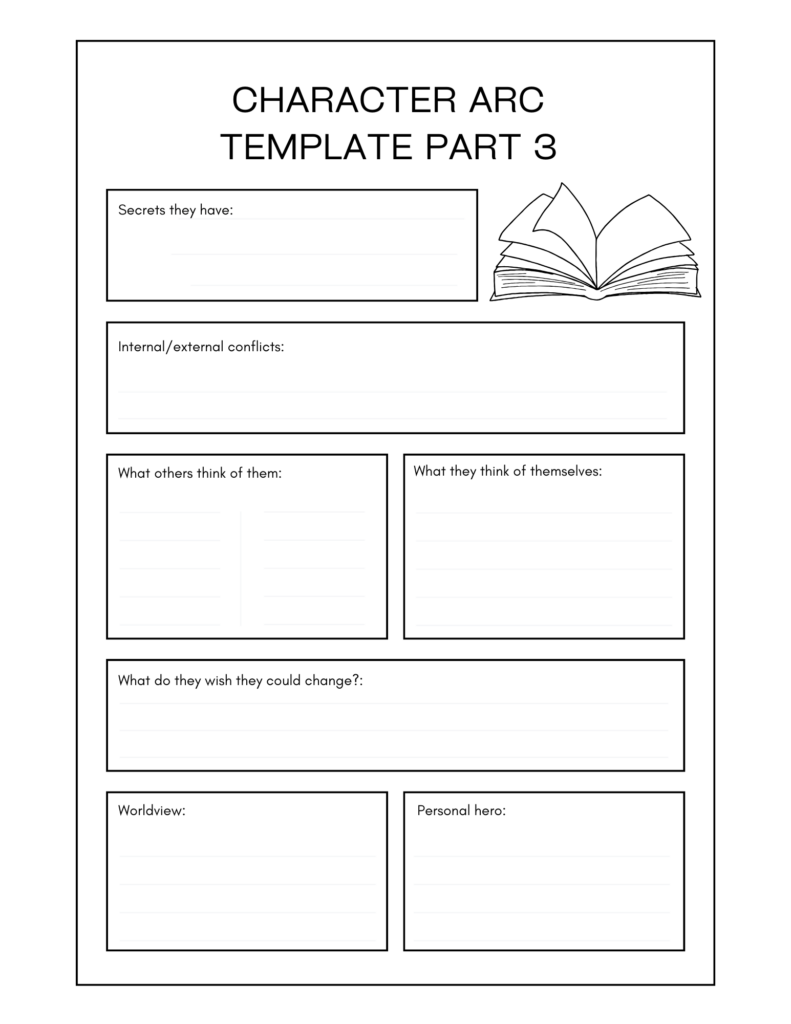
Now that you’ve quickly read through each section of the character template, your brainstorming wheels should be turning as you start to hone in on certain questions about your character that you hadn’t thought of before.
Once you’re ready to start, you can use the blank template below to fill out for each one of your main characters. Remember – keep a copy of your character template sheets nearby for reference as you begin writing!
- Static vs Dynamic Characters
- What Are Stock Characters?
- What Is A Round Character?
Make the most of your character bio template
So there you have it – your very own comprehensive character bio template. Remember, it doesn’t matter what genre you are writing about. Every book should have well-developed characters that come alive through using writing strategies, techniques, and literary elements .
At the heart of every well-written story is a believable character that readers are engaged with and connected to. To create that character, you want to make them as realistic as possible, and you can do that with the help of a character bio template.
Join the Community
Join 100,000 other aspiring authors who receive weekly emails from us to help them reach their author dreams. Get the latest product updates, company news, and special offers delivered right to your inbox.
- Screenwriting \e607
- Directing \e606
- Cinematography & Cameras \e605
- Editing & Post-Production \e602
- Documentary \e603
- Movies & TV \e60a
- Producing \e608
- Distribution & Marketing \e604
- Festivals & Events \e611
- Fundraising & Crowdfunding \e60f
- Sound & Music \e601
- Games & Transmedia \e60e
- Grants, Contests, & Awards \e60d
- Film School \e610
- Marketplace & Deals \e60b
- Off Topic \e609
- This Site \e600
11 Tips to Spice up your Character Bios (FREE Template)
Character bios may seem like busy work, but they’re crucial outline tools that bring light and life to your stories..

If everyone has a story to tell, then every character in those stories needs to be made up of stories of their own, so the tale comes across as real and engaging.
The more detail you give your character, the more the audience can identify with them and the easier it'll be for your project to find its way to the big or small screen. To get your characters in shape, I recommend writing a character bio for them.
Today, we'll go over character bios, mini character bios, and we'll even give you some tips and tricks to deepen your characters with our character bio worksheet. They're the same as character profiles, so if you came here looking for those, you're in the right place.
So let's dive in!
What is a Character Bio?
A character bio, or character profile, is a few sentences or pages that make up your character's story. They help embellish your character's traits and aid in character development and mapping out your character's arc . The bio should give the person reading it a way to personally connect with the character. It should not matter whether or not they are a protagonist or an antagonist ; the bio needs to provide information that makes that person more human. These bios don't have to occur on the screen. But they should be known by the writer, director, and actor to give depth and meaning behind every choice, and be available to provide backstory as needed in the script.
Mini Character Bios
A mini character bio is a one-sentence summary of who that character is, for example, "Bruce Wayne is a billionaire philanthropist who dresses like a Bat to avenge his parents' death at the handle of a criminal." Your mini character bio can help when you're pitching your characters . But if you're creating a bible or a treatment , you might want to write a longer character bio, so development executives know exactly what to expect from the characters in your screenplay.
How to Expand your Character Bio
Since screenwriting is an economical way to get ideas across, we often lose out on the art of expanding our character bios. But we have to be ready to give the long-form version of these biographies because they'll help inform the people playing our character and the casting search. They also are great in helping us define the hoops and hurdles people need to go through to arc. If we now why our characters are a certain way, we can help change them moving forward.
11 Tips for Your Character Bios
When you're expanding your character biographies, it can be hard to think about all the details you need to make a complete person. I've assembled 11 tips and tricks to help you add to your characters' stories. I'll provide examples for each, and we can go through them on the worksheet we provide to help you brainstorm.
1. Personal information
This one is pretty easy. What should we know about your character? Height, weight, hair, personal style - give us the police description of who we are looking at and why they stand out in the crowd. Try to avoid cliches, such as labeling the women hot or beautiful, and telling us how muscular the men are. Sure, if you need to describe a superhero, maybe they're jacked and hot, but go a step further. What else can we know about them?
For example, what do we know about Steve Rogers when we meet him? Sure he's puny, but how big is his heart? Consider digging deep when you get here.
2. Their family
As Dom Torretto can tell you, you're nothing without your family. So whether you're the Dad playing catch with his son in Field of Dreams, or the Joker's dad putting a smile on your face, or the mother from Oedipus , all the way to Stranger Things , let us know about the characters' family.
3. Strengths?
Superman can leap tall buildings in a single bound and is faster than a speeding bullet. Elle Woods knows how to accessorize. What is your character good at? A lot of the story is going to focus on people overcoming things, and the way to plan that out is to see what they're good at and make sure the obstacles butt up against that. So pick out what you think your characters are good at and make sure that shines.
4. Weaknesses?
What's your character's kryptonite? Elle Woods relies too much on what people think of her and doesn't think enough about what she can accomplish. These weaknesses will help guide your story structure . Keep your character bio fresh by talking about your character has problems with so that we have places for them to arc.
While this might get confused with weaknesses, it's a little more personal. Maybe your weakness is kryptonite, but a character flaw would be being willing to save everyone without taking time to save yourself. Think about Peter Parker - his flaw is that he values being a hero over being a kid, and that means sacrificing a lot of his relationships. This inability to show up for his friends is a huge character flaw. And if we include that in the character bio we will know how to craft our story, or even future movies or tv episodes, around this flaw.
6. What’s their backstory?
Everyone comes from somewhere. The backstory is important because we are the sum of our parts. Your characters are the same way. Tell us where they came from and when their strengths, weaknesses, flaws, and family come from. This should be an amalgamation of all the tips - and an explanation for who the character is today. Think about Gamora from Guardians of the Galaxy. She's a fierce warrior with issues because Thanos raised her and took her from her fallen planet.
7. Why Do We Care?
Seriously. Why? Empathy is the strongest emotion. It's what connects us to your characters. Every character bio needs empathy. We need to know what these people are going through that makes them accessible to us. Michael Scott started as a character who we kind of hate, but then we realized he just wanted love. Michael was a guy afraid of dying alone, and who doesn't relate with that! Once we found empathy with Michael, he came into America's homes and became one of the most popular characters of all time. And this counts for villains too. We understood Killmonger's intentions, had empathy for his struggle, and it made Black Panther a deeper movie.
8. What do they want?
Wants and desires drive your character's intentions. They're arguably the most critical part of the character bio. The reason we watch your show or movie is to see characters reach for their goals . So knowing what drives them gives your story a ton of purpose. So what does your character want? It could be like Thanos, to rule the universe, or it could just be a small goal that drives a bigger story, like Mud's desire to get his boat running.
9. What’s in their way?
Obstacles, and how they attack them, are the definition of a character. So it's time to define who this person is and what stands in their way from being the fulfillment of their dreams. Indiana Jones wants to be the guy who found the ark, but he has to beat the Nazis to get there. Just like Chiron wants love but coming out and being a gay man is frowned upon in his community. So each character has to overcome what stands in front of them to fulfill who they are in their bio.
10. How do they arc?
We talk about character arcs here. It's the backbone of the story and should align with the story map . When it comes to the bio, we want to know where they start and where they're going. This matters especially in television because if you're staying with these characters for several seasons, we need to have illusions toward where they are going. Think about the Cheers dynamic with Sam and Diane, or even Blackish's Bo and Dre. Who are these people when we meet them? What puts a strain on their relationship and what can we do to bring them closer and tear them apart?
11. Do they have a secret?
The last character bio tip and trick that I love is to give your character a secret. What's something they don't share with the world, or something we could reveal, that deepens who they are in our eyes? You could use a character secret generator , but it's probably better to just get to know your characters. I love big reveals, like Snape's obsession with Harry's mom. But you can have little things too, like Jon Snow being a Targaryen. Wait, that's not so small, but maybe something small like an alter ego, or maybe they have a hidden fear or love. Let your character's secrets get them in trouble, add some emotion, and dictate the path of your story.
Character Bio Worksheet
What’s next join our free drama pilot seminar.
Want to learn how to write a TV pilot? You've come to the right place.
Breaking into Hollywood with a writing career is one of the hardest things you can do. Fewer and fewer movies are being made every year, and now, many young writers are turning to television to find jobs. But to get a job in television, you need a sample. Samples are speculative pilot scripts that your agent or manager can hand to showrunners to prove your worth.
So get writing, and make sure every character has a bio that matters!
I can't wait to read what you write next!
- How to Create Three-Dimensional Characters From a One-Dimensional Character ›
- How to Write Character Introductions (w/ Template) ›
- The Ultimate Slasher Film Screenplay Beat Sheet ›
- How To Write Your Family As Film Characters ›
- The Best Original Character Bio Template (250+ Traits Sheet ... ›
- Character Bio Templates : r/Screenwriting ›
- The Ultimate Character Bio Template | 70+ Questions & Attributes ›
Rebuilding the Film Industry, Closure, Plus a $400 Doc Short
“we’re going to have this feral resurgence of indie filmmaking".
TV is oversaturated. California is too expensive to film in. Many audiences are underserved. It’s time we indie filmmakers rebuild the film industry on our terms.
Plus, we bid farewell to a beloved host of the No Film School podcast.
In today’s episode, No Film School’s Charles Haine, GG Hawkins, Jason Hellerman, and guest Janek Ambros discuss:
- Not waiting on labs or studios to give you the green light
- The influx of people looking for jobs in the market
- Needing better streamer options for indie projects
- The benefits of serving an underserved audience
- Why the distribution process is vital
- Advice for people who think they are finished with their project
- The important reasons Charles insists on working in Davinci Resolve
- Why Charles is leaving the No Film School podcast
- The origin of the short documentary film, Ukrainians in Exile
- Why Janek wanted to keep the movie so simple and so short
- Advice for documentary filmmakers
Ukrainians in Exile : A Documentary Short Film
Follow Assembly Line Entertainment on IG
Follow Janek on X
BlueCheck Ukraine
Subscribe to the No Film School Podcast on:
- Apple Podcasts
Listen to more episodes of the No Film School podcast right here:
This episode of The No Film School Podcast was produced by GG Hawkins .
Blackmagic Camera App Set to Finally Come to Android
Turn your smartphone into an ai-powered micro-four-thirds camera, 'prometheus' explained—what did the movie mean and who are the engineers, what are the best experimental films of all time, what are the best mystery movies of all time, blackmagic camera for android adds improved stability and support, google gemini can write screenplay coverage, when does m. night shyamalan cameo in each of his films, what was the first color movie ever made, how alfred hitchcock used visionary cinematography.


How To Write A Character Bio: 7 Important Aspects To Consider
- September 18, 2022
Character bios are essential for creating believable characters.
Understand that the characters in your story are a major hook. They carry the plot and stick with readers. They are often the reason why a reader enjoys a story and even recommends it to a friend.
So, how do you write a compelling character bio, one that will help you craft realistic, believable, and engaging characters for your readers to enjoy? This article will explain how to do just that.
How to write a character bio
Below we’ve included a list of questions to serve as a character bio template.
Answering these questions about your character will help you gain insight into that character’s depths, feelings, perspectives, goals, hopes, dreams, weaknesses, desires, and other aspects that will inform the plot development.
1. Name, age, nationality
Let’s start with the basics—outline basic but essential details about your character, such as their name, age, and nationality. Defining the geographical background is still important even if your characters live in a fictional world on another planet.
- Nationality
Consider the relevance of the above details.
Where did their name come from? Were they named after a relative, or does their name have something to do with the circumstances of their birth?
Are they mature for their age? How does their birthplace influence other parts of their lives?
Even though the above details are the most basic aspects of your character, they can still offer rich insight.
2. Physical appearance and characteristics
Well-defined physical characteristics help readers visualize your character , making a more engaging and immersive reading experience. Consider:
- Build/stature
- Hair and eye color
- Clothes/style
- Disabilities?
- Unique facial features (scars, moles, etc.)
Explore why a character looks the way they do.
What features exist that are not from birth? If your character has a scar, how did they get it? If they have an extra large nose or acne, how do they feel about it?
What does their style say about them as a person, and how important is their style to them? Do they have short fingernails because they bite them?
3. Preferences
Character preferences help you take a step further in understanding your character.
Even if these preferences don’t show up in the actual story, knowing about them will help you visualize and craft a rich character, and your insightful relationship with whom will help you keep writing the story. Consider your characters’:
- Favorite food
- Favorite Music
- Favorite color
- Political views and opinions
- Religious views
- Favorite book/movie genre
- Clothing/style preferences and goals
- Favorite way to relax
- Favorite type of people
4. Health status
Consider your character’s health. That includes both physical and mental health. Their health status will inform other aspects of their life, such as their energy levels, worldview, and hopes and dreams for the future.
- Are they generally healthy?
- Do they have any diseases?
- Do they smoke/drink/use other drugs?
- Are they calm or stressed?
- Do they exercise much? How much?
- How is their diet? Do they follow a healthy one? Do they under/overeat?
- Could they successfully escape if being chased?
- How does their health relate to their physical appearance?

Consider your character’s career and education. These may or may not be relevant to the particular story you’re writing, but these details and others may become relevant at some point in the story, so it’s wise to have an existing idea of them.
- Did your character study? If so, what did they study? Do they have a career in that field?
- What’s their job?
- Do they like their job? What aspects of their personality help them succeed at work?
- Do they prioritize their job, or are other parts of their life more important?
- What’s their level of education?
- Does their education level affect their choices and success in their life as per the story?
- Do they have any notable career achievements?
6. Personality Traits
- Are they motivated?
- Are they open or closed to new experiences?
- Do they act the same way around everyone, or do they change around particular people?
- Are they more optimistic or pessimistic?
- Introvert, extrovert, or ambivert?
- Are they kind or nasty?
- What skills and strengths do they possess?
- What are their flaws?
- Do they keep any secrets?
- Do they have any regrets?
- How do they approach challenges and obstacles?
- Are they confident in themselves?
- Do they prioritize self-care?
- Do they take risks?
- Are they spontaneous?
To further flesh out your character’s personality traits. Consider the Big Five personality traits outlined below. These are:
- Extraversion
- Agreeableness
- Conscientiousness
- Neuroticism
7. Relationships
Your character’s relationships are highly formative. These include their parental, platonic, and romantic relationships and their connections with authority figures in their adult life.
How one relates to others says a lot about their character, so invest time into fleshing out your character’s relationship dynamics and attitudes.
- Does your character have a romantic partner? Boyfriend/girlfriend, husband/wife?
- How does the character feel about their parents? How is that relationship? If their parents are no longer around, do they have any regrets about that relationship?
- Do they have siblings, or are they an only child?
- What’s their support system like when they face stress or trouble? Do they have a family to rely on? Close friends?
- Does your character have many close friends? Are they a socialite, or is their social circle small? How do they feel about people in general?
- Has your character had any romantic relationships in the past that shaped who they are today? In what ways did that relationship shape them?
- Who is their best friend?
- What do they love about their romantic partner?
- Who does your character turn to in times of crisis?
- How is your character’s sense of trust in others? Do they find it easy or hard to trust people?
Bonus miscellaneous character questions
Add these questions to your character template to gain even deeper insight into who they are:
- What is your character’s greatest achievement?
- Which of your character’s traits will change in the story? And what will remain the same?
- What are the main aspects of your character’s story that have made them who they are, where if those aspects are different, they may be a different person?
- How would your character describe their own life at the beginning of the book?
- What biases does your character hold?
- What are some of your character’s core beliefs, and how did those beliefs form?
- Who is your character’s biggest inspiration?
- What does your character’s typical day look like before the story’s main events?
What is a character bio?
A character biography, also known as a character profile, is a type of character development aid that covers a character’s life story (or background), physical characteristics, personality traits, and strengths and weaknesses.
A character’s bio helps the author fit your character into the overall story, whereby they make decisions and react to events based on their pre-defined traits and characteristics.
A bio helps you stay on track regarding a character’s arc as you write the story.
Many authors visualize several potential story arcs and trajectories in the writing process. As such, having a framework like a character bio or a general novel outline helps you take the story from A to B with a consistent and coherent narrative rather than a story full of sprawling trajectories that don’t take the reader anywhere in particular.
Creating one for each of your characters is essential when writing character bios. Naturally, you may focus more on fleshing out your protagonist , but don’t neglect other characters.
There are no small roles because each of your characters plays a vital role in the story. As such, they deserve to be well-written.

Character breakdown example
A character breakdown is a brief character description.
It is not their complete profile but a description of that character in just a few sentences.
In writing a story, a character breakdown can help you create a basic outline for your character, after which you can interview and investigate to flesh them out further.
Consider the following character breakdown examples:
Mrs. Dursley – Harry Potter and The Sorceror’s Stone (J.K. Rowling)
Mr. Dursley was the director of a firm called Grunnings, which made drills. He was a big, beefy man with hardly any neck, although he did have a very large mustache. Mrs. Dursley was thin and blonde and had nearly twice the usual amount of neck, which came in very useful as she spent so much of her time craning over garden fences, spying on the neighbors.
Mama Bekwa Tataba – The Poisonwood Bible (Barbara Kingsolver)
Mama Bekwa Tataba stood watching us—a little jet-black woman. Her elbows stuck out like wings, and a huge white enameled tub occupied the space above her head, somewhat miraculously holding steady while her head moved in quick jerks to the right and left.
For such an extraordinary athlete—even as a Lower Middler, Phineas had been the best athlete in the school—he was not spectacularly built. He was my height—five feet eight and a half inches…He weighed a hundred and fifty pounds, a galling ten pounds more than I did, which flowed from his legs to torso around shoulders to arms and full strong neck in an uninterrupted, unemphatic unity of strength.
Character bios are not just for fiction writers. Even nonfiction writers can benefit from crafting bios for the real people about whom they write.
Consider a memoir or a psychology book with case studies.
The fact that the subjects exist in real life is not enough for a reader to engage. Authors still need to flesh out these characters and bring them to life on the page.
Answering the questions in the bio template will help you add dimension to your characters so that whether you write fiction or nonfiction, readers will connect with and resonate with your characters.
Give careful consideration and do a diligent investigation of your characters if you want them to stand out and be remembered.
Character development is a key part of the creative writing process and should not be overlooked.
The more you flesh out a character with investigative questions and formative answers. The more you’ll notice that your character takes on a life of their own and seems to exist beyond the page.
Leave a Comment Cancel Reply
Your email address will not be published. Required fields are marked *
Save my name, email, and website in this browser for the next time I comment.
Sign up to our newsletter!
Related articles

120 Motivational Quotes About Writing To Inspire A New Writer Like You

How To Register A Kindle On Amazon To Enjoy Your Ebooks In 4 Easy Ways

How To Market A Self-Published Book And Be Profitable In 9 Easy Ways
TRY OUR FREE APP
Write your book in Reedsy Studio. Try the beloved writing app for free today.
Craft your masterpiece in Reedsy Studio
Plan, write, edit, and format your book in our free app made for authors.

Blog • Perfecting your Craft
Last updated on Mar 08, 2024
How to Create the Ultimate Character Profile [+ Template]
About the author.
Reedsy's editorial team is a diverse group of industry experts devoted to helping authors write and publish beautiful books.
About Dario Villirilli
Editor-in-Chief of the Reedsy blog, Dario is a graduate of Mälardalen University. As a freelance writer, he has written for many esteemed outlets aimed at writers. A traveler at heart, he can be found roaming the world and working from his laptop.
Ask any great novelist, and they’ll likely tell you that good writing starts with good characters. But building characters from the ground up is also one of the toughest hills to climb, especially if you’ve struggled with those all-too-revealing questions:
- Are my characters convincing?
- Do my characters have depth?
- How do I make sure my character shows progression and change ?
If you’re having these doubts, you might want to turn to the age-old solution: a character profile.
What is a character profile?
A character profile is a detailed biography of a persona that covers everything from their age and appearance to their relationships with others. By understanding parts of their life that readers might not discover during the course of the story, an author can better understand that character’s life, personality, motivations, and their function within a story.
In this post, we will show you our three-part process for assembling a character profile.

What makes a good character profile template?
Many character bibles present exercises that ask you, “If your character was a color, what color would they be?” For many writers, this is either overkill or a bit too 'woo-woo' for their tastes, and they prefer to create a profile that deals in verifiable facts: height, age, and profession.
Our suggestion lies somewhere between those two approaches, where you build a holistic picture of your character in the context of your story. Our character profile worksheet is in three parts. If you treat a person like an apple, they’re going to have three layers of depth: the “skin,” the “flesh,” and the “core.” (Otherwise known as their physical appearance, backstory, and psychology.) That’s how this character profile template is structured — and if you have a particular area that you’d like to hone, you can skip to it below. Otherwise, this character bible will start with the eagle eye’s view of your character.
The Three-Part Character Profile Template:
- The Outer Layer, or Physical Appearance
- The Flesh, or Backstory
- The Core, or Psychology
How to create a character profile
As another reminder, we strongly recommend our character profile template in a PDF format and fill it out as you go along! Download it below for free right here.

FREE RESOURCE
Reedsy’s Character Profile Template
A story is only as strong as its characters. Fill this out to develop yours.
1. Construct the character's outer appearance
To be able to identify a criminal, detectives build a painstakingly thorough file of said criminal’s physical characteristics.
That’s the goal of this section, which covers the “skin” of your character: everything from their outer appearance to the way that they speak. Think of it as a kind of offender profile — one that can help you spot your character in the middle of a crowded Times Square.
The Basics 📖
- Place of birth
- Current location
- Nationality
Physical Appearance 👀
What's their:
Do they have any distinguishing features (tattoos, scars, birthmarks)?
What's their preferred outfit?
Do they wear glasses? 👓
What accessories are ALWAYS associated with them (cane, pipe, necklace, etc.)? 🌂
What's their usual level of grooming?
- Smart, very put together
- Untidy but clean
Do they have any distinguishing “tics” and mannerisms?
What's their health like? Do they suffer from chronic illnesses? 🏥
Describe their handwriting (sloppy, neat, careful, unintelligible). ✍
How do they walk? 👣
- Confident, powerful strides
- Lazy stroll
- Fast, walks at a clip
- Distracted, eyes on the ground

FREE OUTLINING APP
Reedsy Studio
Use the Boards feature to plan, organize, or research anything.
Speech and Communication 💬
How do they talk (rapid, slow, measured, drawl, etc.)?
What's the style of their speech (elevated, educated, peppered with slang, etc.)?
Do they have an accent?
- Stiff, military
- Casual and relaxed
- ‘Turtle,’ tired
Do they gesture?
- Only when agitated or eager
- Doesn’t gesture
- Compulsive “hand-talker”
- Controlled, only to make a point
- Other? If so, explain:
How much eye contact do they like to make (direct, shifty, etc.)?
What's their preferred curse word?
What's their catchphrase?
Any speech impediments?
What are any distinguishing speech “tics”?
What's their laugh like? What do they tend to find funny?
Describe their smile?
How emotive are they? Do they wear their emotions on their sleeve? How easily can others read them?
They have a resting _____ face.
Speaking of great characters... which contemporary author are you ? Take our 1-minute quiz below to find out!
Which contemporary author are you?
Find out which of today's greats is your writerly match. Takes one minute!
2. Build out the character's backstory
Characters don’t exist in a vacuum — they’re a product of their environment.
This section in the character template dives a bit deeper into your character and covers their “flesh”: the people, circumstances, and formative influences that filled them out and made them who they are today. It’s the springboard to your character’s biography.
What's the name of their hometown? 🏡
What type of childhood did they have (sheltered, neglected, etc.)?
Describe their education. 🍏
Were they involved in organizations and clubs at school?
- Gay / Straight Alliance
At graduation, they were named Most Likely To ___________ in the yearbook. 🎓
Jobs (if applicable)? What would their résumé look like? 💼
What was their dream job as a child? Why?
Who were their role models growing up? Describe them. 👨👦
What's their greatest regret?
What were their hobbies growing up? ⛳
Favorite place to be as a child?
What's their earliest memory?
What's their saddest memory?
What's their happiest memory?
What's their clearest memory?
What are their skeletons in the closet? 💀
If they could change one thing from their past, what would it be? Why? ⏳
Describe the major turning points or “life beats” in childhood.
What are three adjectives to describe them as a child?
What advice would they give to their younger self?
List their criminal record. ⚖

NEW REEDSY COURSE
How to Write a Novel
Enroll in our course and become an author in three months.
- Age (if living)
- Briefly describe their relationship with your character
- What are their names and ages?
- Briefly describe their relationship(s) with your character
Children 👶(if applicable)
Extended family 👴
- Grandparents
- Uncles and aunts
What's their family's economic status? 💰
How often do they see their family in a year?
External Relationships 💜
Who are their closest friends? Describe them.
Who are their other significant friends? 👋
Enemies? Describe them. 😡
How are they perceived by:
- strangers in the street?
- acquaintances at a work function?
- colleagues in the office?
- authority figures?
- friends in their friend circles?
- the opposite sex?
- extended family?
What social media platforms are they on?
- X (formerly known as Twitter)
- Other? If so, explain.
How would they use their social media platforms?
How would they fill out an online dating profile for themselves? ✨
What’s their role in a group dynamic? 💡
Who do they depend on for:
- practical advice?
- emotional support?
- moral support?
How quickly do they respond to emails? 📨
What do they want from a relationship?
Who would be their ideal partner? 💖
Who is their significant other? Describe them. 💕
How many people would attend their funeral?
Part 3. Understand the character's goals and motivations
We’ve come now to the “core”: who your character is deep down.
This section in the character profile worksheet covers the “heart” of your character. If a backstory shapes a dynamic character, this will define them. More importantly, it will help inform the two most important points leading up to your novel: the character’s story goal and what drives them .
Psychology 💭
What do they do on rainy days?
- Street-smart or book-smart
- An optimist or pessimist
- Introverted or Extroverted
What is their favorite sound? 🔊
Favorite place in the world? 🌎
What secrets do they keep? What are they most afraid of people finding out? 🔒
What do they want the most? 🔍
What's their biggest flaw?
What's their biggest strength?
What's their biggest fear?
What is their biggest accomplishment? 📈
What is their idea of perfect happiness?
What's their favorite quote? 👌
Do they want to be remembered? What for? ⌚
How do they approach:
What is the one object or possession that they would rescue from their burning home? 🔥
What (or who) bores them? 💤
What makes them angry? 💢
What do they look for in a person?
How strong is their moral compass? When, specifically, are they willing to compromise their morals?
List the last 10 books they read. 📚
Which fictional world would they most wish to visit?
If they didn’t have to sleep, what would they do with the extra time?
What are their pet peeves? ⚠
If they won the lottery, what would they do?
Describe the character’s bucket list at the ages of 15, 20, 30, and 40.
List the 10 songs that would occupy their All-Time Most Played playlist on Spotify. 🎵
What is the best compliment that someone ever paid them?
In an elevator, do they push the elevator button more than once? 🚪
What would they want their tombstone to say?
The Present and Future 🔮
What is their story goal? (answer in a single paragraph)
Story motivation (answer in a single paragraph)
In other words: what does your character want in the story? And why do they want it?
Every other answer in the character profile template builds up to this. It's critical information to know because it’ll make up the unshakable foundation — and raison d'être — for your story. Whenever you feel like your story is straying off course, go straight back to your character’s story goal and motivation, and you'll find the beating heart of your book.
24 responses
Rachel Mendell says:
02/06/2018 – 12:23
excellent! so much info - thank you.
↪️ Reedsy replied:
07/06/2018 – 04:37
Our pleasure, Rachel. Glad that it helped!
Diane says:
07/06/2018 – 08:50
Wow! I tried to find such kind of list many times. Thank you so much! Creating character is always difficult for me. I imagine tutoriage character but it was not full. With this list Finally I will finish it.
22/01/2019 – 15:37
Nice I was gonna make one myself but this is great since normally I obsess to the point of procrastination.
Gwendolyn Clark says:
13/05/2019 – 00:09
I was never sent a copy to download
↪️ Martin Cavannagh replied:
13/05/2019 – 08:20
Hi Gwendolyn, could you drop us an email at [email protected] and we'll sort you out with a link :)
Sabrina Douglas says:
08/06/2019 – 16:40
I have not received the PDF yet.
10/06/2019 – 13:48
With Gmail, our emails often can be found in the Promotions folder. if it's not there, send us an email at [email protected] and we'll sort you out :)
Tactical Weasel says:
08/06/2019 – 23:18
I was never sent a copy to download either.
Ibidun says:
02/07/2019 – 01:47
This is a developed list of questions for sure. Thank you!
susannelorraineharford says:
21/08/2019 – 08:01
Thanks! Great help in this articke. X peace, susanne
james bolin says:
22/08/2019 – 21:05
This my be a crazy question, but I am writing a science fiction book, and I already made character profiles for my ow use. But, that being said, would it make sense to also include a section in the book that includes all the main characters profiles. It would serve as a reference in case someone wants to know the characters hair color, birth date, and other details. any advice would help thanks
23/08/2019 – 09:04
It would be a somewhat unusual move — but it's not for me to say if it's wrong. Often, you see books provide family trees and brief histories of the 'world' of the story... but that tends to be so that readers can check up on facts that are highly relevant to relationships and plot of the book. In almost all cases, readers won't really need to know things like hair color or date of birth. So, I'd think hard before putting a character stat sheet in your book.
↪️ Nyla replied:
02/09/2019 – 16:12
I don't see why not! Some books did it (sort of); Wings of Fire, Tailchaser's Song, Warriors... I don't think including one would be a bad move. Definitely not something that would kill your story. Keep in mind that I'm a beginner when it comes to books, so I may not know any better. I'm just saying that in my opinion, I don't think it's a bad move.
Satyajay Mandal says:
25/08/2019 – 04:31
You can tweet me to get more updates on the story I'm directing
02/09/2019 – 16:13
What do you mean by "education"? Like what school they went to?
17/09/2019 – 09:02
Yup. Are they a college grad? What did they study? Did they leave school at 18 and take up an apprenticeship — that sort of thing.
27/09/2019 – 14:03
Will i ever get the document to download!
07/10/2019 – 15:48
Hi Sky, if you're still having trouble downloading the template, could you drop us a message at [email protected]? Thanks! Martin
20/10/2019 – 03:56
I will update you about all the details
Max Sangers says:
23/03/2020 – 20:16
I like it, just pls refrain from bad language :)
26/03/2020 – 04:49
No need to refrain from using bad language, if it is assigned to the villains instead of the heroes/heroines
26/03/2020 – 05:02
No need to refrain from using bad language if it is assigned to the villains instead of the heroes/heroines
28/03/2020 – 05:01
This is @*#$ing AWESOME!!!
Comments are currently closed.
Continue reading
Recommended posts from the Reedsy Blog

How to Introduce a Character: 8 Tips To Hook Readers In
Introducing characters is an art, and these eight tips and examples will help you master it.

450+ Powerful Adjectives to Describe a Person (With Examples)
Want a handy list to help you bring your characters to life? Discover words that describe physical attributes, dispositions, and emotions.

How to Plot a Novel Like a NYT Bestselling Author
Need to plot your novel? Follow these 7 steps from New York Times bestselling author Caroline Leavitt.

How to Write an Autobiography: The Story of Your Life
Want to write your autobiography but aren’t sure where to start? This step-by-step guide will take you from opening lines to publishing it for everyone to read.

What is the Climax of a Story? Examples & Tips
The climax is perhaps a story's most crucial moment, but many writers struggle to stick the landing. Let's see what makes for a great story climax.

What is Tone in Literature? Definition & Examples
We show you, with supporting examples, how tone in literature influences readers' emotions and perceptions of a text.
Join a community of over 1 million authors
Reedsy is more than just a blog. Become a member today to discover how we can help you publish a beautiful book.
The Ultimate Character Profile Template
Unique characters drive compelling stories. Develop yours with our free template.

1 million authors trust the professionals on Reedsy. Come meet them.
Enter your email or get started with a social account:
Related Topics
- How to Write a Book
- Writing a Book for the First Time
- How to Write an Autobiography
- How Long Does it Take to Write a Book?
- Do You Underline Book Titles?
- Snowflake Method
- Book Title Generator
- How to Write Nonfiction Book
- How to Write a Children's Book
- How to Write a Memoir
- Mistakes to Avoid When Writing a Book
- How to Write a Book Title
- How to Write a Book Introduction
- How to Write a Dedication in a Book
- How to Write a Book Synopsis
- Author Overview
- Document Manager Overview
- Screenplay Writer Overview
- Technical Writer Career Path
- Technical Writer Interview Questions
- Technical Writer Salary
- Google Technical Writer Interview Questions
- How to Become a Technical Writer
- UX Writer Career Path
- Google UX Writer
- UX Writer vs Copywriter
- UX Writer Resume Examples
- UX Writer Interview Questions
- UX Writer Skills
- How to Become a UX Writer
- UX Writer Salary
- Google UX Writer Overview
- Google UX Writer Interview Questions
- Types of Writers
- How to Become a Writer
- Technical Writing Certifications
- Grant Writing Certifications
- UX Writing Certifications
- Proposal Writing Certifications
- Content Design Certifications
- Knowledge Management Certifications
- Medical Writing Certifications
- Grant Writing Classes
- Business Writing Courses
- Technical Writing Courses
- Content Design Overview
- Documentation Overview
- User Documentation
- Process Documentation
- Technical Documentation
- Software Documentation
- Knowledge Base Documentation
- Product Documentation
- Process Documentation Overview
- Process Documentation Templates
- Product Documentation Overview
- Software Documentation Overview
- Technical Documentation Overview
- User Documentation Overview
- Knowledge Management Overview
- Knowledge Base Overview
- Publishing on Amazon
- Amazon Authoring Page
- Self-Publishing on Amazon
- How to Publish
- How to Publish Your Own Book
- Document Management Software Overview
- Engineering Document Management Software
- Healthcare Document Management Software
- Financial Services Document Management Software
- Technical Documentation Software
- Knowledge Management Tools
- Knowledge Management Software
- HR Document Management Software
- Enterprise Document Management Software
- Knowledge Base Software
- Process Documentation Software
- Documentation Software
- Internal Knowledge Base Software
- Grammarly Premium Free Trial
- Grammarly for Word
- Scrivener Templates
- Scrivener Review
- How to Use Scrivener
- Ulysses vs Scrivener
- Character Development Templates
- Screenplay Format Templates
- Book Writing Templates
- API Writing Overview
- Business Writing Examples
- Business Writing Skills
- Types of Business Writing
- Dialogue Writing Overview
- Grant Writing Overview
- Medical Writing Overview
- How to Write a Novel
- How to Write a Thriller Novel
- How to Write a Fantasy Novel
- How to Start a Novel
- How Many Chapters in a Novel?
- Mistakes to Avoid When Writing a Novel
- Novel Ideas
- How to Plan a Novel
- How to Outline a Novel
- How to Write a Romance Novel
- Novel Structure
- How to Write a Mystery Novel
- Novel vs Book
- Round Character
- Flat Character
- How to Create a Character Profile
- Nanowrimo Overview
- How to Write 50,000 Words for Nanowrimo
- Camp Nanowrimo
- Nanowrimo YWP
- Nanowrimo Mistakes to Avoid
- Proposal Writing Overview
- Screenplay Overview
- How to Write a Screenplay
- Screenplay vs Script
- How to Structure a Screenplay
- How to Write a Screenplay Outline
- How to Format a Screenplay
- How to Write a Fight Scene
- How to Write Action Scenes
- How to Write a Monologue
- Short Story Writing Overview
- Technical Writing Overview
- UX Writing Overview
- Reddit Writing Prompts
- Romance Writing Prompts
- Flash Fiction Story Prompts
- Dialogue and Screenplay Writing Prompts
- Poetry Writing Prompts
- Tumblr Writing Prompts
- Creative Writing Prompts for Kids
- Creative Writing Prompts for Adults
- Fantasy Writing Prompts
- Horror Writing Prompts
- Book Writing Software
- Novel Writing Software
- Screenwriting Software
- ProWriting Aid
- Writing Tools
- Literature and Latte
- Hemingway App
- Final Draft
- Writing Apps
- Grammarly Premium
- Wattpad Inbox
- Microsoft OneNote
- Google Keep App
- Technical Writing Services
- Business Writing Services
- Content Writing Services
- Grant Writing Services
- SOP Writing Services
- Script Writing Services
- Proposal Writing Services
- Hire a Blog Writer
- Hire a Freelance Writer
- Hire a Proposal Writer
- Hire a Memoir Writer
- Hire a Speech Writer
- Hire a Business Plan Writer
- Hire a Script Writer
- Hire a Legal Writer
- Hire a Grant Writer
- Hire a Technical Writer
- Hire a Book Writer
- Hire a Ghost Writer
Home » Blog » How to Create a Character Profile in 12 Steps [+Free Template]
How to Create a Character Profile in 12 Steps [+Free Template]

Generate Full-Length AI Book Instantly
Table of contents.
If you’ve ever tried your hand at writing a novel or screenplay, you know characters are key. Crafting them well is essential. Without fully developed, believable characters, your story will not stand out. That’s why mastering character profile creation is crucial.
Using an ultimate character profile template will immensely aid you in this process, ensuring you don’t overlook any important aspects.
This article entails the steps to create a character profile, a character profile template, types of character profiles, and other elements to develop a character profile. Let’s dive in.
Steps to Create a Character Profile
Here is a step-by-step procedure for creating a character bio:
1. Understand the Basics
Before starting, first, find out which of your characters will need a character profile. Then decide on the basics.
It will be a long process and you’ll go through a lot of information. But you do not need to do it all at once. Take one section at a time.
If you’re struggling to determine certain details or you’re not sure how your character should react, Deb Norton offers some good advice:
“When we’re at a loss for putting words in our character’s mouths, that’s often when it’s time to stop thinking and start listening. Does his manner of speech change when he talks to his kids? What is he holding back? Why did he use that word?”
As writers, we sometimes tend to overthink a little bit (or a lot). Sometimes, it’s better to write more freely. Channel your character and just let go. You will be surprised at what they reveal on their own.
This first section is pretty self-explanatory and will be one of the simpler ones. It covers the base information about your character and their life.
This includes things like:
- Place of birth
- Current place of residence
- Nationality
- Marital status
2. What is their Physical Appearance?
This one may seem self-explanatory as well, but there is a little more to it than you might think. You will be covering your basic physical characteristics:
- Face shape
But, the character’s physical appearance goes a little deeper than this. There are some additional things you will want to understand their distinguishing features :
- Do they have any distinguishing marks? (tattoos, scars, birthmarks)
- What style of clothes do they prefer to wear?
- Do they wear glasses or contacts?
- Do they wear accessories or not?
- Is there an accessory or piece of jewelry they never take off?
- What is their level of grooming? (disheveled and natural or style hair, makeup, outfit put together)
- Do they have any chronic illnesses that contribute to their appearance?
You should also consider their demeanor. Are they confident, shy, quiet? What are their magical abilities Do they walk with their head down, or held high? These things are representative of what is going on inside, but they will be reflected in how they appear to others.
3. How do they Communicate?
The base of this section focuses on how they talk. Do they speak quickly or slowly? Do they enunciate or do they mumble a little bit? How big is their vocabulary?
But, speaking isn’t the only form of communication, there’s more to it:
- Do they gesture compulsively, or is it occasionally?
- Do they make eye contact or do they move their gaze around?
- What is their catchphrase?
- Do they ever curse?
- Do they have a speech impediment?
- How do they laugh? Do they make other people laugh?
- What is their smile like?
- Are their emotions easy to read or do they hide them?
- What is their default expression?
4. Know their Props
Props are something that your character carries around or uses regularly. These props will be connected to their personality. It will be important to them or something they find helpful.
For example:
- Sherlock Holmes has his pipe.
- Kojak has a lollipop.
- A character who has anxiety might carry something to squeeze or fiddle with to occupy their mind in stressful situations.
- A character who has lost a parent or other loved one might wear or carry an item that reminds them of that person daily.
These items can be indicative of a bad habit, a nervous tick, or something in which your character finds comfort.
5. Discover the Background and Past
A character’s background and past will play a huge role in their present life. It will shape who they are as a person. Even if their history is not a huge part of the story itself, it needs to be known.
It should be known in full by you as a writer. It should also be known, as necessary, by the readers. Reveal things about their past as it becomes vital to the story.
You can start with the basics:
- Where did they grow up? Do they still live there?
- What education do they have? What subjects did they study?
- How was their childhood? Were they neglected, sheltered, or raised well?
- Were they involved in any extracurriculars as a child? (sports, dance, clubs, etc.)
- What are some of their happiest, saddest, and earliest memories?
- What were they like as a child?
6. Discover their Likes and Dislikes
They may not seem significant, but a character’s likes and dislikes develop their personality. Much of their personal preferences will stem from their background, childhood, family, and influences.
For example, your character might have an intense hatred of a certain food because their mother forcefully and excessively fed it to them as a child and it brings back bad memories.
Or, their favorite music could be related to what their parents played around the house when they were younger.
For each favorite thing, determine their least favorite. For each thing they love, do they hate the opposite? These things can give you an even deeper look into your own character’s personality than you might have thought.
Here are examples of likes and dislikes that you can consider:
- Favorite and least favorite food
- Taste in music
- Favorite genre of movie
- Do they follow sports or are they indifferent?
- Do they like to read?
- If money was no object, what car would they be driving?
7. Understand their Psychology
This section will dive deeper into your character’s psyche. It will require you to dive into their mind and pick out the big, important, life-changing stuff.
These are good examples of things that might not be included outright in the novel. But they help shape who your character is. Knowing these things about them will help you write them realistically and authentically.
It will create consistency in your character. Readers will never question their decisions, opinions, or emotions when they all make sense based on who they are as a person.
This can include things like:
- Are they an introvert or an extrovert?
- What are they afraid of?
- What is their idea of happiness?
- Where is their favorite place in the world?
- What are their strengths and flaws?
- What do they want most out of life?
- How do they feel about love?
- How do they react to change?
- Do they desire power?
- Are they a leader or a follower?
- What excites them?
- What do they find boring?
8. Find about their Family
Whether healthy, dysfunctional, or somewhere in between, a character’s family is instrumental in their development and can define their personality.
Even if their family aren’t all that important to or involved in the story, it’s still good to identify them in some way.
For each of their mother, father, and siblings you should establish a few things:
- Age (or age they died at if deceased)
- Explain the relationship they have with your main character – close, distant, strained, awkward, estranged, etc
- If they are grown and out of the house, how often do they see their family members?
You can also describe their extended family. Again, this branch of their family may or may not be relevant to the story’s main plot points. But, their family will have played a big part in their development, upbringing, and feelings about certain things.
If their extended family is not important to the story, be brief in your explanations. You don’t need to go into excruciating detail, but it’s still valuable information to determine.
Even the simple fact that someone has an abnormally large or small family can be of significance. Large families may have left some feeling left behind or unimportant. Small families can have some people feeling smothered and in the spotlight too often.
You’ll want to go over grandparents, uncles, aunts, and cousins. Again, determine the ages and their relationship with your main character. Names and additional details can be revealed if the character is going to be important to the story in any way.
9. Explore their Relationships
Whether close or not, your character’s family relationships will be some of the most significant in their lives. But, these will not be the only relationships they have. Once the family has been covered, you should dive into their external relationships.
The obvious ones here will be their friendships. Which of their friends are they closest to? Describe these relationships.
Do these “best friends” know every detail of their lives, or are they somewhat guarded even around those closest to them?
Outside of their inner circle, are there other significant friendships?
In addition to friends and acquaintances, your character will have many other relationships that affect their life in some way:
- Coworkers/fellow students
- Teachers/bosses
- Friends of friends
- Family friends
- Members of sports teams/clubs they are in
- Online friends (if applicable)
If your novel or screenplay is set in the present time, the internet and social media will be a significant part of the world. Which social media platforms do they have a profile on? How active are they? Or, do they reject social media?
Not being on any social media in the present day will leave a person in a unique spot of digital isolation. Many who choose to do this find it peaceful and they don’t regret their decision.
10. Where do they Live?
Where your character lives is another important part of who they are. Regardless of the world your character lives in (earth, another planet, a world you made up yourself ) their specific neighborhood and dwelling should be made known as well.
Do they live in a big or small house? Or another type of residence entirely? (Perhaps something you made up for the world you’ve created).
What is the neighborhood like? Are they friendly with their neighbors? Or do they live far away from any other people?
Are they happy where they live or do they have plans/desires to move soon? How long have they lived there?
It’s also important to look at the inside of their dwelling. Do they keep things tidy or is it always a mess? What color are their walls and are they decorated? If so, what type of art do they have on display?
11. What are their Jobs/Hobbies?
Next, it’s time to look at what they do for work and how they fill their free time.
Determine these key factors about their job:
- What is it?
- How long have they been there?
- Is it what they want to do as a career or is it a temporary situation?
- Have they reached their peak or is there still room for advancement?
- What is their salary? Is it enough for the lifestyle they want?
- Do they like what they do or would they prefer something else?
- Are they good at their job?
- What hours do they work?
- Is their job secure or are they in danger of losing it?
Whether they enjoy what they do or not, they are required to be there for a certain amount of time each day. Unless they want to lose their income, they have no choice.
Once the workday is over though, their time is their own. How do they fill this time? Do they have any hobbies or do they prefer to stay home and relax? Does your character have any hidden talents or anything they excel at other than their job?
12. What are their Goals and Motivations?
This section is a simple but crucial one.
Your character will have a set of general goals, ambitions, and desires in life. But, this particular story is going to be about one of them.
So, determine your character’s story goal. What is their main goal in the context of this script?
In addition, you’ll need to figure out their motivation. Why do they want to achieve the goal you’ve set out for them? What drives them to complete it?
Examples of motivation could be love , revenge, or pride (they want to prove themselves).
What is a Character Profile?
A character profile is like a detailed map of your character’s life. It’s made up of different sections with questions about your character’s development. Some questions are simple, while others make you think deeply. When you finish filling it out, you’ll know everything about your character.
But, it might feel like too much at first, but don’t worry, not all of will go into your story. Most of it is just for you, so you understand your character better.
Knowing all about your character helps you write their actions, reactions, decisions, opinions, and emotions more accurately.
Types of Main Characters
While every story is different and unique, there are a few other types of main characters in your novel and screenplay, in addition to your protagonist. Each of them will need a character profile.
1. Antagonist
The antagonist is the character or group of characters who are in direct opposition to your protagonist. They stand in the way of their main story goal and are deliberate in their efforts to stop the protagonist. In some cases, the antagonist is more of an antagonistic “force.” This could be an oppressive government or organization, or even the inner demons or inherent flaws within the character that stop them from doing what they need to do.
2. Anti-hero
This is someone who doesn’t have any of the typical characteristics of a “hero.” They aren’t impressive and don’t give you much reason to root for them. And yet, they are still central and important to the story.
3. Confidante
This is someone who knows every single detail and true personality of the main character. To this person, they reveal all of their true thoughts, real intentions, deepest desires, and darkest secrets. If your character is more isolated or introverted, this could even be some thing rather than someone – perhaps a journal.
This is a character whose personality contrasts the protagonist in a significant way. They are the opposite of the protagonist in many areas. This can be a separate character, or the antagonist or anti-hero can double as the foil. This character serves to highlight the qualities of your protagonist.
Make a Character Profile for Every Important Character
Before writing the novel or book, know that you will need detailed, in-depth character profiles for each main character of your story.
Most of the time, a novel will include just a single protagonist. But, they are not the only important player in the story. There are a handful of others. Your protagonist and these other characters are your round characters and are most important.
You’ll also have a series of additional flat characters that play a role in the story. While these characters have a purpose, they do not need a character profile done up. There will not be much to their personality and they won’t change or develop.
As your story develops and you flesh out your outline, certain details of your characters may change or evolve. This is fine and normal – just make sure you keep your character building template updated.
If something about a character changes, change all relevant information in their profile.
Character Development Questions
In addition to the character template, there are always additional character development questions you can ask. When writing a novel, there is no such thing as knowing too much about your character.
If you need to dive even deeper, check out these lists and resources for some more questions to ask yourself and/or your character.
The Proust Questionnaire
The Proust questionnaire was developed by Marcel Proust, with the original manuscript being found in 1924, after his death.
These questions are some of the most revealing. The answers are supposed to tell you almost anything you need to know about someone’s personality.
Some people answer these questions for themselves. Some celebrities have answered them publicly as well. They are also used to dive deeper into your character.
Answer these 35 questions from the perspective of your character:
- What is your idea of perfect happiness?
- What is your greatest fear?
- What is the trait you most deplore in yourself?
- What is the trait you most deplore in others?
- Which living person do you most admire?
- What is your greatest extravagance?
- What is your current state of mind?
- What do you consider the most overrated virtue?
- On what occasions do you lie?
- What do you most dislike about your appearance?
- Which living person do you most despise?
- What is the quality you most like in a man?
- What is the quality you most like in a woman?
- Which words or phrases do you most overuse?
- What or who is the greatest love of your life?
- When and where were you happiest?
- Which talent would you most like to have?
- If you could change one thing about yourself, what would it be?
- What do you consider your greatest achievement?
- If you were to die and come back as a person or a thing, what would it be?
- Where would you most like to live?
- What is your most treasured possession?
- What do you regard as the lowest depth of misery?
- What is your favorite occupation?
- What is your most marked characteristic?
- What do you most value in your friends?
- Who are your favorite writers?
- Who is your hero of fiction?
- Which historical figure do you most identify with?
- Who are your heroes in real life?
- What are your favorite names?
- What is it that you most dislike?
- What is your greatest regret?
- How would you like to die?
- What is your motto?
Interview Questions
When interviewing for a potential job, employers sometimes ask odd questions that have nothing to do with the job itself. What they want is to get to know who you are as a person and if you will be a good fit, professionally and otherwise.
You can use this same premise and conduct an “interview” with your character. The intention is to get to know them better and get an idea of how they behave and operate.
You can find a list of 101 interview questions here. Some of them are not of any use to you as they are job-specific, but many will help you get an even deeper look into your character.

Use a Tool to Develop Character Profiles
If you’re feeling lost in too much information, try using a good writing tool , like Squibler . With Squibler, you can not only write with the help of AI but also organize each section into a separate document and flip through them at your will.
With Squibler you can research, ideate, outline, and write your book with the help of AI. Write commands to the AI Smart Writer, and it will generate content for you based on your instructions.
You can also create a section for your character profiles to keep them organized and accessible at the same time.
Another thing that Squibler offers is a series of book-writing templates. Characters are important, but so is structure. A book writing template will help you plan each section and/or chapter of the book.
The template provides loose guidelines as you go through the book, that vary by genre and style. Some are specific while others are more general, such as this novel-writing template:
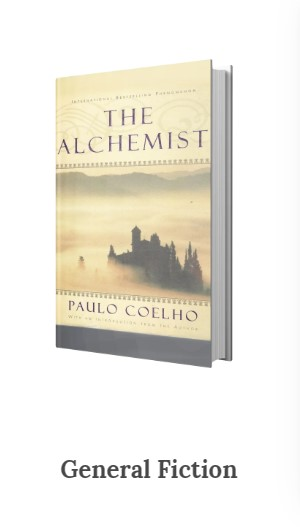
This template serves as a guide for any genre. You can specialize it further as you dive more into your book and figure out where it’s going.
Character Development Sheet
Writers use character development sheets to outline and detail various aspects of a fictional character. It includes sections or prompts covering the character’s physical appearance, personality traits, background, motivations, goals, fears, strengths, weaknesses, and other relevant information that helps flesh out the character’s identity.
A character profile worksheet aids writers in creating well-rounded and believable characters for their stories. You can start by copying and pasting this free template and filling in all the information for your character.
Final Remarks
Strong and believable characters don’t come quickly and they don’t come easily. Crafting the best possible character for your novel is going to take a decent investment of both time and effort.
You have to delve into every little nook and cranny of your character’s mind, heart, and past. Not only does every little detail need recognition but it all needs consistency to match up.
Use these steps, templates, and questions to build the strongest, most detailed, and realistic characters you can. Once this is done, you’re well on your way to writing an unstoppable book.
Here is a list of common questions that authors ask about developing character profiles:
What is a character profile?
A character profile is a detailed description of a fictional character. It includes information like their appearance, personality traits, background, motivations, and role in the story.
Why is it important to create a character profile?
Creating a character profile helps you understand your character better. It makes them feel real and consistent throughout your story. It also helps you keep track of important details about your character so you don’t forget them.
What should I include in a character profile?
In a character profile, you should include details about your character’s physical appearance, personality traits, backstory, goals, fears, strengths, weaknesses, and any other important information that shapes who they are.
How do I start creating a character profile?
Start by thinking about who your characters are and what role they play in your story. Then, jot down details about their appearance, personality, and background. Consider what motivates them and what obstacles they might face.
How can I make my character profile more realistic?
To make your character profile more realistic, think about how real people behave and what influences them. Give your character strengths and weaknesses, quirks, and flaws. Consider how their past experiences have shaped who they are.
Can I change my character profile as I write my story?
Yes, you can change your character profile as you write your story. Sometimes, as you get to know your character better through writing, you might discover new things about them or realize that certain details don’t fit anymore. It’s okay to update your character profile as needed to keep your character consistent and true to your story.
Related Posts
![how to write character biographies How to Outline a Novel in 7 Steps [+Free Template]](https://www.squibler.io/learn/wp-content/uploads/2021/12/How-to-Outline-a-Novel-in-7-Steps1.jpg)
Published in What is Novel Writing?
Join 5000+ Technical Writers
Get our #1 industry rated weekly technical writing reads newsletter.
How to Write a Character Bio
A character bio is a brilliant tool for screenwriters. There are many benefits to creating a character bio for your primary characters (as well as your secondary characters if you want to).
The main advantage is that an audience is more likely to connect strongly with a character if they fully understand who they are as a person and their goals and motivations - and a character bio helps a writer create this feeling.
What is a character bio?
A character bio is an overview of your character. It acts as a template when writing to avoid inconsistencies in both behaviour and physical description. A character bio can be anything from basic background information to a detailed back story and motivations.

Why should screenwriters use a character bio?
On a practical level, it helps avoid inconsistencies in a character’s description and behaviour. On a deeper level, a character bio will improve character development and ultimately strengthen their character arc, which is essential as it helps your audience connect and relate to them, and therefore feel more immersed in your story.
How long should a character bio be?
The length of a character bio depends on your preference as a screenwriter and your screenwriting process . You might want to keep it brief and focus solely on the basics. Or you might like the idea of creating a complete profile that you can use to really get under the skin of who your character is. Neither answer is right or wrong; it depends on your preference and what would be the most useful to you.
Do you need a character bio for every character in your screenplay?
Not necessarily. Typically, character bios are the most useful for your protagonists as they’re the ones who feature prominently in your screenplay and are crucial to the story. However, you might also find it helpful to create character bios for any essential secondary characters.
Start your character bio with the basics
Begin crafting your character bio by starting with the basics. Your character’s name (and nickname/s), gender, age, nationality, race and where they live. Physical details including height, weight, build, eye colour, hair colour, and characteristics like any scars, birthmarks, tattoos and piercings.
This essential background and the physical details will help you further develop your character bio.
Develop their personality traits and personal background
How would you describe their personality? Are they an introvert or an extrovert? Are they an optimist or a pessimist? What mood are they usually in? What’s their general attitude like? Can you list some of their strengths and weaknesses? Do they have any unusual mannerisms or habits? Which character archetype are they?
To craft a character’s personal background, look at their upbringing, family, and friendship circle. Are they well educated? What career have they had? What’s their work/life balance outlook? Do they have any solid personal ethics? What are their life’s defining moments and milestones, and how did they react to them? What’s their philosophy? What ultimately motivates them?
Ask yourself questions to create their character bio
Fully flesh out your character by asking yourself questions about them. Here are some questions you can ask:
What drink would they order at a bar?
Where would they book a holiday if they could go anywhere in the world?
How would they react if an elderly person needed help with their shopping?
Are they a dog or a cat person?
No matter how basic any questions might seem, each time you answer one, you naturally develop your character and get to know them. You could even go one step further and interview your character to see what answers naturally flow when it feels like they’re physically sitting before you.
Create a template for each character bio
Writing your screenplay with a character bio template to hand will ensure you’re writing your character with these details and background in mind. A template can be an excellent reference to avoid inconsistencies and help you determine how a character might act in a given situation.
Always look at room for development
How can you add further depth to this character? How can you ensure they feel three-dimensional rather than two-dimensional?
To create characters that an audience feels they know as if they’re real, always look for ways to develop your character further. This might come naturally in your script when a story throws obstacles that stand in the way of a character achieving their ultimate goals and ties into their character arc .
You might also find it useful to complete a screenwriting exercise we love, like character creation step by step .
Don’t include everything in a character bio in your story
A character bio is a tool for you as a screenwriter. Your audience doesn’t need to know all those details, so be mindful of only sharing whatever is necessary to help them understand your character better.
Keep the character’s goal in mind
A character’s ultimate goal is a critical component of the story, as well as their own development. Keep this goal at the forefront of your character bio to ensure it matches both the character’s journey and the story.
If you need help with building your characters and getting your ideas on paper be sure to download our FREE screenwriting software today.
Level-up your screenwriting software
With Arc Studio, you stay focused while writing your screenplay, craft better stories, and collaborate with ease.
Add the template to your Arc Studio Pro account
text content
Download your free template now

Danielle Owen-Jones is a professional writer and the author of two romantic comedies, Stone Broke Heiress and Stuck With Him, published worldwide by Bookouture (Hachette UK). Danielle worked in journalism and PR before launching a freelance content writing business alongside writing her novels.
Arc Studio is the new standard in screenwriting software: stay focused, craft better stories, and collaborate with ease.
With Arc Studio pro, you stay focused while writing your screenplay, craft better stories, and collaborate with ease.
Receive a free screenwriting book
Get your free ebook now!
Learn from the film industry’s top screenwriters
Our new podcast, How I Write: Screenwriters Share Their Creative Processes, launches Nov. 12th.

Get an actionable guide for writing your first script from HBO writer David Wappel. He takes you to a fully written script, step-by-step. Totally free for a limited time only.
Ready to get started?

The most efficient, elegant, intuitive, and all around user-friendly screenwriting software I've ever used — and I've used them all.

Arc Studio lets us collaborate across the entire season and manage incoming notes or changes without ever losing track of a single thing. Can’t imagine ever going back.

For decades I've been searching for a seamless screenwriting app and and everything has come up way short – until Arc Studio. Writing and collaborating is easier than ever and it gets better every week. Well done!
Please check your email to confirm and download The Action Guide to Screenwriting . Have fun writing!
Arc Studio is the new industry standard in screenwriting. We go beyond formatting, with next-generation story-building and real-time collaboration.

How Do You Write A Character Bio? The Road to GREAT Characterisation
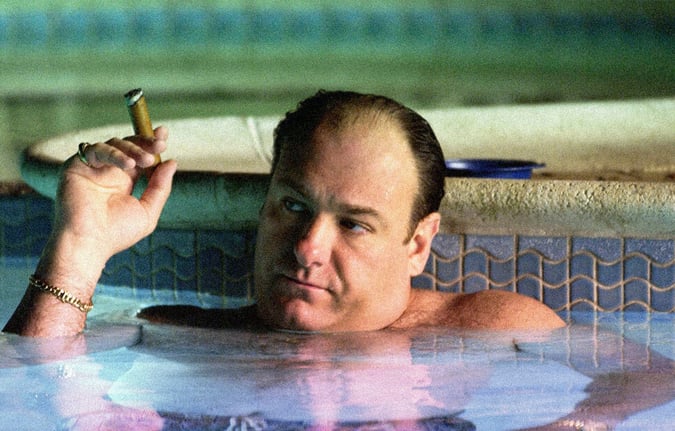
Character bios can be an essential part of writing your character. There is no story without a character, just as there is no character without a character bio.
Every writer needs some semblance of a bio before they can start writing because it is the only way to truly know who your character is. Without one, it’s harder to feel their existence as something tangible.
The best way to think of a character bio is as it being their passport. A certificate of identity to give them life and authenticity. It’s an official record of them, something to prove their existence on paper.
Characters are built through their bios. They start out as non-existent or simply ideas in the head, but through the process characters become layered. They become real.
In this article, we’ll highlight the key tips to creating your own character bio. We’ll provide the essential information on building a bio that both births a character and helps establish the story.
It might often feel like extraneous work, but writing a character bio can be the difference between a two-dimensional functional character and a rich, layered one.
Table of Contents
The writing style of character bios, voice of a character bio, 1. outline the basics of your character(s), 2. add life to a character, 3. add color to a character, 4. immersion in a character bio, the character’s purpose, how character bios help writers, why a character bio is important to the writer and the story, an acronym to help:.
Character bios can be created in multiple ways. There is no set way. Ultimately, they must be crafted in the best way for the writer. And most importantly, they need to be accessible and easy to understand.
Some ways of creating a character bio include…
- On a blank document: Probably the most common way. This is easy to execute, follow and allows for you to let rip with words. Just fill a document with as many words as you can about your character. Let it all spill out, without limitations.
- On PowerPoint: This allows a character bio to become more like a character portfolio. PowerPoint allows both text and images to be added, which gives a visual dimension to the character. It’s also easy to access and one can select what slide is needed for certain writing times.
- On a Spreadsheet: Establishes a critical perspective, as the writer will be dissecting and labelling each aspect that makes up the character.
- In a Notebook: Having a hard copy character bio makes it easier to access when writing on a laptop. This way multiple tabs aren’t open. It can help you not only literally separate out your character bio from your other writing but mentally too, allowing you to work on your character bio and feed in its details to the wider document.
- On Post-Its: Easier to add new details to a character, and have them around you when writing.
All of these different styles have their own benefits due to their form. PowerPoint is arguably the best way as it lays out each aspect of the character clearly, and encourages the visual side of the character too. This is ultimately what character bios are best for, visualizing your character.
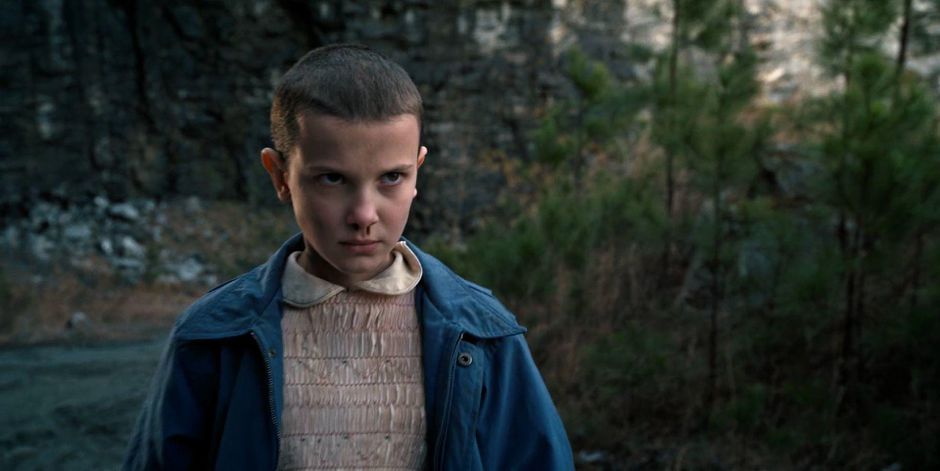
Another feature of the style of writing a character bio is what personal tense to use. Both First or Third person could be used. And using either of these styles when writing a character bio can have a different meaning…
- First Person: This suggests that the writer is the character, so it becomes more personal and intimate. However, it also makes it harder for the writer to view themselves just as a writer if they are the character, as the lines could become blurred, and confusing when dealing with multiple characters.
- Third Person: This provides a more analytical character bio as the writer is shaping who/what they want the character to be, so it is somewhat easier to access them as a character. However, it can distance the writer, so they are less involved in the world they are creating, as they are on the outside looking in.
Both styles of voice have their pros and cons, but both do formulate solid character bios that will allow the characters to come to life. Some writers may prefer a more immersive approach, some may relish a more objective, analytical approach. But both allow the writer to sit with their characters and let them spill out onto the page.
Finding the voice to write in for your character bio is one thing, but what are the key elements to tackle when writing your character bio? Let’s take a look…
The starting point of a character bio is to determine the basics of the character(s). Starting the character bio with the basics is essential, it’s like laying the foundation for a house. Without the foundation it becomes unstable. The same goes for character. If you don’t know your character solidly, then the story will fall apart.
Basics include…
- Name – Obviously, the major starting point. It is how your character will be known and in many ways, it defines them. So, the name has to represent who they are. And a distinctive yet believable name is always the best bet, particularly when it comes to main characters.
- Physical appearance. What they look like is obviously important for reading through and remembering the characters but also for aspects of production like casting.
- Personality traits. How does their conflict manifest? What are they like? What kind of figure do they cut within the action?
- Family. What are their relationships like? How have these relationships shaped them into who they are?
- Where the character is from. What is their background? How does this manifest, for example, in their accent, in their outlook and in their character arc in general?
- Where the character lives. What is the context they live within? And most importantly, how does this shape their character arc and the story overall?
- Career. What do they do for a living? Whether important to the story or not, their job and how they spend their daily life is important to understand.
When determining the basics what needs to be apparent is the character’s relatability. Their personality traits, past, relationships and context help to provide relatability, giving the audience an insight into the character and an opportunity to connect with them. Without this, the story is harder to find a way into.

After determining the basics of a character in their bio, the next step is to go more in-depth. This stage allows a writer to establish a character’s goals, flaws, and quirks. It is a character’s goals and flaws that make the story because this it almost always what the plot revolves/evolves around, particularly as it pertains to the protagonist .
What to add to develop a character bio…
- The character’s wants and needs.
- Their niches and quirks.
- What are their goals?
- What are their flaws and foibles?
By being thorough at this stage, the character is getting more and more real. They start to take their first steps. Every minor detail that may seem unnecessary e.g., a character’s minor behavioural ticks, is vital to a character bio.
For example, by knowing some small detail about a quirk of behaviour, a character’s state of mind, background, self-esteem and sense of self can all be determined.
It is these intricate features that not only bring life to a character bio but also improve the narrative. Each detail of the character works synchronously with the story as a way to build on the plot. But it also ensures each character’s reaction fits the plot and explains who they are.

Adding color acts as a double meaning in this instance. The literal meaning is to choose colors that can be associated with the characters (through clothes, for example) to match their personality/moods.
It’s this meaning that aids in furthering the character bio as the colors chosen can represent who the character is and what they will become. Breaking Bad is perhaps the greatest example of this. Throughout the series, the colors are used to represent the characters’ shifting motivations.
Color also carries the meaning of making a character real. Adding color as visualizing them, how they walk, how they talk, how they interact. What is it that makes them real? That is the next step of writing a character bio.
“I demand the right to be them, I demand the right to think them.” – Quentin Tarantino
To add color the writer has to completely submerse themselves into the characterisation- every choice the writer makes regarding the character, particularly in relation to visuals needs to weave into narrative and characterisation.
The goal of the character bio is to make a character real. And the only way to make a character real is for the writer to become one with the characterisation. This means looking into and focusing on aspects that seem unimportant or useless.
A character bio needs to act like an extension of the writer’s self, drawing from themselves and their real life in general. It is a part of them but it’s not them. By adding color the writer is able to work multidimensionally between building the character and partially being the character.
There needs to be the ability to move between perceiving how the character functions as a person, whilst disconnecting in order to look at the big picture of crafting the story.

Following on from adding color to a character bio, and the necessity to work multidimensionally, is immersion. To become immersed in a character bio means the ability to view yourself as a writer whilst also having the perspective of a character.
The writer’s voice needs to become the character’s too.
Exercises for the writer’s voice to become the character’s include…
- Write a journal/diary entry as the character: This allows the writer to directly access the character’s thoughts and behaviour.
- Write a letter from the character to another, or even to the writer: This technique encourages two different styles, one being for the writer to become the character, and the other being the writer accessing the character’s voice whilst being aware of themselves as a writer.
- Carry out an interview with the character: By doing this the writer is able to concurrently carry the role of the writer as well as the character.
- Make a specific list about your character’s likes and dislikes – including, for example, everything from their favorite color to their favorite food to their favorite pastimes.
These exercises are almost a form of method writing , getting into the character’s headspace and indulging in them as if they were real. Again, some of these details may seem unnecessarily specific, but they might help in building a convincing and realistic vision of your character.
The character’s purpose is what needs to shine through the bio as it is that which will be explored and built on throughout the narrative itself. The writer being able to find the character’s voice within making a character bio helps to make the character as close to real as possible.
By being clear and pliable, the character bio guarantees that even if the story alters as it is created, the core of the character(s) can remain the same. And this core is the character’s purpose. This is what’s driving them through the story and consequently, particularly in relation to the protagonist , driving the story itself.
You might find your character’s purpose when writing the bio, or you might have it already before the bio. Either way, a key aim of writing a character bio should be to understand what that character’s purpose and function is within the story as a whole.
Without purpose, the character could seem two-dimensional or unnecessary, no matter how fleshed out in specific detail they are.

Character bios are priceless to a writer. They allow writers to get to know their character(s) much as they would a person in real life. If a character doesn’t feel real and relatable then the audience or screenplay reader will struggle to connect with the story.
They help the writer to conceptualise all that exists in their head. Before creating a character bio, a character is simply a writer’s thoughts of a person. But once the bio is on paper those thoughts start the process of transforming into a fully-formed person.
- A character bio can also help writers to establish the arc that characters will go on throughout the narrative.
- It acts as a blueprint. If a writer loses track of their character(s) and their arc, the bio is there to act as the heart of a character.
- It is what births and maintains the character’s existence.
Character bios help provide security for the writer as they can map out the story through the eyes of the character(s). This means that no matter what happens in the writing process the bio is always there to refer to.
The ability to get inside a character’s head is essential to a successful narrative, as often the audience perceives and responds to the story through their relationship to the characters.
Character arcs are a key part of the narrative or are the narrative itself, and a crucial way to track an arc’s success is with the bio. It is the character’s flaws that are tied up with the story and the flaw that needs to be resolved or handled by the story’s end.
A bio is what fleshes out characters, making them feel human. They become a part of the world you are creating, both feeding into and feeding off the depth you are gradually building.

They can also be important to both the writer and the story for continuity reasons.
- Change happens in a story, both in the actual narrative evolution and redrafts.
- So, for a bio to act as a continuity guide provides assurance that characters won’t become debased.
- They will retain their strengths as independent characters whilst ensuring the story itself doesn’t fall flat.
Connection is what a character bio provides. They allow the writer to establish the traits of that character that an audience can connect/relate/empathise with. Every character needs to have a perspective on humanity whether it be a positive or negative one. And crafting a bio helps identify what this perspective looks like.
As discussed, there are multiple ways to write a character bio, but it must be…
- E xpressive
So, think of CREATE when creating a character bio, and you’ll be in the best place possible to write one.
A character bio is a tool to helping you understand your character and what shapes them. It brings a character to life on the page. And it is this aliveness that feeds the life of the story.
Bios are pivotal to both the writer and story as they are the glue that holds it all together, whilst ensuring organisation and coherence for the story and writing process.
– What did you think of this article? Share It , Like It , give it a rating, and let us know your thoughts in the comments box further down…
– Struggling with a script or book? Story analysis is what we do, all day, every day… check out our range of script coverage services for writers & filmmakers .
This article was written by Libby Laycock and edited by IS Staff.
Get *ALL* our FREE Resources
Tackle the trickiest areas of screenwriting with our exclusive eBooks. Get all our FREE resources when you join 60,000 filmmakers on our mailing list!
Success! Thanks for signing up, now please check all your email folders incl junk mail!
Something went wrong.
We respect your privacy and take protecting it seriously
4 thoughts on “How Do You Write A Character Bio? The Road to GREAT Characterisation”
Dealing with characters that are 98% Native American, I knew from the start in writing the book, I needed to distinguish the characters.Thank you for the information it was very helpful in going forward with the teleplay.
This article is definitely a good, clear reminder why character matters in driving the plot. If your plot isn’t working, the answer often lies with character; and as painful as it is, that means you have to step back from the direct script writing and do more research. That’s what this article has made me do. Thanks.
Thanks Angela, glad we could help!
Leave a Comment Cancel reply
Improve your writing in one of the largest and most successful writing groups online
Join our writing group!
Character Bio Template for Creating the Perfect Characters

by Holly Riddle
The best books offer characters that feel like real people, characters that are so fleshed out and thorough that you feel as if you really know them. But creating those types of characters is easier said than done!
Once you sit down to start drafting a new short story or novel, you may find that your characters are feeling lackluster at best, or entirely dull at worst. How can you fix this? No matter what stage of the writing process you may be in, creating a character biography using a character bio template can be a great help.
What is a character biography?
A character biography is a reference sheet that tells you everything you might need to know about your character, for any scene that you write. A character bio includes information on your character’s background, personality, day-to-day life, appearance, and more. While not all this information will make it into your story, it’s still useful for plotting your character’s arcs.
Why is having a character biography important?
If you consider yourself more of a pantser than a plotter (i.e., the type of writer who goes into drafting flying by the seat of their pants versus the type of writer who plots and outlines their work ahead of time), then you may wonder if you really need a character biography—especially when you look at character bio templates that ask you for far more information than you might think you need (do you really need to know your main character’s childhood pet’s nickname?).

However, no matter your drafting style, a character biography can be an invaluable resource. The more information you have at the ready, the more well-rounded your characters will be. You might even find that having a character bio template as you write will help you unravel other writing issues that go beyond flat characters, like plot holes or character or story arcs that don’t quite arc .
Things to keep in mind before you write your character biography
Before you write your character biography (using our handy template below), there’s one big thing you need to think about: each character’s purpose within the story .
Often, writers will begin building a character first, thinking about things like personality and appearance and motives—and then wait until they’ve developed this character before actually giving the character a purpose within the story.
This can be problematic for a few reasons, but primarily because you may end up trying to force characters into roles where they don’t belong.
Before creating any character bio or filling out any character template, consider why you need this character in the first place. How are they going to pull their weight?
Think beyond the very baseline role that they might play, as, for example, a main character, love interest, antagonist, or the comedic relief. Think about what they need to be and what they need to offer the plot and your other characters. What makes them so essential to the plot that they absolutely cannot be cut from the story or book?
Once you nail down why this particular character must exist in your fictional universe and exactly what they offer the plot and main character that makes it so, you can begin filling in the more extraneous details that might not matter quite as much, such as basic info and appearance. On the contrary, once you decide on your character’s purpose, you may just find that those details aren’t so extraneous and are, in fact, all the more meaningful.
How to write a character bio (using a template)
When you download your character bio template and begin filling it out, whether you print it and write out all the details by hand or type everything into the Word doc, you’ll notice there are a few details that you need to include.
This is likely all information that you have stored away in your brain somewhere, so getting it down on the page should be no problem.

Think all the information that anyone might be able to find out about your character if they either knew them as a brief acquaintance or looked them up online and discovered a social media profile.
This might include things like:
Nationality
Religious beliefs
Home town and current place of residence
Marital status
Economic status
Core values
If there are any stand-out likes or dislikes, or pet peeves, you can also list those here. For example, does your character prefer to only communicate via snail mail, or does your character dislike chocolate with a passion? List it here!
Appearance and physical characteristics
Think not just of your character’s physical appearance, body type, and personal style, but also how their appearance impacts how they act and how they’re treated.

Do others approach them differently than they might another character, all because of appearance? Does your character like their appearance? Why or why not? How does this impact how they interact with others?
For many characters, health—or the lack thereof—plays a major role in their decision-making and motives. Think about your character’s health and the areas where they might be struggling.
Does your character drink regularly or have any addictions? Bad habits? Does your character smoke? Were they in any sort of traumatic accidents that have made their health a challenge?
Think about your character’s life up until the point were your story begins. What was it like?
Did they have a good or bad childhood? How were their teenage years? Are there any major changes between the way they grew up and the way they live now (i.e., changes in religion, place of residence, best friends, or social or economic status)? How does that influence their behavior and beliefs now?
In real life, background heavily influences the way a person acts and the choices they make, so the same should apply to your characters.
Relationships
What is your character’s relationship with the other people within the story? How do they feel about the other characters? This includes romantic relationships but also those with friends, family, and work colleagues.
Explore how these relationships and all the emotions that go with them impact how your character behaves.
Personality, mental characteristics, and emotional characteristics
What is your character’s personality? Are they shy? Hot-headed? Temperamental? Stubborn? Does your character prefer being around people just like them, or do they love variety?
When building your character profile, think of both your character’s emotional strengths, as well as your character’s emotional flaws.
Your character’s personality will directly play into their thorn, which leads us to…
Character thorns
A character thorn is something that’s stuck in your character’s side. It’s always there, paining them, nagging at them, making their life a little bit worse.

This thorn will eventually propel them to some sort of action and they’ll eventually learn to either live with, or remove, their thorn, but it needs to be there at the start of their fictional journey.
A character thorn could be a bad relationship with parents, a spouse that always outshines them, or a belief that they’ll never be quite good enough. Whatever it is, though, it’s something they can’t ignore.
Every character needs a desire. What do they want? Or, better yet, what do they want so badly that they’re going to end up going after it over the course of your story or novel?
This desire should make sense according to the other information that you’ve already inputted into your character bio template, such as background, thorn, personality, etc.
For example, a character who grew up in an impoverished household with an emotionally neglectful parent, who doted on their other siblings first and foremost, might desire a high-paying career that will allow them to outshine their sibling while also buying their impoverished parents a new house, thus winning their favor and proving themself better than the sibling.
Character development
Your character’s desire and thorn should play into your character’s arc and development. How will they change over the course of your story?
Consider writing up a brief description about your character’s existence at the start of the story—what their life looks like, both externally and internally—and then another brief description about where you’d like them to end up at the end of the story.
Mistakes to avoid when building character bios
As you consider the above details, make sure you avoid some of the most common mistakes that writers are likely to commit when building out, and then using, a character profile.

Using every single detail in a character bio template
This is the big one.
Yes, you’ll have a lot of valuable information in your character bio template. However, you don’t want to merely dump all of that information into your story as soon as you introduce a new character.
The reader doesn’t need—or want—to know all that information at once. They want to gradually learn that information as they get to know your character, over the course of the story.
Don’t dump everything about your characters’ appearances onto the page at once, either. Doing so can make a passage feel stilted and awkward.
After all, when you meet a person for the first time, you don’t automatically think about every color they’re wearing, every brand of clothing they have on, their hair color, eye color, weight, and face shape, all at once. Instead, you maybe notice a few stand-out features until something gives you reason to notice another detail of their appearance.
Do the same when you begin writing a character’s physical description.
Adding details that don’t make sense
Every part of your character’s life should make sense. Their personality, their decisions, their lifestyle—it’s all a result of things that have happened throughout their life.
Don’t pick personality traits or background information at random. With every character detail, ask yourself, why? Truly think about why your character is the way that they are, and ensure every detail is believable.
Does every character need a character bio?
You’ll find that many characters within your story don’t need a full character bio. Minor characters that only play a small role within your story don’t need to be fleshed out to this degree.
However, it’s advisable to create character bios for all of your main characters, and also your secondary characters , including love interests, villains and other characters whose actions heavily influence your main character and/or the plot of the story.
Remember—every character in a story, no matter how large or small their role, has a background, motives and goals. Sometimes, knowing all this and more can help you make the writing decisions that result in believable characters and plot lines.

The Scribophile character bio template
Need more help?
Download our character bio template for an easy, fill-in-the-blanks approach to character template building.
You’ll still need to thoroughly consider every aspect of your characters’ personalities, lives, backgrounds, motives, and more, but, with our character bio template and comprehensive list of questions, you’ll be that much closer to uncovering all the need-to-know details to bring your characters to life.
Download the Character Bio Template (docx)
Download the Character Bio Template (pdf)
Get feedback on your writing today!
Scribophile is a community of hundreds of thousands of writers from all over the world. Meet beta readers, get feedback on your writing, and become a better writer!
Join now for free

Related articles

What is “Fridging” in Fiction Writing?

What Are Minor Characters? With Tips on Writing Them

What is a Flat Character? And When To Use Them In Your Writing

Protagonist vs. Antagonist: What’s the Difference?

What Is an Antagonist? Definition and 7 Examples

Action and Reaction: How do Characters React?
Character Bio Template – How to Create A Character Bio
August 14, 2023

Creating a new character for your story is magic. You breathe life into a new and exciting character. Apart from that, it is also highly important for writing a coherent and logical story. Hence, you should know your characters (at least) as good as your mother. Pretty hard eh?
No worries, we created a character bio template that includes 73 important questions and attributes you need to answer and define before starting to write your story . The character bio template will help you to make sure that your characters seem real and authentic.
You should fill the character bio template for all your characters. If you recognize that you need to change some attributes of a character, don’t forget to update the template as well. It should really help you to organize your thoughts, to avoid forgetting any important traits or features of a character and to get the full picture of the existing relationships between your characters.
Of course, you can decide about the level of bio detail for each of your characters. But, often, it makes sense to detail them out as much as possible. This will not only give you a better understanding of the potential role of the character in your story but will also help you to describe situations the character is involved in.
Speed up your review rounds for good
Get feedback on videos, designs, websites, and more with Filestage.
What’s a Character Bio?
So, creating a character biography is quite important and will help you to build your story. Of course, you want to start writing. But take this break and start by defining the attributes, features, and characteristics of your characters first. Trust me, it will help you to write a better story.
So, let’s dive into the character bio template.
BTW: We also created a Template that allows you to edit and update your templates easily. The good thing: You can use it for free. If you want to use it, just create a copy of the spreadsheet.
Download a free character bio template
Fill out the form below to get instant access to our character bio template.
To save an editable copy, follow these simple steps:
- Click “File” in the top-left corner
- Click “Make a copy”
- Choose your destination folder
Get the free character bio template
Character bio template, general information.
Full name Nickname: Age: Nationality: Religion: City of birth The current place for living Job title: Employing company: Income: Is he or she married? Mother tongue Birthday: Does he or she own a home? What does the character like? What does the character dislike?
How would you describe the childhood of the character? How would you describe the teenage years of the character? How would you describe the adulthood of the character?
Role and Involvement of Character
What’s the role of the character in the story? How is the character introduced? What’s the first time he is mentioned in the story?
Relationships
Sisters or brothers Wife or husband: Children Grandparents Grandchildren Other important persons: Relationships with other characters of the story: [Character 1] [Character 2] [Character 3] [Character 4] [Character 5]
Physical Characteristics:
Addictions: Bad Habits: Color of Eyes The color of Hair: The color of Skin: Dialect Does the character drink regularly? Does the character have any disabilities? Does the character prefer any proverbs? Does the character smoke? Good Habits: Height: Hobbies: Is he/she wearing Glasses? Is the character healthy or does he have any diseases? Type of Face: Weight: What’s the style of the character? (modern, outmoded):
Mental Characteristics
Education: Intelligent or not? Fears: Life Goals (next 5 years): Life Goals (next 25 years): Self-perception Assumed external perception Self-Confidence: Rational Or Emotional How could you upset this character?
Emotional Characteristics
What are emotional strengths of the character? What are emotional weaknesses of the character? Is the character an introvert or an extrovert? How does the character cope with fury and rage? … with unhappiness? … with rivalry? … with new situations? … with trouble? What’s his or her meaning of life? What would the character like to change in his/her life? What things motivate the character? What situations scares the character? What makes this character happy? Is the character often biased? Does the character prefer to give or to take? Is the character rather nice or rude?
I hope you liked this character bio template. If you have important additional questions, attributes or characteristics that are missing on my list, feel free to leave comment. I would love to add them to the list.
If you’re having trouble getting started on flushing out your character, you can also try using new AI tools like ChatGPT or HubSpot’s content writer to build a rough outline of your character to get started.
Join The Fine Line newsletter
Get exclusive interviews and marketing wins so you can push creative limits without crossing the line. The monthly must-read for marketers in regulated industries.
How to Write a Character Bio
What is a character bio.
A character bio, sometimes called a character profile, is information about your characters that will directly or indirectly inform the story you’re writing.
A character bio can be pages long or can be short and sweet—I.e., Tara, age 15, lives with her father and stepmother, is self-conscious about her height, and has the power of time travel.
Why write a character bio?
Writing a thorough character bio can help you create dynamic, believable characters with depth.
Knowing about who your character is, both on and off the page, can make writing your story easier. Let’s say your protagonist gets on an elevator with a rival colleague, but you’re not sure how to write the rest of the scene. Your protagonist’s character bio—which might include things like how they feel about their career, their insecurities, and how they’ve learned to handle conflict—can help you write a realistic response to that situation.
While you’re writing a character bio, you could uncover ideas for new plotlines or scenes. For example, you decide that the character has a terrible fear of heights. If so, you might consider putting them on the observation deck at the top of the Willis Tower on a first date.
Do you need a bio for every character?
Not necessarily. Character bios are most valuable for primary and secondary characters, or those who feature prominently in the story and undergo some sort of change.
If you’re writing about conflict between parents and their three children, you might need bios for all five characters. Let’s say a family argument erupts while at a fancy restaurant; you don’t likely need to develop a full bio for the waiter who’s left to clean up the food they’ve thrown at each other (though it might be worth it to consider what that waiter’s day has been like).
Plenty of writers work without writing backgrounds for their characters, though you would be hard pressed to find one who doesn’t have some information on a character that doesn’t make the published page.
What does a character bio include?
Your character bios can be as cursory or detailed as you like. Here are points and questions to consider as you write.
Start with biographical basics:
- Age or date of birth
- Race and ethnicity
- Sexual orientation
- Where they’re from
- Where they live
- What they do for a living
- Socioeconomic status
- Physical description: Are they tall, average, or short? Do they have dreadlocks down to their waist or a shaved head? What kind of clothes do they wear? Etc.
- Do they have a family?
As well as information directly related to the story you’re writing:
- What’s the character’s goal? What’s the motivation?
- What are they most afraid of?
- What are their flaws?
- What are their strengths?
- How will they change by the end of the story?
- What is their role in the story?
Questions to get a clearer picture of what they look or sound like:
- What kind of clothes do they wear?
- What’s their hair color and hair style?
- How do they dress?
- Do they have any distinguishing physical characteristics? For example, perfectly straight teeth, a giant scar across their chest, or blue hair? If so, why is this the case and how does it affect their daily life?
- What are their mannerisms like?
- Do they have an accent? How do they feel about their accent?
- Do they have distinguishing speech habits? I.e., do they stop and think before answering a question or do they blurt out their feelings? Does their voice crack when they’re nervous?
Questions to uncover emotional and mental characteristics:
- What does your character want out of life?
- What was their childhood like?
- What are your character’s relationships like? With their parents? With siblings? With extended family? With their spouse or significant other? With friends?
- What are their romantic relationships like?
- Are they good at making friends? Why or why not?
- What kinds of people do they gravitate toward?
- What kinds of people do they avoid?
- Do they have any pet peeves?
- Has your character experienced a monumental or traumatic event? For example, abandonment in childhood or the sudden death of a friend?
- How does your character feel about the way they look?
- Do they have any insecurities?
- How do they feel about their job or career? If they weren’t doing that, what would they be doing?
- What’s their political affiliation?
- What’s their relationship to authority like?
- How do they deal with conflict? With confrontation? With pain? With happiness?
- Do they have any vices?
- What disappointments have they experienced? Successes?
Questions to explore their tastes:
- What kind of music do they listen to? What kind of books do they read? What kind of movies do they watch? Etc.
- What kinds of music, books, and movies do they not like?
- What kind of food do they like?
- How do they spend their free time?
- What kinds of things have they tried and not liked?
How to write a character bio
If you’re feeling overwhelmed by the idea of creating a character bio, consider that it doesn’t have to read like a traditional narrative. It can take any form: a list of bullet points, a question-and-answer format, or roughly scribbled notes. Whatever helps you get to know your character and keep track of the details.
Begin building your character bio with the basics: basic biographical information and their role in the story. You can then write an entire bio from start to finish, considering all the questions above, or you can fill it in as you write your story. For example, let’s say your character is having a particularly good day and her father calls—no, her stepfather—and he has bad news. As you write this scene, you should make some notes on her family history (you didn’t know until now that she had a stepfather) and how she deals with stress or conflict.
Some writers will “interview” their character and write the answers in the character’s voice. This can be helpful when trying to identify a character’s voice and speech patterns or when writing dialogue.
Feel free to tinker with a character’s biography as you write and edit your story. If a trait no longer fits with the arc, you don’t have to be married to it. Let your writing process be fluid and organic.
How to use a character bio
There’s no limit to what you can mine from a character profile, but in general, bios can:
- Create depth in your characters and storyline: Simply understanding who your characters are and what they’ve experienced off the page will help you introduce believable reactions and scenarios.
- Maintain consistency: You can use your bios to track information as you introduce it into the story and reconcile inconsistencies. For example, if you write that your protagonist is shorter than average on page five, but on page ten they reach the top of a library shelf with no problem, you can flag the inconsistency and track the accurate description in your character bio.
- Spark new plotlines: When exploring your character’s background, you discover that, as a child, they wanted to be a musician, so in your story you decide to introduce a plotline in which they secretly moonlight as a jazz singer under a mysterious stage name.
- Fight writer’s block and solve problems: If you’re unsure where to take your story, working on a character’s bio can help you get out of a writing rut.
Other ways to explore your characters
- Take a personality test, like this one from 16 Personalities , answering the questions as your character
- Write a scene from their perspective
- Draw or describe their house in detail
- “Interview” your character, answering questions in their voice
- Write their resume
- Write a few journal entries in their voice
- Ask to shadow someone who has the same job or hobbies your character has
- Go interview someone with similar experiences
- Go explore their hometown
Get more articles like these!
One comment on “ how to write a character bio ”.
THIS IS SO INFORMATIVE
Leave a Reply Cancel reply
Your email address will not be published. Required fields are marked *
Save my name, email, and website in this browser for the next time I comment.
Recent Posts
- Mastering the Art of Sustainable Rapid Releasing
- KDP Global Fund Payouts [Updated August 2024]
- 9 Essential Story Elements to Consider in Every Scene
- Easy Email Marketing Guidelines for Authors: Your Path to Inbox Success

Character Bio Templates: How To Write & Examples

Frequently Asked Questions
Related templates.

Family Mission Statement Templates: How To Write & Examples

Condolence Email Templates: How To Write & Examples

Summary Templates: How To Write & Examples

Confirmation Email Templates: How To Write & Examples

Summary For Linkedin Templates: How To Write & Examples

Event Invitation Email Templates: How To Write & Examples

Scholarship Reference Letter Templates: How To Write & Examples

Personal Mission Statement Templates: How To Write & Examples

Short Bio Templates: How To Write & Examples

Linkedin Bio Templates: How To Write & Examples
How it works.
.png)
Ready to level-up?
Write 10x faster, engage your audience, & never struggle with the blank page again.

A Quick Guide to a Character Bio Template
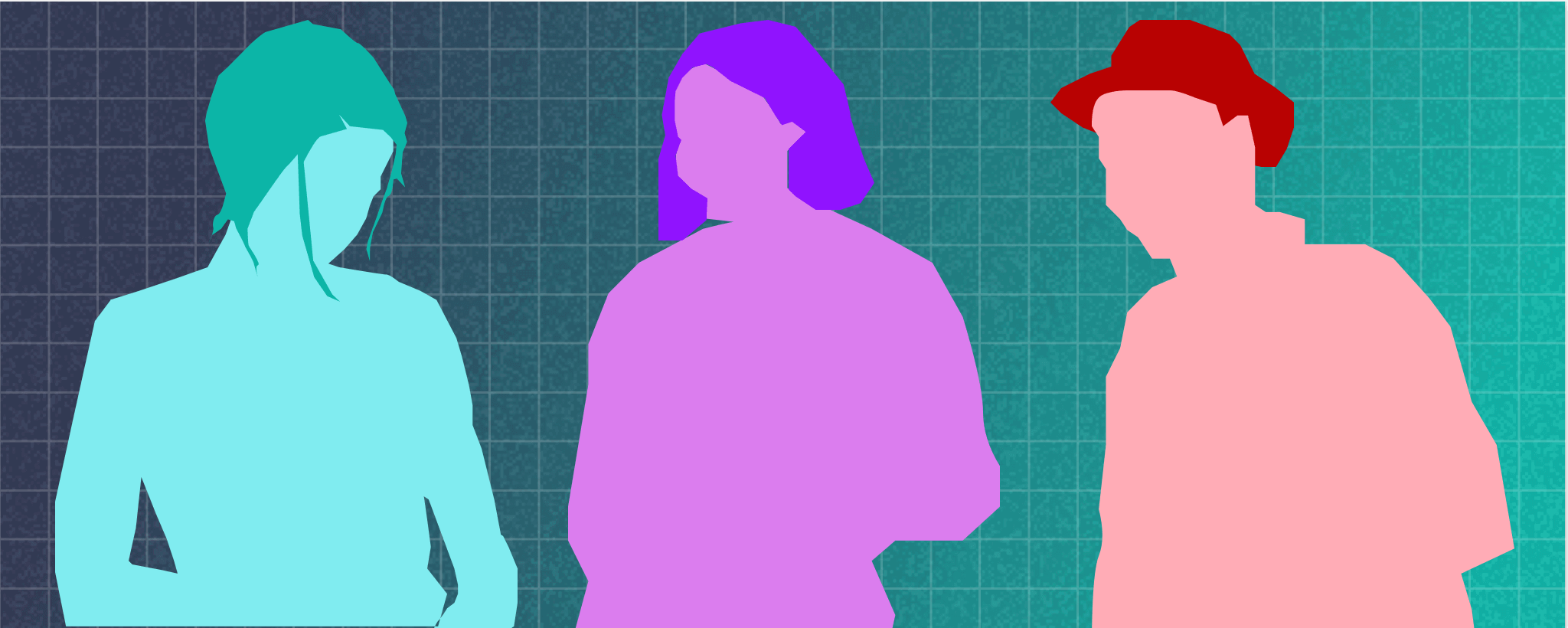
Looking to learn how to utilize a character bio template?
There are approximately 650,000 in-house writers and just over 1 million freelance writers globally, according to statistics ; but what is it that only a few ones can get to the top?
Writing stories that affect readers is not easy for every writer.
You should know the techniques and write carefully and creatively. If you want to learn about how to create characters for your debut novel or short story, we will help you by introducing the character bio template.
Characters in the story are important in the development of the plot. In other words, a plot needs characters to develop through the pages of a book.
Creating a new character may sound quite challenging because you should know how it will develop until the story’s end. However, professional writers do not find it as challenging as most people would think.
They create new characters and give them life while also determining personality, habits, attitudes, way of thinking, etc. for them.
But how do they do so?
As a writer, you should use a character bio template to create the best characters for your stories.
In this post, we will talk about character bio template, its importance, and the elements it includes to transform the characters of your story into the ones that have the same complexity as the real people in society.

How to Write Your Debut Story?
There is no one-size-fits-all approach to creating a novel or short story . Writing a book can take months or years, and you’ll almost certainly face challenges along the way. It’s natural to become lost, so give yourself permission to make mistakes, erase chapters and storylines, and rethink previous occurrences. With a little effort, you should be able to solve most problems.
A piece of literary writing, such as a novel or short story, is made up of five basic but essential aspects. Characters, setting, plot, theme, frame, tone, exposition, ending/denouement, motif, titling, narrative point of view are the components of a literary piece. These vital features keep the story moving along smoothly and allow the action to unfold in a logical and understandable manner for the reader. But in his post, we would only talk about the first component: character.
What is a Character Template (Bio)?
Writing a character biography is crucial and will determine the development of your novel or short story. Of course, you want to begin writing right away. As a matter of fact, everything would go on in a more organized way if there is a plan or thought behind the whole idea. So, you should take a break and begin by outlining your novel or short story and defining your characters’ qualities, features, and characteristics.

A character bio, often known as a character profile, is a few phrases or pages that tell your character’s story. Character bio helps remarkably in character development and plotting out your character’s arc by enhancing your character’s attributes. The bio should allow the reader to feel a personal connection to the figure. In other words, it should make the readers believe the characters when they read the story.
It doesn’t matter what role they play in the story, major or minor, protagonist or antagonist; the character bio should include details that help them seem more human. A character bio template will assist you in writing a better story that attracts and affects its readers. In addition, a character bio template allows you to effortlessly alter and update your templates.
Why Use a Character Bio Template?
For each of your characters, you should fill out the character bio template given that you want to create an impressive character for your story. If you see that parts of a character’s attributes need to be changed, don’t forget to edit the character bio template as well. It should definitely help you organize your thoughts, prevent forgetting any crucial character qualities or characteristics, and gain a bird’s-eye view of your characters’ current relationships.
The level of bio detail for each of your characters is entirely up to you. However, it is frequently necessary to go into as much detail as feasible. This will not only help you grasp the character’s potential function in your novel or short story, but it will also assist you to explain circumstances the character may encounter.
Using a character bio template to record details can make a huge impact on the quality of your writing. It takes time to write a story. Even if you have a great mental image of a character at the start, writing might take months or even years, and you’ll need a consistent point of reference for each of your key characters. If you truly want your readers to visualize your characters as you envision them, you must pay attention to the details.
Characters are remembered and imagined because of the details in their appearance, behavior, mentalities, etc. For instance, everyone who has read Harry Potter knows that Ron Weasley suffers from arachnophobia, Hermione Granger is a bookworm, or Hagrid loves dragons. The creative use of these elements such as fears, interests, etc. helps to paint a vivid image of your characters.
Character Bio Template
The questions in our character bio template will help you figure out how your characters will behave. They specify motivations, which are crucial in determining characters’ behavior. It has the ability to predict how they will react in any given situation. The character bio template has some parts and elements that can help you create your characters while keeping an eye on every detail of their personality. Here are some of these elements:
General Information
Defining the general information of your character is the first thing you should do on your character development path. You should give the readers the description of who is affecting the story, including height, weight, hair, and personal style. Your skill to describe your character plays a very important role here. Avoid common adjectives and cliches for describing your characters. Sure, if you have to characterize a superhero, you could say they’re muscular or attractive, but take it a step further. Think of anything else that your readers should know apart from superheroes being strong, etc.
Here are the things you should consider as the general information of your characters. Remember that all the things on this list may not be applied to your character regarding the genre of your story. For instance, if it is sci-fi, you may not be able to define a job or social status for your character.
- Nationality
- City of birth
- The current place for living
- Employing company
- Marital status
- Mother tongue
- Is he or she a homeowner?
- What is the character’s favorite thing to do?
- What is the character’s pet peeve?
If you want your characters to have depth so that they leave better and deeper effects on your readers, you should think of a background for them. Every real being who exists has a background and comes from a history of its own. Therefore, not thinking of a background that nourishes their behavior today can make your story a naive and unrealistic one. When creating the character bio, ask yourself questions like:
- What would you say about the character’s childhood?
- How would you describe the character’s adolescent years?
- How would you describe the character’s adulthood?
Role and Involvement of Character
Not every character has a major role in the course of the story. You can have major or minor characters and you can choose to have a large number of characters or just a few of them. Accordingly, it is important that you decide about the role and involvement of your characters from the start. To do this, you can ask yourself questions like these:
- What is the character’s involvement in the story?
- What method is used to introduce the character?
- When is he/she referenced for the first time in the story?
Relationships
Depending on your story, your characters may or may not have relationships with others. Think of the relationships of your characters and try to develop their personalities with regard to these relationships. In addition, you should also determine whether there is a family in which your character grows up or is affected by the lack of one. See if you want them to have kids, a wife, a husband, etc. Here is a list of relationships your characters can have:
- Sisters or brothers
- Wife or husband
- Grandparents
- Grandchildren
- Relationships with other characters of the story
Physical Characteristics to Include in your Character Bio Template
To make your characters even more real and perceptible by the readers, you should think of their appearance as well. Draw an image of the characters in your mind and try to describe it the way they are in your mind. Make your readers draw the same image in their minds when they are reading the story. Think of these physical characteristics for your characters:
- Color of eyes
- The color of Hair
- The color of Skin
- Does the character drink regularly?
- Does the character have any disabilities?
- Does the character prefer any proverbs?
- Does the character smoke?
- Good Habits
- Is he/she wearing Glasses?
- Is the character healthy, or does he have any diseases?
- Type of face
- What’s the style of the character? Is he/she modern or old-fashioned?
Consider using an AI image extender to create vivid visual representations of your characters, allowing readers to see them exactly as you envision.
Mental Characteristics for your Character Template
Just as it is necessary for you to develop physical characteristics for your characters, you should also develop mental characteristics for them. Mental characteristics are important in the course of the story as it is the mentalities of the characters that define their reactions to anything that happens in the story. As a result, you should spend some time developing your characters’ mentalities. Here are some hints for your characters’ mental characteristics:
- Intelligent or not?
- Weaknesses
- Self-perception
- Assumed external perception
- Self-Confidence
- Sense of humor
- Rational or emotional?
- What annoys or upsets this character?
Emotional Characteristics for your Character Bio Template
The next thing that you should consider for your characters is emotional characteristics. Ask yourself questions like these:
- What are the character’s emotional strengths?
- What do you think the character’s emotional flaws are?
- Is the protagonist an introvert or an outgoing person?
- What is the character’s reaction to rage and fury?
- What is the character’s reaction to dissatisfaction?
- What is the character’s reaction to rivalry?
- What is the character’s reaction to the new circumstances?
- What is the character’s reaction to troubles?
- What is the meaning of his or her life?
- What in the character’s life would he or she desire to change?
- What drives the character’s actions?
- What situations terrify the protagonist?
- What brings joy to this character?
- Is the character frequently biased?
- Is it more important for the character to give than to take?
- Is the character friendly or obnoxious?
What Is the Best Task Management Tool for Writers?
Anyone who is doing business needs to use a task management tool to get a performance analysis , and every job has several stages to complete until the revenue is made. As a writer, you should divide your writing tasks into various steps.
Certainly, one of these steps is creating a character bio template. On the other hand, many writers try their hand in other creative writing areas such as blogging, journalism, SEO content creation, etc. All these professions require you to have an organized workflow , no matter if you are working as a freelancer or in a team.

Nifty is a task management tool with features and services that are quite useful for anyone with any task management needs. Nifty has something for everyone, whether you’re a freelance blogger, journalist, creative team, or large corporation. Its flexible management and dependence features allow you more flexibility over your editing strategy as a writer or content provider. It also makes it easy to develop a habit of writing every day. After all, you already have a to-do list for each day, so why not enlist the assistance of a strong program like Nifty?
Since there is also a free plan available on Nift y, you can use it at no cost. If you need more features or services, you can choose other plans at different prices.
👉 Try Nifty for Free – thank us later! 🎉
Final Thoughts on Character Bio Templates
As a writer who wants to experience writing the first novel or short story, you should concentrate your thoughts on every aspect of the story. Every component of the story needs your attention and imagination to be developed. In this article, we talked about only one component: character. We provided an introduction to the character bio template that can help you develop your characters the way you should. Using a character bio template, you can create characters that are as complex as the people we see in the real life.
Before writing your story, you should know who your character(s) are and what they may do in the different situations that may happen through the plot of the story. Knowing the mentalities of your characters in advance can increase the possibility of creating a character that would affect your readers through the course of the story. Think deeply about the questions in the character bio template and do your best to create the characters of your story. Of course, while doing all this can be fun, it can also be a bit tedious at times. In that case, you can always use an AI writing assistant . It doesn’t matter if some spelling mistakes or something small like that creeps in, as long as you’re investing time in building your character’s profile. Wish you the best of luck!
Recent Articles:

Top 15 Team Collaboration Software in 2024

10 Best Creative Project Management Software In 2024
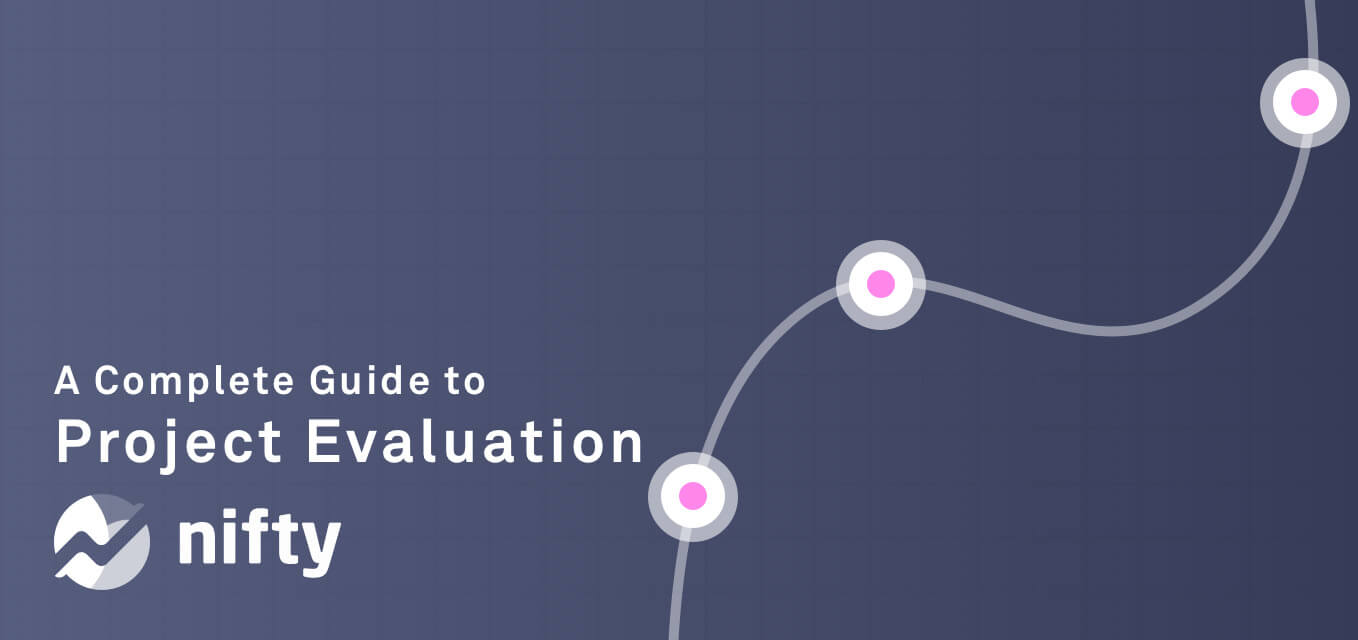
Project Evaluation: A Complete Guide

ALTERNATIVES
Wait before you go.
Do you really want to lose 5 productive hours a week?
Teams waste 5 hours a week on average juggling between tools. Nifty is one app for chat, tasks, docs, and more. Try it for free and see for yourself. We promise you’ll love it.
No thanks, I’ll stick with 5+ tools.

× Do you know these Musicians from their Movies?

How to Write a Character Biography
How to Write a Character Biography: Unleashing the Power of Your Characters
Creating memorable and relatable characters is the backbone of any great story. To truly bring your characters to life, it is essential to delve deeper into their lives and understand their motivations, fears, and desires. One effective method is to write a character biography, a detailed account of your character’s background, personality traits, and experiences. In this article, we will guide you through the process of crafting a compelling character biography and answer some frequently asked questions to help you along the way.
1. What is a character biography?
A character biography is a comprehensive written profile that provides a deeper understanding of your character’s life, including their history, personality, relationships, and aspirations. It serves as a roadmap for writers to explore and develop their characters, ensuring consistency and depth throughout their stories.
2. How do I start writing a character biography?
Begin by brainstorming key aspects of your character’s life. Consider their name, age, appearance, background, and occupation. Then, delve into their family, childhood, education, and major life events. Think about their values, strengths, weaknesses, and how they interact with others. The more you explore, the better you will understand your character.
3. Should I include every detail of my character’s life?
While it is essential to know your character inside out, not all details need to be explicitly mentioned in your story. Focus on the aspects that are relevant to their journey, personality, or relationships. Avoid overwhelming your readers with unnecessary information, but ensure you have a well-rounded understanding of your character’s life.
4. How can I make my character biography engaging?
To make your character biography engaging, treat it as a storytelling exercise. Instead of simply listing facts, bring your character to life by describing their experiences, emotions, and conflicts. Use vivid language and evoke sensory details to immerse yourself in your character’s world. This will not only make the process enjoyable but also help you create a more compelling character.
5. How can a character biography improve my writing?
A character biography provides a solid foundation for your writing. By knowing your character’s background and motivations, you can create more authentic dialogue, consistent actions, and believable character arcs. It also helps you avoid inconsistencies or plot holes that can weaken your story. A well-developed character biography ensures that your characters resonate with readers, making your story more engaging and memorable.
6. Should I update my character biography as I write?
Absolutely! As you progress with your story, your characters may grow, change, or surprise you. Continuously revisiting and updating your character biography allows you to stay connected with your characters and adapt their journeys accordingly. Embrace character development and allow your characters to evolve naturally as your story unfolds.
7. Can a character biography be used for secondary characters as well?
Yes, character biographies are not limited to main characters. Developing a detailed biography for secondary characters provides a deeper understanding of their motives and actions, enabling you to craft more authentic and impactful interactions. Remember, even the smallest of characters can leave a lasting impression on readers when thoughtfully developed.
In conclusion, writing a character biography is a powerful tool that helps you understand your characters on a profound level, creating more engaging and impactful stories. By exploring their backgrounds, motivations, and relationships, you can breathe life into your characters and make them resonate with readers. So, grab a pen and paper, and embark on a journey of discovery as you uncover the depths of your characters’ lives.
Related Posts
What is alfred hitchcock known for, fast and furious 5 the movie cast, amber heard on pineapple express, who wrote your cheatin heart, into the blue actors, books for 12 year olds boy, hallmark right in front of me, the witcher season 2 based on which book, which is better harry potter or star wars, the the movie cast of the hannah montana movie, how many books did cs lewis write, how to make special characters in wow names, the jacobite a steam train in scotland is famously featured in which movie series, how long can you borrow kindle unlimited books, when does directv have free movie channels, what page does holden say he wants to be the catcher in the rye, what did beverly do to eddie in the book, which fate character are you, how to sell a tv show, what channel is nfl on samsung tv.

StageMilk / Must Read Articles! / Making a Backstory Work for You

Making a Backstory Work for You
Developing a character biography that will actually strengthen your performance.
At some point in her training, every actor will be asked to draft a backstory for the character she is working on. If inventing such a backstory is done with the right things in mind, it can be an extremely valuable and grounding exercise. Sadly, though, it is often undertaken without any sense of what makes a backstory actually useful for the actor, and it ends up being forgotten as soon as it is completed. I thought I would set out some principles that help make the the task of composing a character bio or backstory productive and stimulative of the actor’s imagination with regard to the role.
Find Information
First of all, before you embark on inventing anything about the character’s past, it’s important to extract every single bit of information that you can from the script about what the character has experienced to date. You don’t know, upon setting out on working with a script and a role, what will prove important, so it’s important to capture everything that you can. Don’t dismiss anything as minutia or trivia.
It’s your job, as the actor, to serve the writer’s vision, so you want to be sure you have gleaned everything you can from what the writer has offered you in the text. The act of identifying and noting these things will help to trigger your imagination along productive lines. Also, dramatic writing depends on a rich relationship between what is obvious and foregrounded in a text, and what is included as apparent context or background. This means that often the finer details prove to be more important than they sometimes seem to be upon initial encounter. So it’s crucial to identify everything in the script that is pertinent to your character’s backstory and make note of it. Further, focus on what happened, not on what you perceive the character’s feelings to be. “Just the facts, ma’am” was the famous refrain from the fifties procedural Dragnet , and it serves as a good motto for the actor in studying the script: focus on what happened, not on attitudes and emotional states (except where such attitudes and emotional states contribute to actions taken and things that happened).
As you write these things out, be sure to do it from a first person perspective : “I moved to Los Angeles, where I met … and I started …” You want to start to see things from the perspective of the character, and writing in the first person will help you to do that.
It’s your job, as the actor, to serve the writer’s vision
Organise Information Chronologically
Once you have extracted everything you can about what happened to the character in the past and on what choices he or she has made, you’ll want to arrange these things in chronological order, as best you can. Often information emerges in a script in an order that is not chronological, and it’s important to put things in the order that “you”, as the character, experienced them, and not simply leave them in the order that you came upon them in reading the script. The exercise of doing this will actually help you develop a deeper, more intimate knowledge of these events.

If you’re working on a scene that happens in the middle of a script, then events depicted in the scenes in which the character appears that occur prior to the scene you are working on should be included in your account. Again, the act of summarising those events and integrating them into your narrative will strengthen your command of the character’s story and situation.
Look for Patterns
When you have extracted everything from the script that you can about the character’s past, and arranged it in chronological order as best you can, you should start to look for what I call “peaks and valleys”. These are events that are significant moments of personal triumph and defeat for the character you are working on. Moments of triumph are important because they give us a sense of what the character strives for and aspires to, and help us connect to that appetite in ourselves. Moments of defeat are important because they help us to see what the character feels she has been deprived of, that she will seek to recover in the scenes in which she appears. The more the past can be understood in terms of peaks and valleys, the more it will quicken our interest in the character’s quest, and deepen our empathy for her.
[Don’t] simply invent episodes or information for the sake of having a well-rounded character bio
Having done this, you may begin to get a sense of what kinds of things we might invent that will have a good chance of being truly relevant to our work on the role. There may be significant “peaks” that can be added to the narrative: a moment when a parent expressed pride in “you”, (the character). The beautiful beginning of a significant romantic relationship, or a moment when “you” stood on principle and emerged victorious. Similarly with “valleys”: a major heartbreak can be invented, or a betrayal by a trusted friend or romantic partner, or a public humiliation. We should look for these events to be connected somehow to the events of the script; if the script is a story of the search for romantic fulfilment, then past romantic successes and defeats will be valuable to explore. If it’s a story of political intrigue, then early awareness of injustice or its correction may be useful. The idea is to explore things that speak to the issues and experiences explored in the script, and not to simply invent episodes or information for the sake of having a well-rounded character bio.
The incidents that comprise the peaks and valleys, both the ones supplied by the writer and the ones that you invent, can be explored through a combination of daydreaming and journaling, so that the episodes in question become more specific and vivid, and begin to exist in your body as lived experience, and not simply as facts understood from reading a script. But that is a story for another day.
By developing a backstory on the strong foundation supplied by the script, and then by adding incidents that are relevant to the journey of the character and are packed with significance by virtue of being a “peak” or a “valley”, the actor can stimulate her imagination in fruitful ways and propel her into the work on the role.
Learn more about Andrew Wood
About the Author
is the founder of the Andrew Wood Acting Studio in Los Angeles, California. The studio has been recognised by Backstage as a "Top Los Angeles Acting School". He has an MFA from the Yale School of Drama in directing, and a Ph.D. in literature from Stanford University.
You might also enjoy
Soliloquy Twisting: To Be, Or Not To Be… An American Politician?
Why Accents are Important for Actors
Christmas Gift Ideas for Actors
Tackling the Canon: Why You Should Read More Plays and Watch More Films
Leave a Reply Cancel reply
Your email address will not be published. Required fields are marked *
Save my name, email, and website in this browser for the next time I comment.
Please enter an answer in digits: one × one =

- Bournemouth
- King's
- University of East Anglia

This is exactly what the House of the Dragon characters would have as their Tinder bios
Their family WhatsApp group would be just as explicit tbh
I cannot fathom the chaos that would be sown if Tinder existed in Westeros. The Targaryens are a crazy horny family (often at it with each other), which was best shown by the boatloads upon boatloads of silver haired Targaryen bastards Rhaenyra manage to recruit as potential dragonriders. And that was just in King’s Landing – half of the House of the Dragon has been living on Dragonstone for years, there could be just as many bastards hiding there, or anywhere in Westeros.
The Targs get at it. So, in the spirit of romance, here’s what each House of the Dragon character would have as a Tinder bio.

Bio: “DTF tonight?”
Anthem: Tonight (I’m Lovin’ You) – Enrique Iglesias
Let’s start with Aegon, who would undoubtedly be Westeros’ most prolific swipe fiend. His fingers would be worked to the bone by the sheer frequency of his swipes. Of course, now, he’ll have to get someone to help him out with that as I don’t imagine his burned fingers would work too well for the task, they’d probably stick to the screen or something similarly gruesome. I guess, it’ll be Larys who’d be helping him out with that as we saw them sneaking out of King’s Landing together in the final minutes of season two. I shudder to think what Larys clubfoot would get up to on Tinder.
Ser Criston Cole

Bio: “Looking for love, let’s use the six months it’ll take for you to help me strip my armour off to get to know each other”
Anthem: Hero – Enrique Iglesias
The Lord Commander of the Kingsguard would be another Westerosi Tinder fan. What sets him apart from again is that he’d fall madly in love with every girl on the app and be getting his heartbroken on the daily.

Bio: “Help me win the crown and ask nicely, and maybe I’ll sit on more than the Iron Throne.”
Anthem: Good Luck, Babe! – Chappell Roan
Rhaenyra is another House of the Dragon character that would get up to some shameless shenanigans on Tinder. The rightful Queen of the Seven Kingdoms (yeah I said it, and what?) is also the queen of inappropriate romantic choices.

Bio: “Mummy to four beautiful babies, if you can’t get on board with my kids then get lost.”
Anthem: Brown Eyed Girl – Van Morrison
Alicent loves a romp in the hay so her House of the Dragon Tinder bio would be suggestive but it would defo be a secret account. She can’t ruin her good girl reputation after all.

Bio: “How do you filter by age on this app?”
Anthem: We Are Family – Sister Sledge
Daemon would unquestionably use Tinder to get up to some adult fun, but in this make believe world in which random 21st century phone apps and dragons both exist, he’d spend more time looking for a little lovin’ on Ancestry.com.

Bio: “Looking for someone to catch my eye. I’ll show you my massive dragon.”
Anthem: Mrs. Robinson – Simon & Garfunkel
Tinder wouldn’t be the right app for Aemond in all honesty. One, Aemond likes to find much much older woman, and two, he’d then want to have have weird Freudian naked cuddles being cradled in her lap. Shudder.
Otto Hightower

Bio: “Widower. Likes long walks on the beach, Sunday roasts and Machiavellian political manoeuvring.”
Anthem: My Heart Will Go On – Celine Dion
Otto is another who probably wouldn’t use Tinder all that much, that being said, if he turned his skills at manipulating kings to the world of dating apps, he’d be literally the most toxic person ever.
King Viserys

Bio: “Give me some sons and I’ll give you my heart, big plus if you get on well with my daughter.”
Anthem:Killing Me Softly With His Song – Fugees, ft. Lauryn Hill
With his wife gone, Viserys wouldn’t be in a rush to find love again. But he would be in a rush for some sons to secure the future of the realm. So he’d see Tinder as a means to an end.

Bio: “Don’t want kids. I just wanna scheme. Whiteworm.”
Anthem: Paint The Town Red – Doja Cat
Mysaria would be that one girl who’s a serial Tinder window shopper. For her it’s just one massive game of smash or pass.
For more like this look at what each House of the Dragon character’s Tinder bio would be a nd all the latest news, drops, quizzes and memes, like The Tab on Facebook .
Related articles recommended by this author:
• This is which House of the Dragon character you’d be, based on your degree alone
• Here’s exactly how House of the Dragon ends, if you don’t wait to wait till season three
• House of the Dragon producer finally explains why Daemon stayed at Harrenhal for so long
Featured image via HBO
I learned the best interview habits to land my dream job by practising with the Meta Quest 3
This is a serious game changer
What subject to study at uni in 2024 to earn the most after graduating
Law grads make less money than sports science students and I’m shook

Blake Lively accused of ‘using’ Taylor Swift amidst It Ends With Us PR scandal
She has allegedly been ‘name-dropping’ her best friend to distract from the feud

It was a chaotic mess once again, so enjoy these 23 memes about Emily in Paris season four
I can’t keep defending Emily like this

Everything going on right now after luxury yacht sinks off Sicily with 22 people on board
Six are still missing, including British billionaire tech tycoon Mike Lynch

What’s going on with Disney saying a man can’t sue for wife’s death due to Disney+ account?
Jeffery’s wife sadly passed away from a severe allergic reaction whilst dining at Disney World

Who is Alex Neustaedter? Inside his insanely private life outside the It Ends With Us spotlight
Of course he’s an environmentalist

Tom from Love Is Blind UK did a TikTok Q&A and spent most of it gushing about Tasha
He said they had ‘an incredibly strong connection’

Revealed: These unis officially spend the most outrageous amounts on takeaways
What the hell does Oxford do to students?

Joseph Quinn and Doja Cat: A timeline of the rumoured romance and its hilarious origins
It was love at first tweet

There were actually 11 engagements during Love Is Blind UK, and we only saw six of them
I feel robbed!

Ashley Park lied to Lily Collins to hide relationship with Emily in Paris co-star Paul Forman
She denied anything was going on between the pair

DNA tests to sex timelines: Here’s all the Gypsy Rose pregnancy drama if you can’t keep up
Ryan is BRAVE to delay the paternity test

Disney cancelled Star Wars show The Acolyte and people are fuming
Rip to the lesbian space witches

JoJo Siwa claims Nickelodeon ‘blackballed’ her immediately after she came out as queer
Nickelodeon has since responded that it ‘valued and supported’ JoJo throughout their partnership

Chappell Roan finally speaks out about release date for her new song, The Subway
She has been gatekeeping a banger for her live audiences only

Cancelled shows and book deals: How his breakup is already a career disaster for Tommy Fury
He really isn’t going to come out of this well

Everyone’s begging for an Alicia Silverstone health update after she ate a poisonous plant
She’s not been heard from since

Chappell Roan rants at ‘entitled’ fans and ‘creepy behaviour’ as she tackles rapid rise to fame
Social media can’t decide if she’s right or if she’s ‘not cut out’ to be a popstar

Influencer who hid her used underwear in supermarket bakery could face serious legal action
This is genuinely vile behaviour

From Grey’s Anatomy to Toy Story, Meemaw from Young Sheldon has an insane acting past
She was literally my childhood and I didn’t even know

Raygun’s coach voiced concerns over the quality of her routine before disaster performance
Her coach ‘criticised’ her for being ‘too cautious’ before Olympics

3 years after fall of Kabul, US Congress has still not acted to secure future of more than 70,000 Afghan evacuees in US
Fellow for the Middle East, Baker Institute for Public Policy, Rice University
Research Manager, Edward P. Djerejian Center for the Middle East, Baker Institute, Rice University
Disclosure statement
The authors do not work for, consult, own shares in or receive funding from any company or organisation that would benefit from this article, and have disclosed no relevant affiliations beyond their academic appointment.
Rice University provides funding as a member of The Conversation US.
View all partners
Amid the chaos that followed the U.S. pullout of Afghanistan on Aug. 15, 2021, the Biden administration declared that evacuated Afghans would be allowed to enter the U.S. via humanitarian parole . The initiative would provide them with temporary access to American soil, but not with a pathway to permanent residency.
In the weeks that followed, approximately 70,000 Afghans seeking to flee the returning Taliban government were evacuated. Nearly half had worked with the U.S. government or American nongovernmental organizations, some were family members, while others had no prior affiliation.
After going through security and health screenings in third countries and on domestic military bases, the vast majority were resettled to numerous states – with Texas, Virginia and California being the top destinations .
Humanitarian parole was only ever intended as a temporary fix to an immediate problem; it is only valid for two years, after which an individual must adjust their status.
But armed with popular – and bipartisan – support, legislators in Congress proposed the Afghan Adjustment Act in August 2022 to allow Afghans to transition from temporary to permanent residency in the U.S. after further vetting.
Yet two years later, the act has still not passed. As experts on humanitarian rights , migration and refugees , we see the plight of tens of thousands of Afghans in the U.S. as the byproduct of the American political system in which bills struggle to pass . And the upcoming November elections will add another layer of uncertainty to those currently left in limbo.
Stalling in Congress
The first attempt at the Afghan Adjustment Act coincided with the first anniversary of the fall of Kabul. Introduced by Democratic Sen. Amy Klobuchar, the bill proposed expanded access to the already existing Afghan Special Immigrant Visa , to evacuated Afghans and offered a separate pathway for some Afghans to adjust their temporary residence to a permanent one.

The Special Immigrant Visa program was created in 2006 to provide Afghans who assisted American forces with a pathway for permanent resettlement in the U.S. Approximately 77,000 Afghans had already been admitted to the U.S. through the program by 2021. But due to bureaucratic inconsistencies and backlogs with the program, at least 18,000 at-risk applicants and 53,000 eligible family members had still not obtained their visas when Kabul fell.
Under Klobuchar’s bill, Afghans who arrived in the U.S. in or after 2021 would be able to apply for permanent residency either through the expanded Special Immigrant Visa program or by directly adjusting their status within two years of arriving.
The proposed legislation has since been inserted into multiple spending bills, including , most recently, the National Security Supplemental in February 2024. But the measure failed to advance due to Republican opposition to the bill, which amounted to a US$95 billion foreign aid package to assist Ukraine, Israel and Taiwan.
Partly this is the general rule in American politics: The vast majority of bills fail to become law, and the current Congress has a historically low passing rate.
Yet the act’s failure comes despite bipartisan and wide-ranging popular support to assist Afghans – including among members of the military, veterans, religious groups and refugee advocates. Shortly after the fall of Kabul, the majority of Americans polled favored taking in Afghans who passed security checks. Even two years later, 80% of Americans thought the U.S. should help Afghans who assisted American forces in Afghanistan to resettle in the U.S.
There is also strong precedent for providing expedited pathways to permanent residency. The U.S. has previously passed adjustment acts for Cubans, Cambodians, Vietnamese and Iraqis, among others, allowing them to adjust their status from temporary to permanent residents.
Republican legislators opposing Klobuchar’s bill cited concerns that vetting procedures were not stringent enough, implying that some Afghans could have links to terrorist groups. Advocates for the Afghan evacuees counter that the bill has failed to pass simply because there is not a high-enough powered lobbying effort behind it.
And while allowing Afghans to legally come to the U.S. or obtain long-term residency has bipartisan support, the issue has played into partisan politics concerning executive authority over immigration, with Republican detractors broadly objecting to President Joe Biden’s use of humanitarian parole.
In July 2023, Sen. Tom Cotton, a Republican, introduced a competing bill, the Ensuring American Security and Protecting Afghan Allies Act . Rather than granting Afghans a direct pathway to permanent residency after further screening, this would require evacuees to meet the stringent standards for obtaining refugee status. And this could be difficult for many of the Afghan evacuees: Applicants would have to demonstrate individual fear of persecution from the Taliban – a high bar for those who have now been outside of Afghanistan for three years.
Even with its more narrow requirements, Cotton’s bill failed to pass.
Left in limbo
As a temporary fix, in May 2022, the Department of Homeland Security announced that Afghans without permanent legal status in the United States could apply for temporary protected status , allowing those with expired or about-to-expire permits to remain in the country for a further 18 months.
In September 2023, temporary protected status was extended for another 18 months, protecting Afghans from deportation but still failing to provide a long-term solution.
Instead, most Afghans have turned to an overburdened asylum system, with a backlog of 2.6 million asylum applications as of mid-2024. Rather than refugees who are resettled to the U.S. from abroad, individuals have to already be in the U.S. to apply for asylum.
In an attempt to speed up the asylum process, U.S. officials exempted Afghans from filing fees in August 2021 and implemented a streamlined application process.
Yet even when Congress directed U.S. Citizenship and Immigration Services to issue a final asylum decision on Afghan cases within 150 days , only 136 and 191 Afghans were granted asylum in fiscal years 2023 and 2024, respectively – out of tens of thousands of pending applications.
Afghans present in the U.S. under humanitarian parole can still apply for a Special Immigrant Visa, but without an extension this pathway is only available to those who worked for the U.S. government for at least one year.
The process was revised in July 2022 by combining two steps into a single one, but it remains arduous for Afghan applicants. Long processing times and uncertainty about their future in the U.S. have created structural barriers and psychological fears for Afghans attempting to rebuild their lives. These difficulties are compounded by trauma from years of conflict in Afghanistan and a rapid departure from the country – with many forced to leave numerous family members behind.
How the election may affect the act
So as the third anniversary of the fall of Kabul is marked, what happens next to Afghans still in limbo in the U.S.? The chances of the Afghan Adjustment Act passing under the next administration are uncertain.
Advisors to Vice President Kamala Harris have said the Democratic candidate for the White House is “committed to Afghan relocation efforts and looking for new ways to assist.” As such, a Harris administration could be expected to further pressure Congress to pass the act, emphasizing its moral and strategic importance.

Donald Trump, who slowed down the entry of Afghan allies by adding even more security checks to the Special Immigrant Visa process in 2017, has signaled that, if elected, his administration would prioritize stricter immigration policies. This could reduce the likelihood of the Afghan Adjustment Act being a legislative priority, despite some Republican support.
Just as crucial will be the composition of Congress. If Democrats retain the Senate or gain control of both the House and Senate, the act will have a higher chance.
Either way, we argue that the Afghan Adjustment Act should not be seen as simply an immigration bill. Regardless of which administration is elected in November, we believe failing to support wartime allies and ensure Afghans’ safety sends a damaging message to future partners. Without such assurances, the willingness of individuals and groups to aid the U.S. abroad could diminish, potentially leaving American forces without critical support in future operations.
- Immigration
- Afghanistan
- US Congress
- Biden administration
- Afghan Refugees
- War in Afghanistan
- Asylum policy

OzGrav Postdoctoral Research Fellow

Student Administration Officer

Casual Facilitator: GERRIC Student Programs - Arts, Design and Architecture

Senior Lecturer, Digital Advertising

Manager, Centre Policy and Translation
Screen Rant
Tracker season 2 needs to avoid 1 terribly harmful (& played out) trope for its first major character exit.

Your changes have been saved
Email is sent
Email has already been sent
Please verify your email address.
You’ve reached your account maximum for followed topics.
All 6 Tracker Characters On Colter Shaw’s Team, Ranked By Likability
Tracker season 2: release date, cast, story & everything we know, i'm disappointed jensen ackles likely won't have a big tracker season 2 role after this story promise.
- Tracker must avoid killing off Teddi to prevent falling into the harmful "bury your gays" trope.
- The show can cleverly write Teddi off without resorting to lazy storytelling by using technology.
- Teddi's exit can be gracefully handled through divorce or business pursuits, maintaining her importance.
Tracker is set to lose its first major character for season 2 and to do her exit justice, the show really needs to avoid one toxic and overused TV trope. It was recently reported that Robin Weigert's character, Teddi Bruin, will be leaving Tracker ahead of season 2. It's a shocking bit of news considering the show is only just past its first season, a season that was hugely successful with critics and audiences alike. According to CBS, Tracker was its most-watched original show since Desperate Housewives 20 years ago, an impressive feat. Part of the reason for its success is the great chemistry of the main cast, which has distinctive, interesting characters.
So for the show to be losing a main character so soon is definitely surprising, especially considering the pivotal role Teddi plays in the show . As a former band and tour manager, Teddi Bruin now acts as Colter Shaw's handler, taking care of everything from finding him his next job, to arranging payment, to bailing him out of jail when he needs it. She's his eyes, ears, and backup, and it's hard to think of how Tracker season 2 will handle Robin Weigert's character exit . While she doesn't get as much screen time as Reenie and Bobby, Teddi is arguably the most vital part of Colter Shaw's operation besides Colter himself.
Tracker season 1 introduced Colter Shaw's reward-seeking operation and support team, and some members naturally stood out in Justin Hartley's series.
Tracker Can't Kill Off Teddi Lest It Risk The Bury Your Gays Trope
It would be a lazy way to cut her from the show.
While some have argued that Tracker season 2 can set a precedent by killing off Teddi , that would be a bad idea. As one-half of the only queer couple on Tracker , Teddi's death would perpetuate, knowingly or not, the "bury your gays" trope. It's a harmful stereotype that has too often been used to write off queer characters, and, thus far, Tracker has been good about naturally incorporating representation not often shown on TV, from Teddi and Velma's marriage to Bobby's prosthetic legs. Teddi's death would unwittingly undermine much of that representative progress, which would be a shame considering how strong it's been on that front.
Colter's Team Members | Actor |
|---|---|
Colter Shaw | Justin Hartley |
Reenie Green | Fiona Rene |
Bobby Exley | Eric Graise |
Teddi Bruin | Robin Weigert |
Velma Bruin | Abby McEnany |
The Bury Your Gays Trope Has Been Too Overused On TV
Its history is long and hurtful.
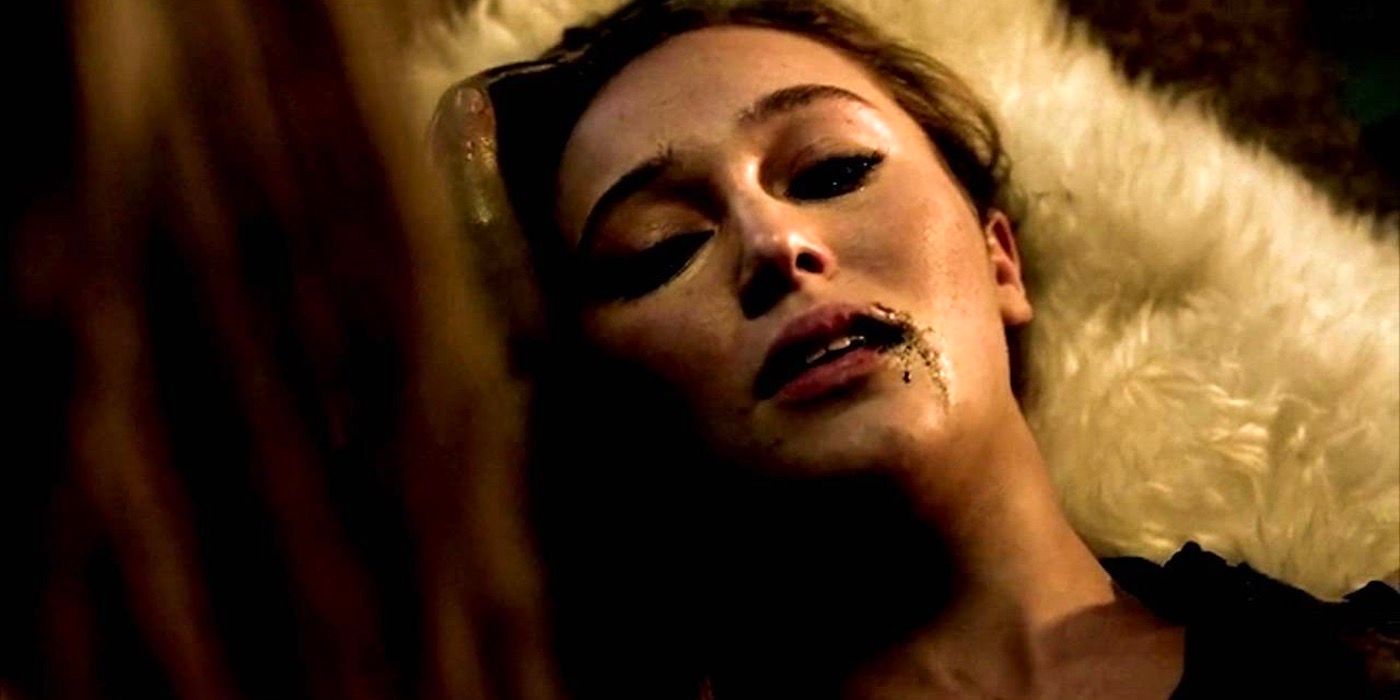
Hollywood's bury your gays trope has been long used on television and is a source of upset for queer audiences and those who want to see smarter, more thoughtfully inclusive storytelling in TV shows. The "bury your gays" trope first evolved in late 19th-century literature , first following a very specific arc of one half of a gay couple dying and the other realizing afterward that they were never gay, often ending up happily married in a heterosexual relationship by the end of the book. It was a not-so-subtle message to reinforce the idea that being queer was a sin, and sinners don't deserve happy endings or to escape punishment. The "correct," moral ending was one in which a homosexual character died.
It was a not-so-subtle message to reinforce the idea that being queer was a sin, and sinners don't deserve happy endings or to escape punishment.
With the explosion of other, newer mediums in the 20th century, the bury your gays trope evolved, particularly on television. Instead of being such a specific arc, the trope expanded to cover the broader, equally troubling pattern of queer characters, usually in relationships, being killed off, thus reinforcing the stereotype that gay characters are more expendable than heterosexual characters . While queer representation has been – too slowly – getting better, there have still been recent instances of the bury your gays trope really upsetting audiences, especially when combined with queerbaiting storylines.
CBS' gripping series Tracker has scored an early renewal for season 2, and there are already a ton of exciting details about the new episodes.
Arguably, it was CW's sci-fi show The 100 that sparked conversation about better queer representation and put a new focus on the harmful repercussions of the bury your gays trope. The show's handling of the death of fan-favorite character, Lexa, who happened to be a lesbian, was a horrifically botched storyline that sparked a call for an examination about how queer love stories played out on TV. After a lengthy time queer-baiting the audience, The 100 finally saw Lexa and her lover Clarke, consummate their relationship, only for Lexa to immediately be killed by a bullet meant for her lover. Since then, inclusive storylines have slowly been getting better, but TV shows like Tracker need to take care to ensure they're not backsliding.
According to CBS, Tracker 's first seven episodes averaged 19 million viewers across broadcast and streaming per a 35-day viewing window.
How Tracker Season 2 Can Write Teddi Off Instead
There are plenty of ways to cleverly incorporate her exit into the show.
Death is not the only meaningful way to write a character out of a TV show. Beyond that, however, there's nothing in the reports that says Robin Weigert will never be coming back to the show; the only thing that was clear was that she would no longer be a series regular. While she's likely done with Tracker for good, it still leaves the door open for her to return , just perhaps not in a starring role as before. It's even possible that she'll step away for a season, but may come back as a series regular in season 3 or beyond.
Even if Teddi doesn't return, there are plenty of ways for Weigert to gracefully exit Tracker without the show caving to the lazy trope of burying one of its two gay women.
However, even if she doesn't, there are plenty of ways for Weigert to gracefully exit Tracker without the show caving to the lazy trope of burying one of its two gay women. The show incorporates texting and video calls already; it would be really easy to continue Teddi's presence in the show via technology without having to show her. While Teddi was an important part of Colter's operation, she didn't get that much screen time, which would make it easier to keep her character in the show without it being that jarring. With the show seemingly setting up a new storyline for Velma, it would be easy to shift the focus to her and keep Teddi in the background through inventive means.
If Tracker wants to get more serious, it can have Teddi and Velma divorce, with Teddi going off to pursue other avenues. The divorce doesn't even have to be part of it; it's entirely possible that Teddi could have business that takes her away from the work of being Colter Shaw's handler, instead leaving it to Velma, Reenie, and Bobby. The three of them would be more han capable of handling things, especially with Reenie having quit her job as a lawyer at the end of season 1. Regardless of how Tracker handles Teddi's exit, there are far better ways to deal with it than to unceremoniously kill her off, a fate that she, and queer audiences, don't deserve.
Tracker (2024)
Not available
Based on the novel by Jeffery Deaver, Tracker is an action-drama series created for CBS by Ben H. Winters. Traveling across the United States in his RV, Colter Shaw is a lone wolf with a fractured past who spends his time helping solve mysteries and police cases in every town he crosses.
- Skip to main content
- Keyboard shortcuts for audio player
All Songs Considered

- LISTEN & FOLLOW
- Apple Podcasts
- Amazon Music
Your support helps make our show possible and unlocks access to our sponsor-free feed.
Nick Cave on the encounters that brought him to 'Wild God'

Nick Cave and The Bad Seeds' latest album, Wild God , is out August 30. Megan Cullen/Courtesy of the artist hide caption
Nick Cave and The Bad Seeds' latest album, Wild God , is out August 30.
On August 30, the Australian-born rock titan Nick Cave will release Wild God , a new album with his band The Bad Seeds. It's a high point in Cave's career, and NPR Music's Ann Powers spoke with him about the struggles — personal, musical and religious — he faced on the road to making the album. Wild God is filled with songs about encounters with the divine, which does not always take a benevolent form. And it follows a decade in which Cave, having publicly faced tragedy in his own life, has evolved from post-punk's louchest fallen angel into a revered figure among his audience in a new way: a dignified seeker whose courage and wisdom resounds beyond musical boundaries thanks to advice he has shared in interviews, writing projects and public appearances. Perhaps it's not surprising that so many of the songs reckon with the moment of revelation or transformation, or the demand for conversion from a As for the state of his own religious conviction, Cave says that the struggle is the point: "I would say I'm in the process of conversion," he tells Powers. Wherever he is on that road, he's found something ecstatic to share. Click here to read a transcript of this interview and hear songs from the album Wild God.
Navigation Menu
Search code, repositories, users, issues, pull requests..., provide feedback.
We read every piece of feedback, and take your input very seriously.
Saved searches
Use saved searches to filter your results more quickly.
To see all available qualifiers, see our documentation .
- Notifications You must be signed in to change notification settings
Write any bash with only the punctuation characters
meithecatte/bashfuck
Folders and files.
| Name | Name | |||
|---|---|---|---|---|
| 3 Commits | ||||
Repository files navigation
bashfuck is a dialect of bash where you only use the ASCII special characters. No letters, no numbers.
To help you with your bashfuck journeys, this repository includes a handy utility: a bashfuck encoder.
Limitations
- depends on the precise wording of bash error messages, and as such doesn't work if your locale is set to something other than English
- unfortunately, there is no bashfuck-compliant way to capture the stderr of a command directly to a variable. As a workaround, bashfuck first writes it into a file, and then reads this back. By default, this file is ._. in the current working directory. Note that if this file exists, it will be overwritten.
- I think the decoding code I wrote might be quadratic. Shouldn't be too hard to fix. PRs welcome!
How it works
I don't really feel like writing this section right now. Go forth, human! Examine the cursed artifact! You'll certainly learn something about bash that you didn't know before.
If you want a hint, take a look at encoder-payload.sh — though note that, due to the self-reference, this won't work properly when not itself encoded.
Other considerations
- please make sure to observe the terms of the license
- join us in ##bash-crimes on libera.chat
- Shell 100.0%

John Aprea, 'The Godfather Part II' and 'Full House' actor, dies at 83
Actor John Aprea , best known for his roles in "The Godfather Part II" and "Full House," has died. He was 83.
Aprea died Aug. 5 in Los Angeles of natural causes, his manager Will Levine confirmed to USA TODAY on Sunday in a statement.
The New Jersey-born actor, the son of Italian immigrants, made his film debut in the 1968 crime thriller “Bullitt,” which starred Steve McQueen, Jacqueline Bisset and Robert Vaughn. He went on to appear in several movies and TV series throughout the early ‘70s, including “The Grasshopper” and “The Dark Side of Tomorrow.”
Alain Delon dies: French icon dubbed 'the male Brigitte Bardot' was 88
Aprea joined “The Godfather” family in 1974 when he landed a role in “The Godfather Part II,” a sequel to Francis Ford Coppola’s 1972 crime drama starring Marlon Brando, Al Pacino and James Caan. Aprea portrayed a younger version of Sal Tessio, played by Abe Vigoda in the movies.
Shortly after getting the part, Aprea reportedly called Vigoda for advice on playing the character, Levine said. Vigoda replied to him, “I don’t know what I did. Just have a good time, kid.”
“The Godfather Part II” earned $47.8 million at the box office and won a whopping six Oscars at the 1975 Academy Awards, including best picture.
Following his “Godfather” success, Aprea appeared in a number of TV series and films, including a leading role in the family comedy “The Montefuscos” (1975) and the Bob Marcucci biopic “The Idolmaker” (1980).
Peter Marshall dies of kidney failure: 'Hollywood Squares' host was 98
From gangster gruffness to baby talk, Aprea is also known for his role as grandpa Nick Katsopolis in the sitcom “Full House.” Aprea played the father of John Stamos’ character, Jesse Katsopolis, for several episodes from 1988 to 1991.
Aprea reprised his “Full House” role in the show’s Netflix reboot “Fuller House” in 2017.
Most recently, Aprea had a recurring role on the Peacock soap opera “The Bay,” playing Jack Madison from 2020 to 2023.
Aprea is survived by longtime wife Betsy Graci, his daughter Nicole and stepchildren Marika Parker and Valentino Graci.

IMAGES
COMMENTS
Generally, a character bio includes basic information about the character, such as their name, appearance, and behavior, but it can also include topics such as backstory and motivations. Bios can look different depending on what they are being used for, the genre of the story, and the other players' preferences.
Level Up Your Team. See why leading organizations rely on MasterClass for learning & development. Whether you're a screenwriter, novelist, or short story writer, using a character bio template can help you create vibrant, believable characters for your narrative.
Just Think AI Prompts for Character Bio Templates. When requesting a character bio template from Just Think AI, provide: Character details - name, age, descriptors, abilities etc. Genre and setting the character exists within. Character role in the story. Any special attributes or details about the character. Supplying this context allows Just ...
Practice writing about your character. Pick another character in your universe. Write about them as another character to get a more comprehensive view of the character. Answering writing prompts can help you brainstorm. Use the character template even if you won't utilize all the traits. Knowing everything about a character helps them feel ...
A character bio template is a shortcut for developing realistic characters. It's the key to creating believable protagonists and antagonists that come alive through your writing. Character bio templates include guiding questions to help you shape your main characters as you write. Remember: writing great fiction starts with writing great ...
To get your characters in shape, I recommend writing a character bio for them. Today, we'll go over character bios, mini character bios, and we'll even give you some tips and tricks to deepen your characters with our character bio worksheet. They're the same as character profiles, so if you came here looking for those, you're in the right place.
2. Physical appearance and characteristics. Well-defined physical characteristics help readers visualize your character, making a more engaging and immersive reading experience. Consider: Build/stature. Height. Hair and eye color. Ethnicity. Clothes/style.
Only the first two sections of the character bio template/checklist (1. Summary and 2. Tags & Quirks) are needed for most characters. Delve deeper (elements 3 through 10) for just a few key characters. Don't fill out a "form" about your character.
1. Construct the character's outer appearance. To be able to identify a criminal, detectives build a painstakingly thorough file of said criminal's physical characteristics. That's the goal of this section, which covers the "skin" of your character: everything from their outer appearance to the way that they speak.
Steps to Create a Character Profile. Here is a step-by-step procedure for creating a character bio: 1. Understand the Basics. Before starting, first, find out which of your characters will need a character profile. Then decide on the basics. It will be a long process and you'll go through a lot of information.
Begin crafting your character bio by starting with the basics. Your character's name (and nickname/s), gender, age, nationality, race and where they live. Physical details including height, weight, build, eye colour, hair colour, and characteristics like any scars, birthmarks, tattoos and piercings. This essential background and the physical ...
Writing a character bio is a good exercise for writers because it forces them to think about what makes a character unique. It also gives them practice thinking about different aspects of their character's personality, such as their likes and dislikes, hobbies, and goals. These aspects define the motivations of your characters.
This is where you make note of everything you know about your character physically, which can include things such as their eye and hair color, racial heritage, age, height, weight, and clothing ...
How to Write Character Bio: A Comprehensive Guide. Creating compelling and memorable characters lies at the heart of successful storytelling. One of the most effective ways to develop deep, well-rounded characters is by crafting a character biography. A character bio is an essential tool that helps authors understand their characters on a ...
Ultimately, they must be crafted in the best way for the writer. And most importantly, they need to be accessible and easy to understand. Some ways of creating a character bio include…. On a blank document: Probably the most common way. This is easy to execute, follow and allows for you to let rip with words.
A character biography is a reference sheet that tells you everything you might need to know about your character, for any scene that you write. A character bio includes information on your character's background, personality, day-to-day life, appearance, and more. While not all this information will make it into your story, it's still ...
Successful characters are multi-dimensional with distinctive physical attributes, emotional traits, appearances, personalities, intelligence, vulnerabilities, emotions, attitudes, idiosyncrasies, and hopes and dreams. Writing successful characters also means digging deep into their past and present. There are several ways in which to delve into ...
What's a Character Bio? So, creating a character biography is quite important and will help you to build your story. Of course, you want to start writing. But take this break and start by defining the attributes, features, and characteristics of your characters first. Trust me, it will help you to write a better story. So, let's dive into ...
Write a scene from their perspective. Draw or describe their house in detail. "Interview" your character, answering questions in their voice. Write their resume. Write a few journal entries in their voice. Ask to shadow someone who has the same job or hobbies your character has. Go interview someone with similar experiences.
1. Gather the information you need to know. Before you write anything, you need to know who or what you're writing about. The more specific you are, the more personalized you can make your content. Here's our suggestions for writing a character bio: Character name: [character's name]
Writing a character biography is crucial and will determine the development of your novel or short story. Of course, you want to begin writing right away. As a matter of fact, everything would go on in a more organized way if there is a plan or thought behind the whole idea. So, you should take a break and begin by outlining your novel or short ...
5. How can a character biography improve my writing? A character biography provides a solid foundation for your writing. By knowing your character's background and motivations, you can create more authentic dialogue, consistent actions, and believable character arcs. It also helps you avoid inconsistencies or plot holes that can weaken your ...
Conclusion. By developing a backstory on the strong foundation supplied by the script, and then by adding incidents that are relevant to the journey of the character and are packed with significance by virtue of being a "peak" or a "valley", the actor can stimulate her imagination in fruitful ways and propel her into the work on the role.
Not only did the perpetrator falsify the document by adding my name as author, but he/she searched the internet to locate, copy, and attach my bio and a 20 year old photo of me in uniform.
Bio: "Give me some sons and I'll give you my heart, big plus if you get on well with my daughter." Anthem:Killing Me Softly With His Song - Fugees, ft. Lauryn Hill
Write an article and join a growing community of more than 188,500 academics and researchers from 5,027 institutions. Register now. Editorial Policies; Community standards;
Tracker is set to lose its first major character for season 2 and to do her exit justice, the show really needs to avoid one toxic and overused TV trope. It was recently reported that Robin Weigert's character, Teddi Bruin, will be leaving Tracker ahead of season 2. It's a shocking bit of news considering the show is only just past its first season, a season that was hugely successful with ...
And it follows a decade in which Cave, having publicly faced tragedy in his own life, has evolved from post-punk's louchest fallen angel into a revered figure among his audience in a new way: a ...
You signed in with another tab or window. Reload to refresh your session. You signed out in another tab or window. Reload to refresh your session. You switched accounts on another tab or window.
Shortly after getting the part, Aprea reportedly called Vigoda for advice on playing the character, Levine said. Vigoda replied to him, "I don't know what I did. Just have a good time, kid."